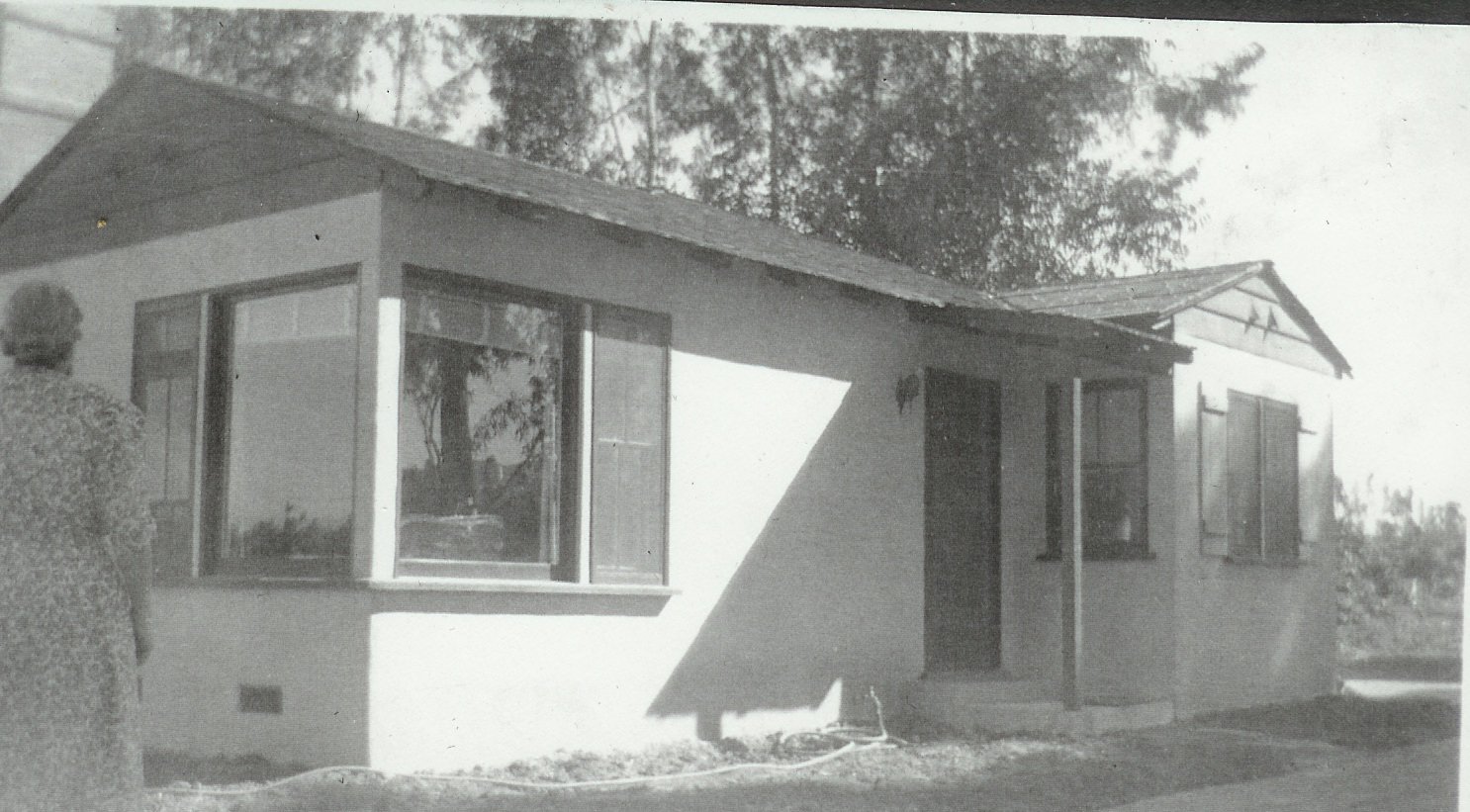
The Lake House

The only thing I can remember bringing from the folksí house was my dresser,
which is still in my closet today. Neither Barbara nor I have any memory of
buying a mattress, or front room furniture, but those things were all in the
house by the time we moved in. The two things we didnít have, and couldnít find,
were a refrigerator and clothes washer. We kept a few things in Dorothyís refrigerator.
Barb did some wash by hand, and took some over to Dorothyís, or Mom Wilsonís.The
wedding was at the old Saint Rose of Lima church in Simi town. Dad Wilson made
Barbaraís corsage of orange blossoms. Uncle Lyn Hess took some wedding pictures,
then off to the reception at my folksí house. There was not much available to
buy in the stores for wedding gifts. We got Pyrex, Pyrex and then more Pyrex!
There were other things, of course, but all the kitchenware was Pyrex. Dorothy
told us that she wanted to get us a set of silverware, but that would probably
have to wait until after the war was over. Barb and I were in Ventura shopping
for something or other when we found a nice set of silver in a hardware store.
We decided to buy it, since it was the last set they had, and no prospect of
getting more. When I told Dorothy, she was delighted, and insisted on paying
for it.
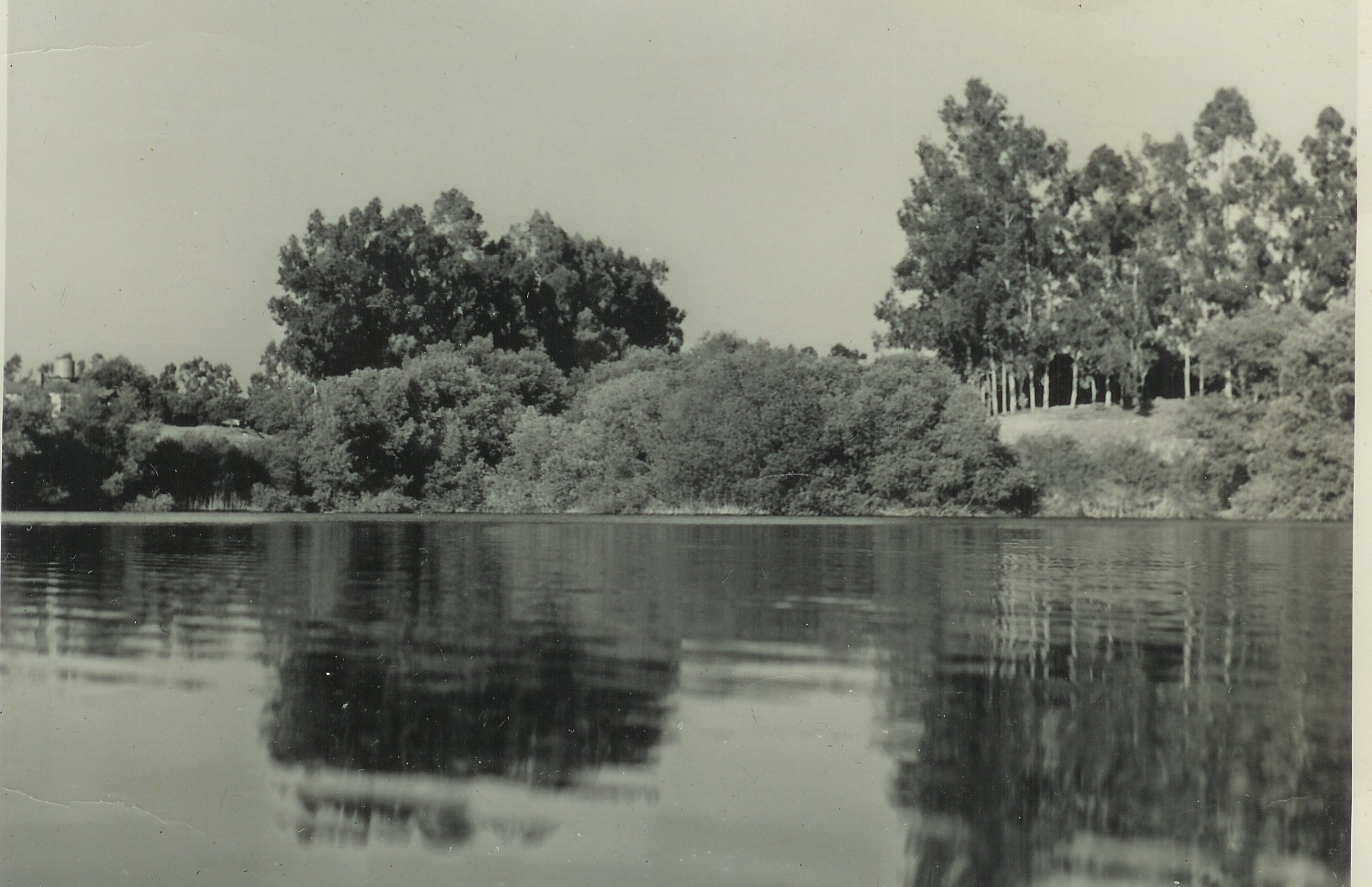
Sinaloa Lake, looking towards the house
Tom had arranged with Mr. McFadden for us to use the McFadden cabin in the San Bernardino Mountains north of Redlands for our honeymoon. I had been there with Jean and her husband, Bob McFadden, a couple of years earlier. It was COLD up there. I spent a good deal of time gathering firewood for cooking and heating. I think we only stayed for three daysówe were anxious to get into our own little house! When we arrived home we found that Bob Cannel had gathered the ranch crew together to plant a large vegetable garden for us. That was a very nice gift!Mom Wilson raised Cocker Spaniel puppies for show and sale. She gave us a puppy named Punkie. When Danny got old enough to crawl around on the floor Barb worried about having a dog in the house, so we gave Punkie back to Mom. It was several years before we got another dog.
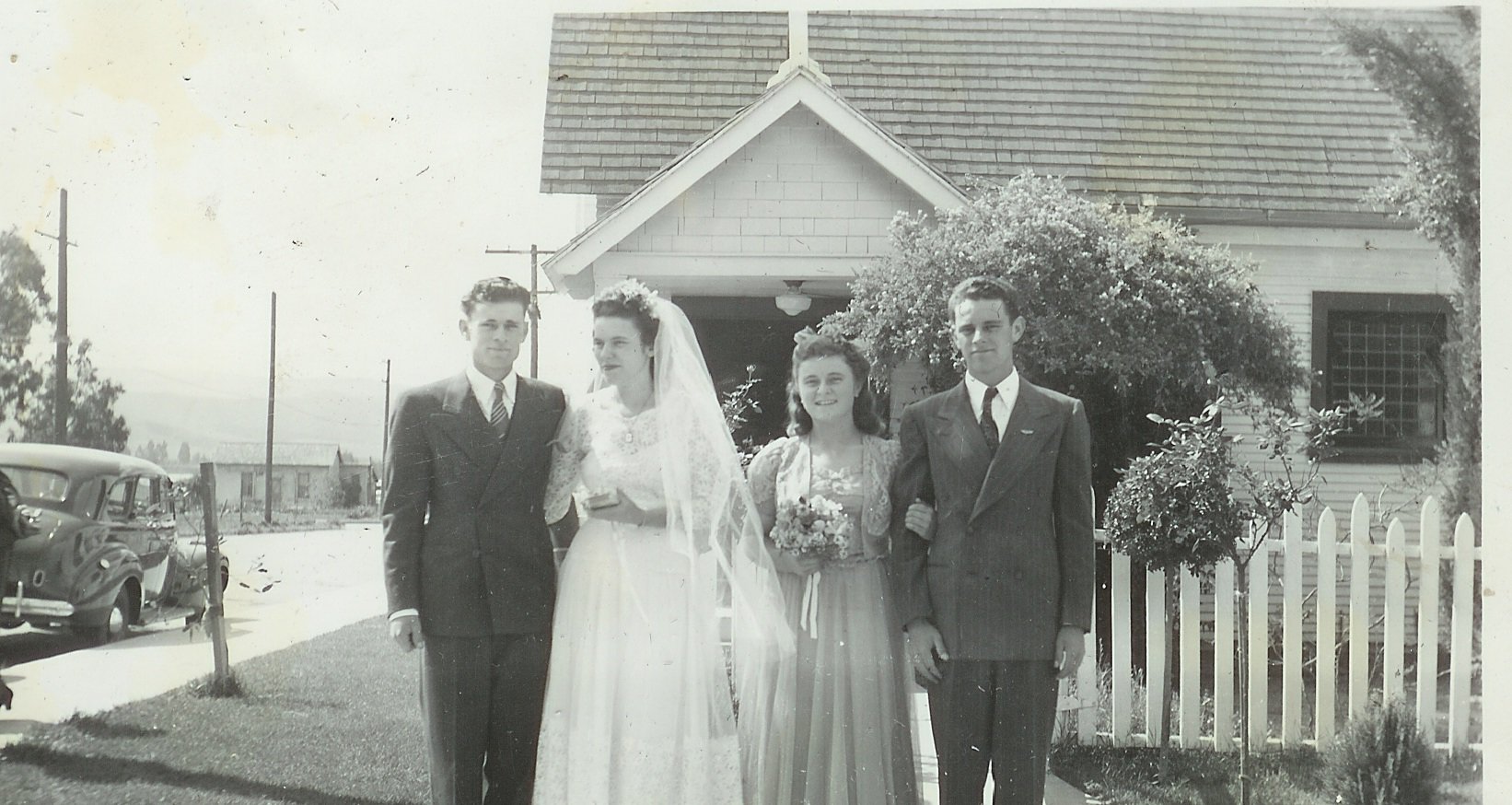
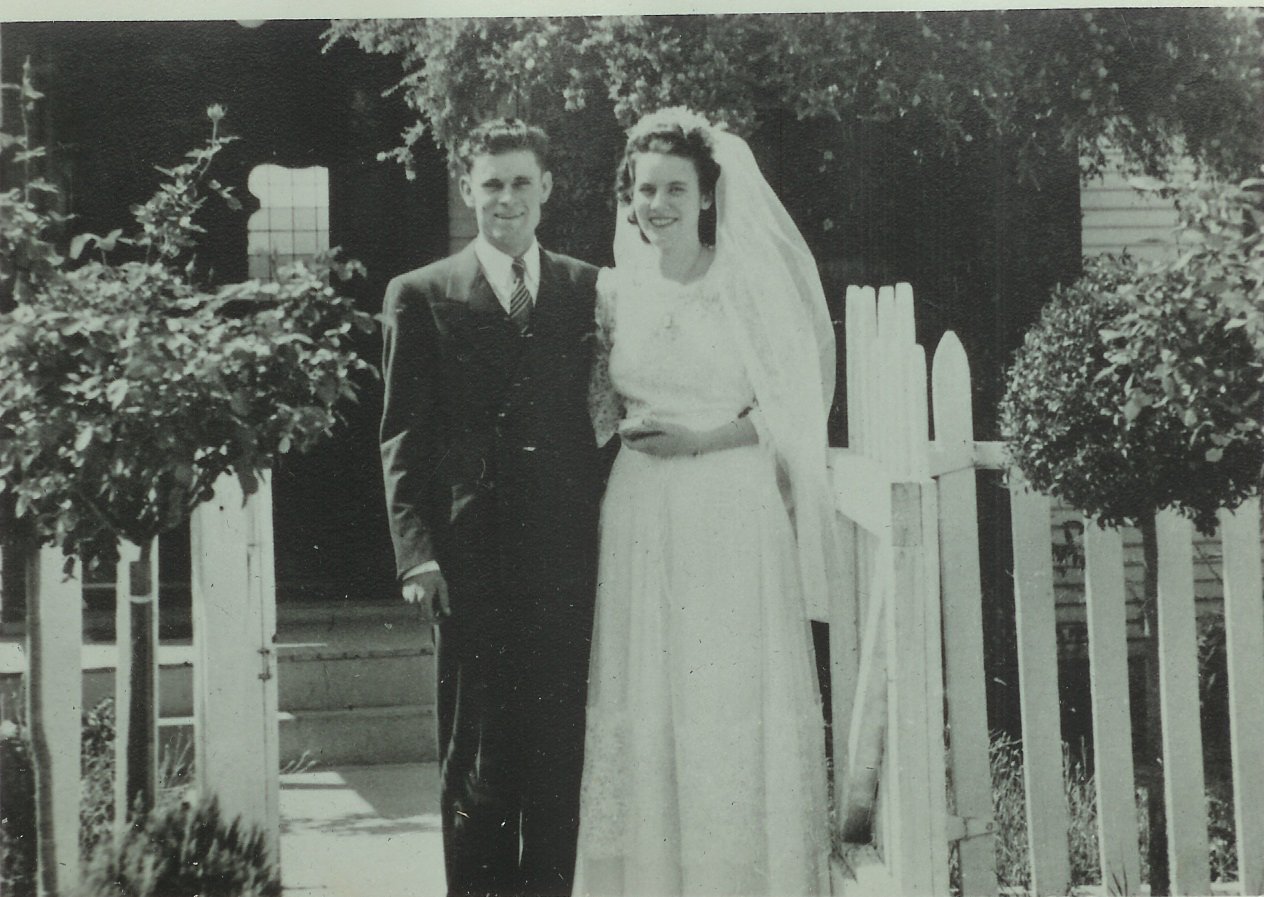
April 10th, 1943
In those days it was common for all the little stores in Simi to run charge accounts for their customers. We had an account at Mingledorfís Grocery in Simi. We paid our bill once a month. I think it never went over $30 per month. We also started a checking account at the little bank in Moorpark. During that first summer I worked as irrigating foreman on the ranch. In the fall I switched over to truck driver. Sinaloa Ranch owned two Ford trucks, a 1936 and a 1937. Alan and I used the trucks to deliver grapes to the Utt Juice Company in Tustin. This was a run of about 90 miles each way. One of the routes we used went past the large Sears Roebuck store in East Los Angeles. On one of my return trips I saw what appeared to be appliances for sale in the parking yard. When I investigated I found that they had a number of electric refrigerators for sale. I managed to make a deposit on one with the few dollars I had in my wallet. On my next return trip I gave Sears a check for about $180 and took home a nice refrigerator. I was the man of the hour with Barbara, and probably Dorothy as well. Now she had her refrigerator back for her own family!Barbara was a good cook, then as now. There was only one little shortcoming. One of her specialties was a lemon meringue pie. They were very good. The problem came when she decided to make me an apple pie. Since she had never made a fruit pie, she baked the crust first as she would for a lemon or chocolate pie. As you can imagine, the results were less than stunning! Iím afraid that I teased her just a wee bit too much about this mistake. Finally, she just said, "fine, from now on you can make all the pies!" And that, dear friends, is how, for many years, I became the designated maker of pies in the household! It was not for nothing that my mother had taught me to make piecrust and bake pies! We joined a group of couples to play "500" once a month. "500" is sort of like bridge, but without the deep thinking, and no one takes it too seriously. There were six couples in all. We rotated hosting the affair. After cards we served dessert of some kind. There were signs that Barbaraís pregnancy was in trouble, so I took her to a doctor in Ventura for a pre-natal checkup. When she came out of the office she was in tears. The doctor had discovered a large cyst in one of her ovaries. It was larger than the baby in the other ovary. He said that it would have to come out, and that she would almost certainly lose her baby. He sent us directly to a surgeon, also in Ventura, Dr. Homer. He confirmed the first diagnosis, and also told us that the chances of her keeping the baby were rather slim. We really didnít have a choice, the surgery had to be done. He arranged for surgery the following week at Foster Memorial Hospital in Ventura. Dr. Homerís hands were terribly crippled, from arthritis, I suppose. In spite of that, he was regarded as the best surgeon in the area.The surgery was done and Barbara did well. Best of all, the baby was not lost! Dr. homer did not normally deliver babies, but Barbara pleaded with him until he agreed to make an exception for us, just in case there were complications. During the evening of December 4th Barb started having contractions. We gathered up some of her things and went to her folks in Moorpark. Her contractions kept getting stronger and soon we were off to the hospital, taking Mom Wilson with us. Sometime in the wee hours of Dec. 5th Daniel Edward Robertson was born. He weighed a healthy eight pounds. Considering the dire predictions of a few months earlier we considered him to be a miracle baby. Of course, all babies are miracles! The doctor wanted Barbara to stay in the hospital for ten days. All of you who know and love her already know that was not going to fly! He finally let her come home after five days, on the condition that she make the trip in an ambulance. I still remember that the thirty-mile trip cost thirty dollars. That represented more than a weekís pay, but it was well worth it to have the family together in our own house! The next day I gave Danny his first bath at home. I donít recall that either Barbara or I had any problem taking care of him. It all seemed to come naturally. Of course we had two good grandmothers close by when we needed help or advice.
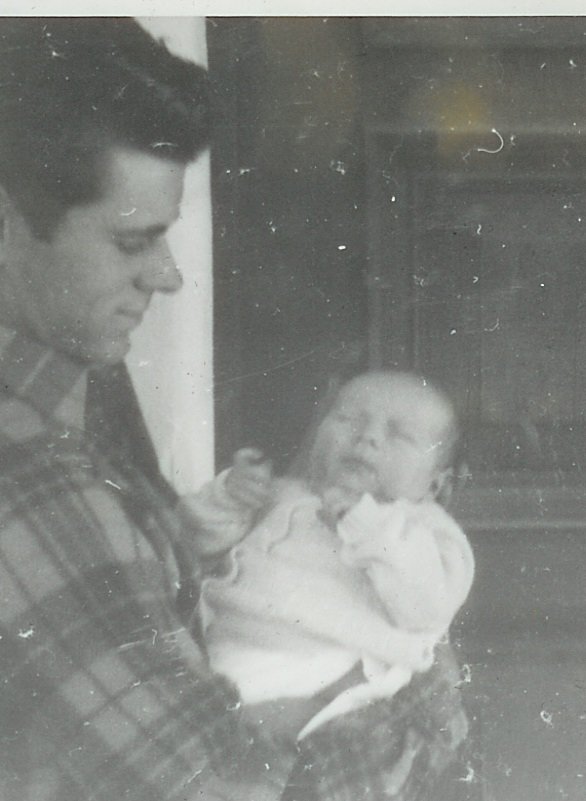
Dan, 3 weeks
There is something that I have thought about many times over the years, and
I still think about it. Can there be anything more emotional in the whole world
than to hold a tiny infant in your arms, knowing that he or she will be totally
dependant on you for survival for many years? Then that infant looks up into
your eyes, and seems to say, "alright, Iím safe here, this is someone I
can trust. I think Iíll take a little nap now". Itís all emotions rolled
into one. Love, of course. The miracle of a new life. The awesome responsibility
you are facing. Pride in having been given that responsibility, and some apprehension
about your ability to meet all the needs of your child. Of course, it only takes
one smile from that child to wipe away all your apprehensions.
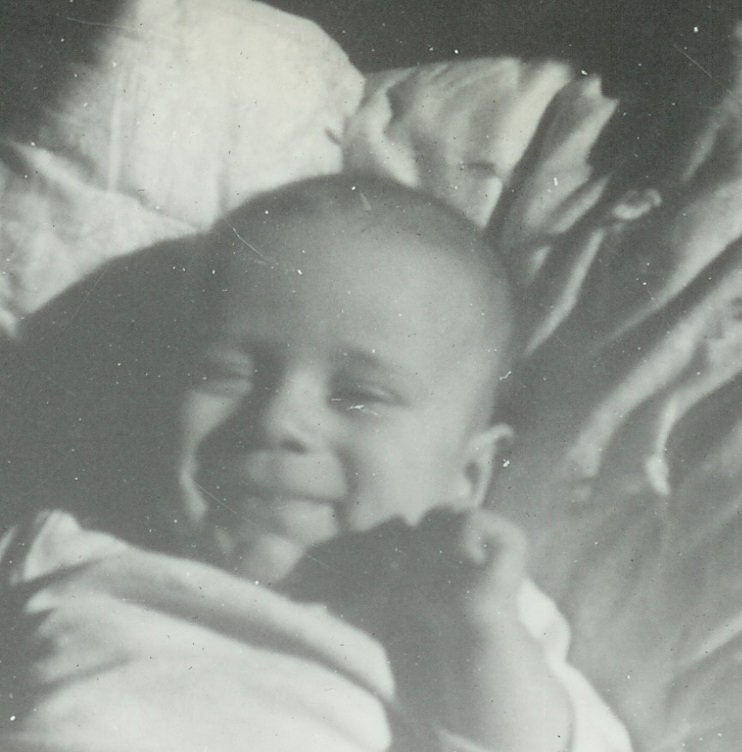
Dan, 3 months
It soon became apparent that the Plymouth coupe we owned was not a family car.
Tom arranged some sort of three-way trade where I traded in the Plymouth, the
folks got a newer used sedan, and we got their 1941 Ford sedan. I should mention
that there were no new cars available for several years because of the war.
A man named Lonnie Hull had purchased a small orange orchard from my father.
He built a house that he and his family used on weekends. Lonnie and all the
family were extremely nice people. Lonnie owned a Dodge and Plymouth dealership
in west Los Angeles. I had bought my Plymouth from him, and thatís where we
made the later trade.I think that Lonnie was possibly the best salesman I ever
knew. He was genuinely friendly with everyone, very outgoing, but never pushy.
His store was only a few blocks from the large Farmers Market, at 3rd
and Fairfax, I believe. One day when I was in the store he invited me to go
with him to the Farmers Market. He went there every day. The market had dozens
of permanent stalls and stores. Our first stop was for a piece of freshly baked
pie. Lonnie visited with the owner and the waiter. Ever so gently he found out
if they were in the market for a car, or told them that he had this or that
nice car coming in. We visited every stall, and I swear Lonnie knew everyone
in the market by name, as well as the names of his or her spouse and children.
He asked about a number of people that were ill or otherwise troubled. It was
like everyone in the market was a close friend! I think he made a sale and picked
up a couple of leads while we were there. I doubt very much that Lonnie ever
made an enemy in the whole world. Years later I tried to borrow as much as I
could from his sales technique.
.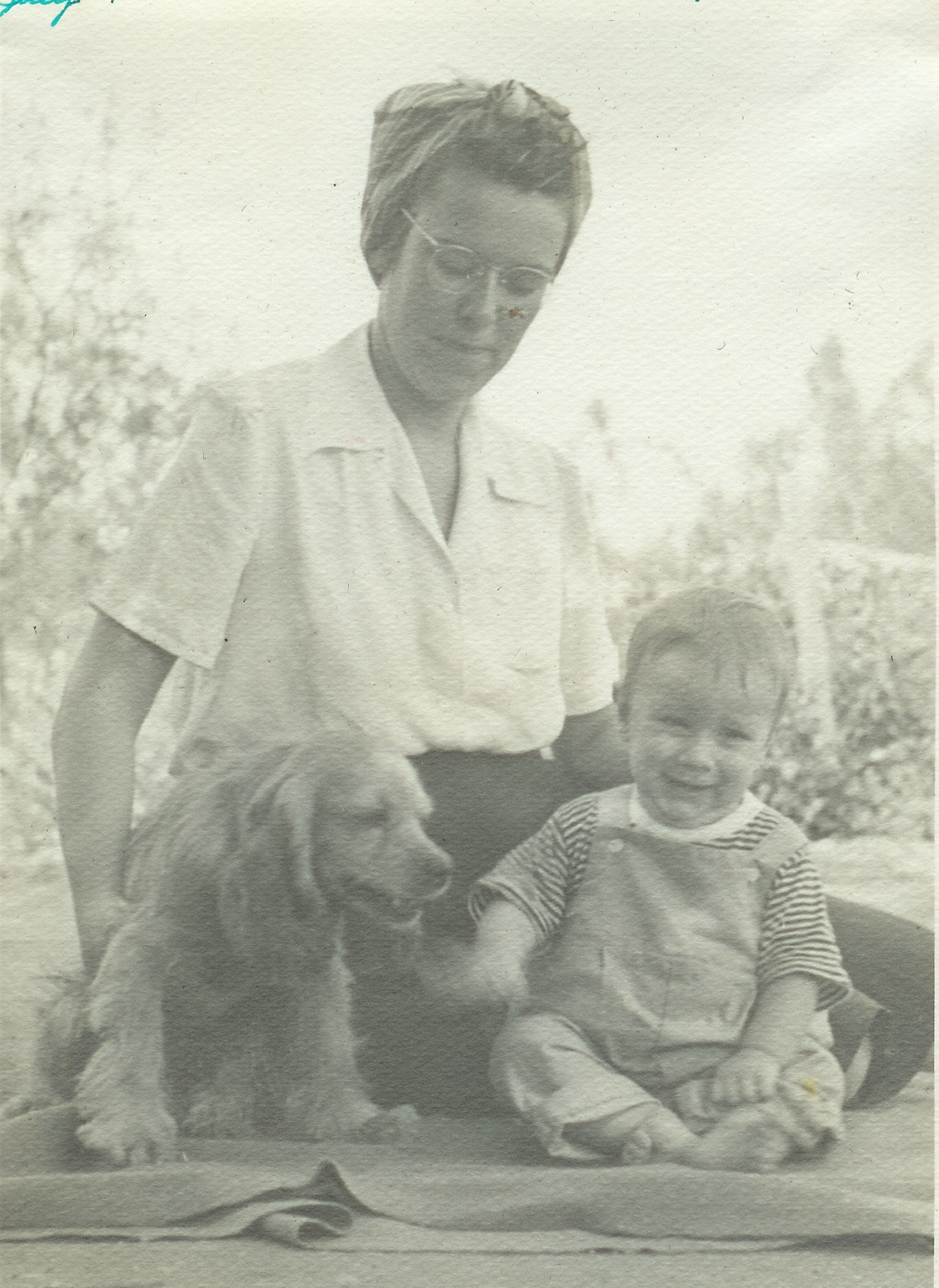
Barb, Dan, "Punkie
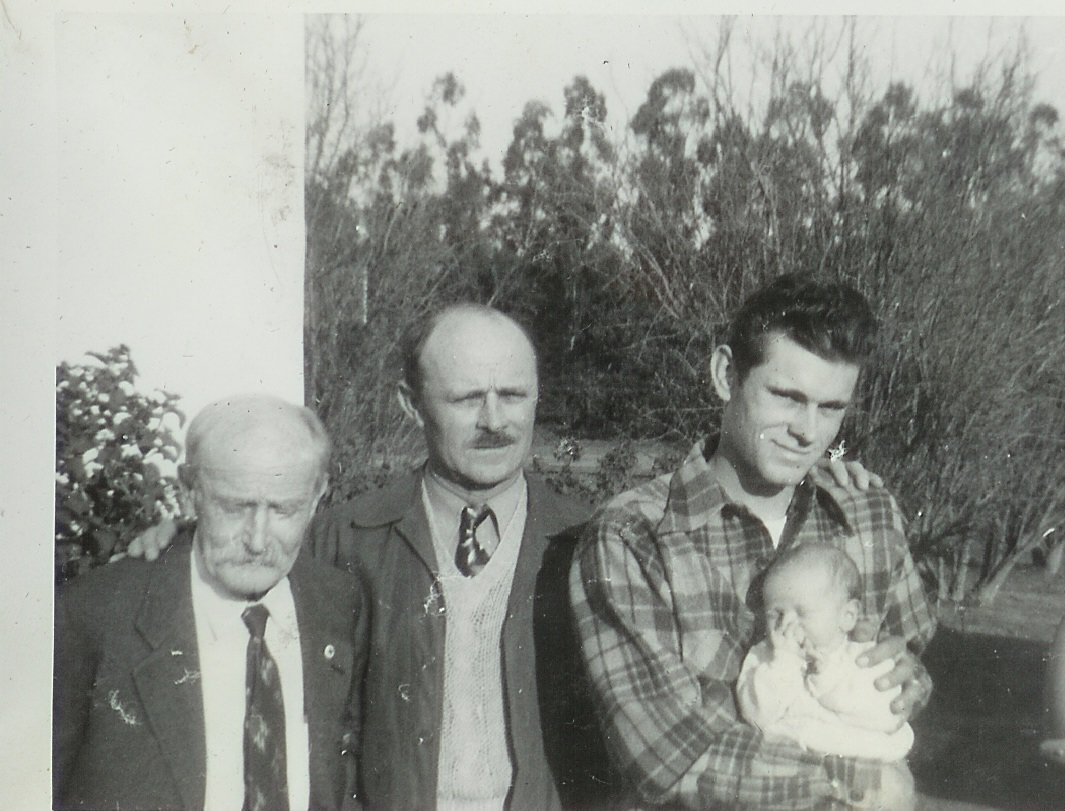
Four generations of Robertson men Luis Tom Leigh Dan
In other stories I have written about life during my time in the Army, and at San Telmo. I will only recount the highlights of those years, the arrival of new family members.
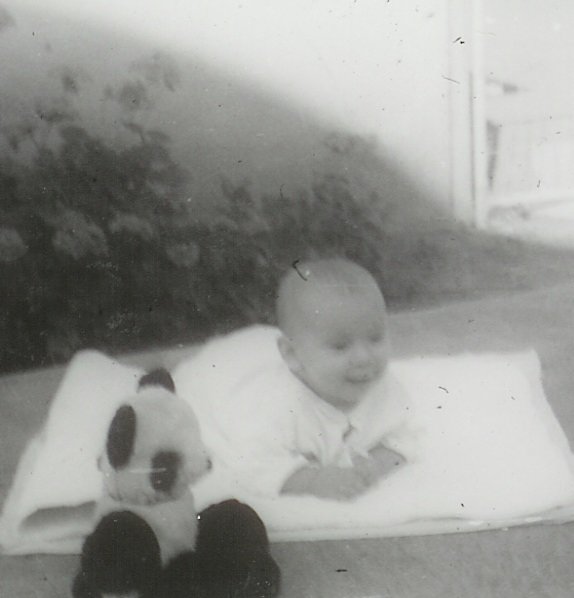
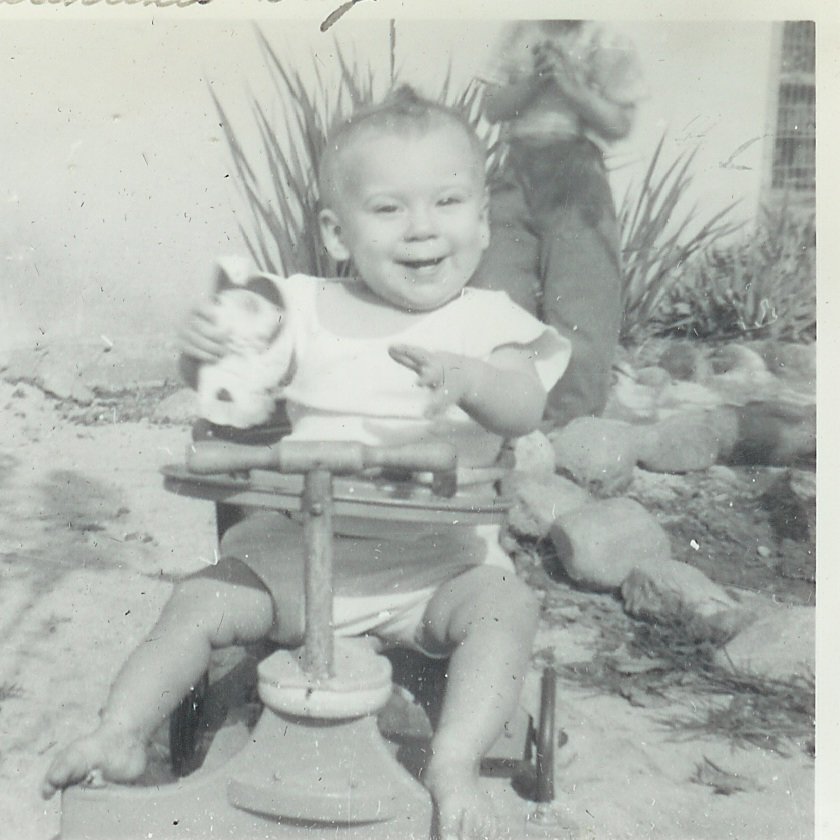
Terry, 2 months,
10 months
Terry Aileen was born April 19th, 1947. She was named for Barbaraís mother, Aileen. We had gone to Dr. Rush, in San Fernando for Barbís pre-natal care. Dr. Rush had taken care of the Robertson and Hess families for many years. He had delivered my sister Merilie and my brother Tom. He owned the small San Fernando Hospital. He was a very kind, gentle man. When it was time for the baby to come, we found out that the Drís younger associate was to do the actual delivery. That was a small disappointment to us, but he did deliver a wonderful baby girl. Danny was so excited to have a baby sister. After we brought her home, he would spend long periods of time by her crib, just looking at her and talking to her.During that time I built a "truck" for Danny. I think I used some old baby-buggy wheels, some scrap lumber and some wooden boxes. He was so proud of his "truck".David Leigh was born a year later, April 20th, 1948. For this baby we went to Dr. Shore in Ventura. David was born at Foster Memorial Hospital, also in Ventura. When he was just a few months old we moved to the Ranch in Mexico. Terry and David grew up almost like twins. For many years they celebrated birthdays on the same day, and shared the same birthday cake. And of course, Barb had two kids in diapers at the same time!
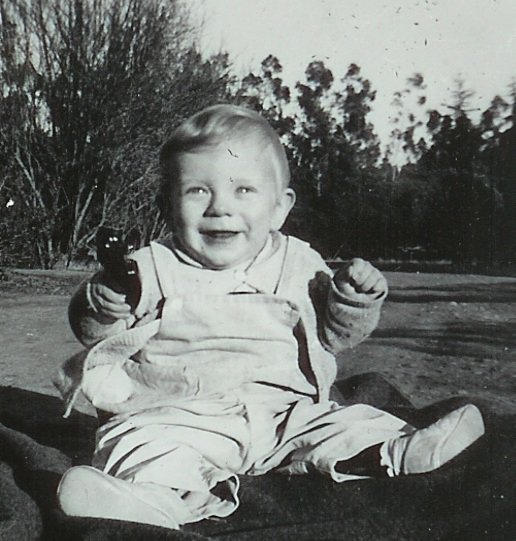
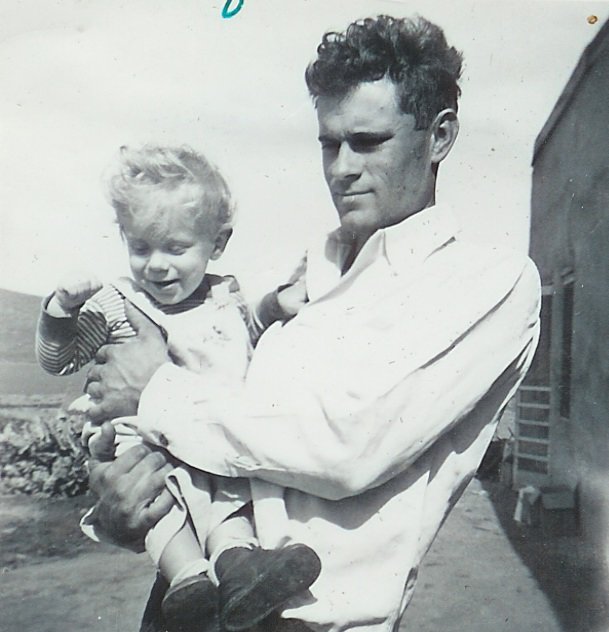
David - David, with his Daddy
Glenn Thomas was born may 12th, 1950. We were living in San Telmo
at the time, but I brought the family back to Simi, so that our child would
be born in the U.S. Dr. Shore told us that the birth was at least two weeks
away, so I went back to the ranch. Glenn was born the next day! I think I got
word the day after that, and hurried back to be with Barbara and the baby. Barbara
kept a journal of that time that tells a more complete story.
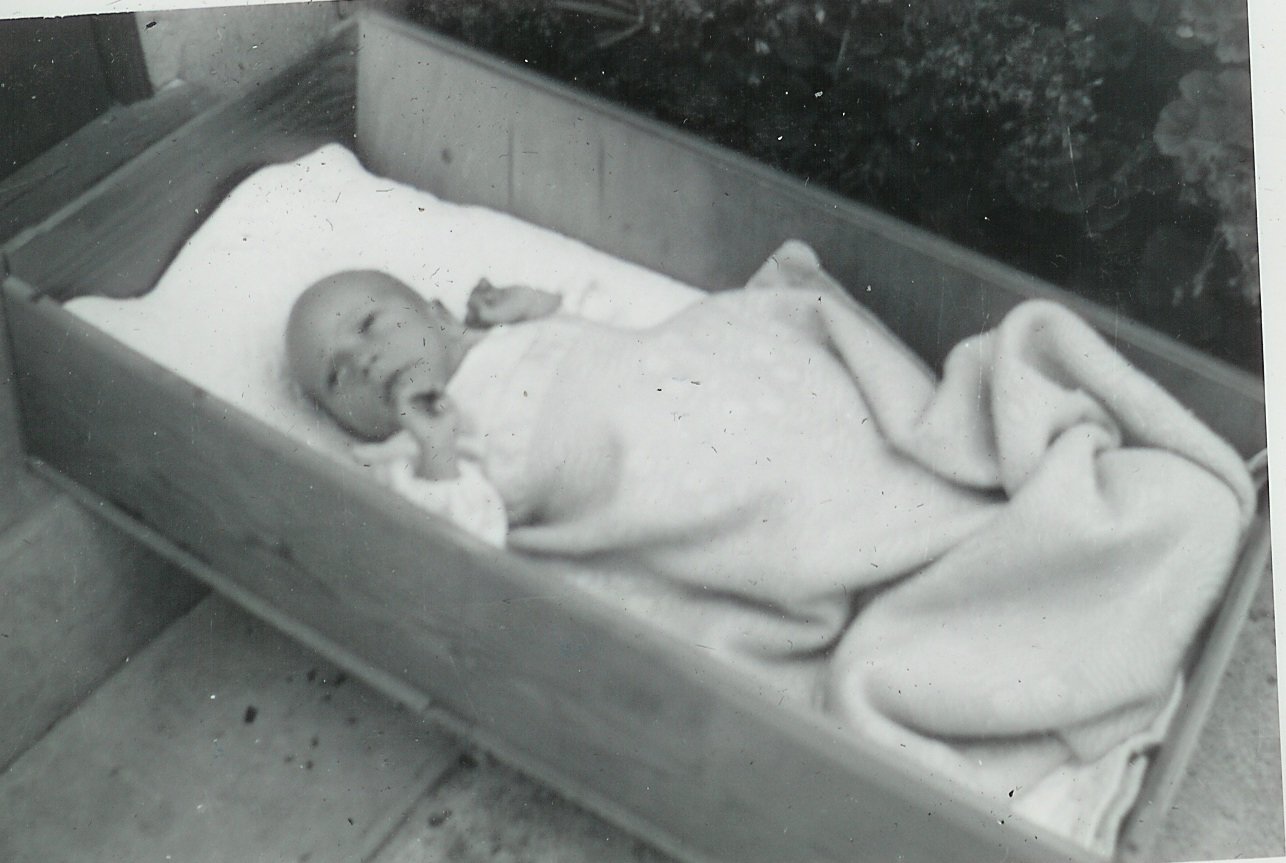
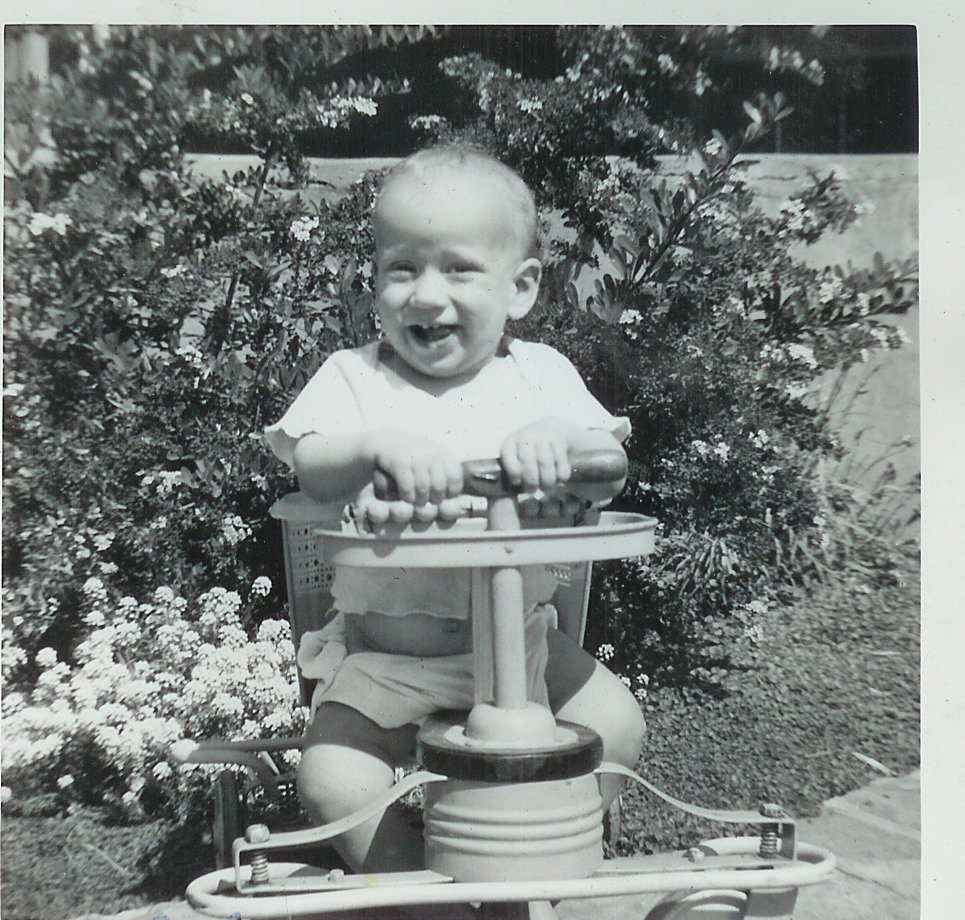
Glenn in his first bed, a dresser drawer
Glenn in the walker
Gerald John was born November 3rd, 1952. By that time the family
was living in the house at 215 Madrona St, Chula Vista, CA. I was still working
at the ranch in San Telmo, and traveling back and forth every week or two.
Dorothy stayed with us for a week or two during this time, to be on hand in
case the baby decided to be born while I was not home. Also, we did not own
a car at that time, so when I was gone, Barbara was on foot, which was not
a good situation. Soon after that Dorothy got a new Ford sedan. She gave us
her 1949 Ford, which was a total surprise to us. That was so characteristic
of my mother. She did so many kind things for so many people that she felt
needed a little boost. And she did it all in a very quiet way. What a dear
person she was!
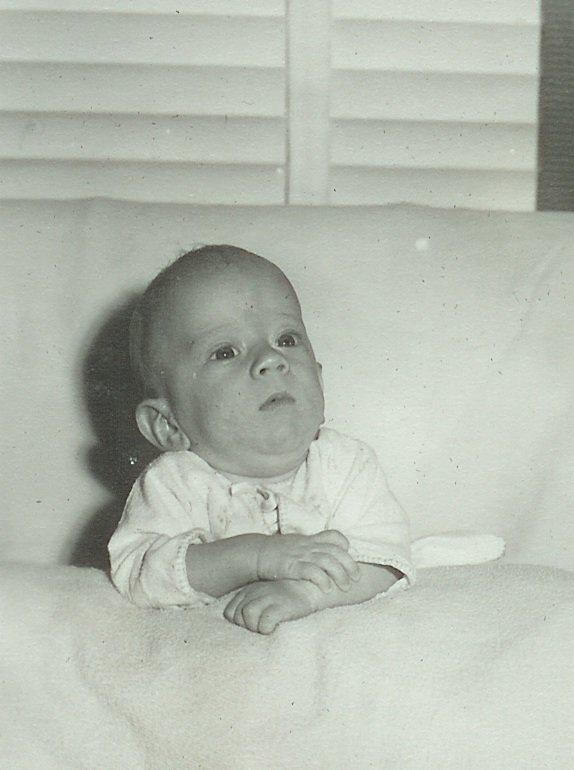
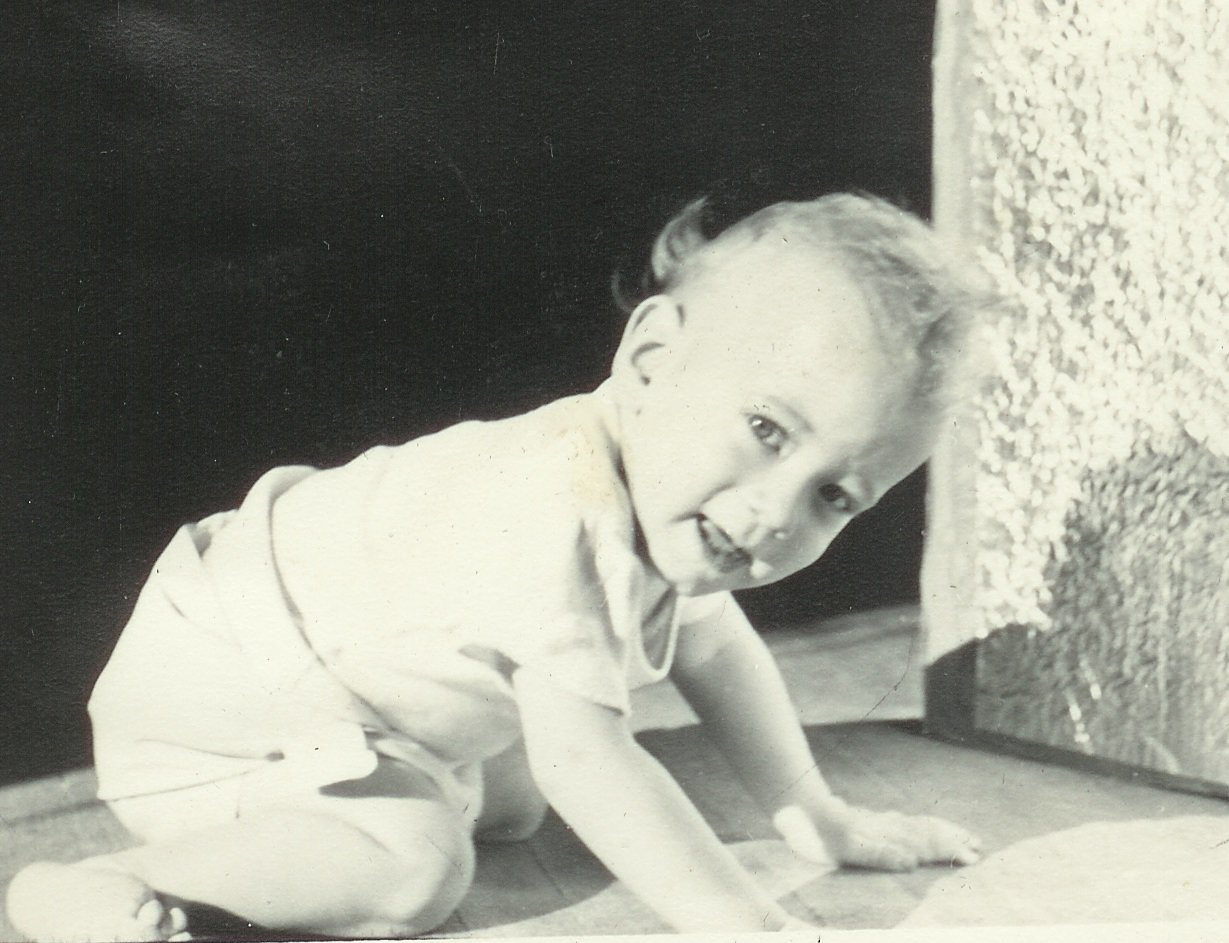
Gerry, six months and one year
We were living in Simi once again when Mary Katherine arrived on October 1st, 1956. Oct. 1st was also Pop Wilsonís birthday, and he always enjoyed celebrating with Katy. She still honors Pop on her birthday. We were all so glad to have another little girl in the family, and Terry especially so! She sort of adopted her as her own!I think that of all the babies, Katy was the easiest to take care of. She almost never cried, and always seemed to be cheerful. She slept in our room, and we always woke her up when we went to bed, sometimes just to visit with her. She always went right back to sleep. Always, that is, until she was nine months old. One night she decided she did not want to go back to sleep, and cried when we turned the light out. The next day we moved her crib to Terryís room! Howís that for tough love! Of course, Terry was delighted!
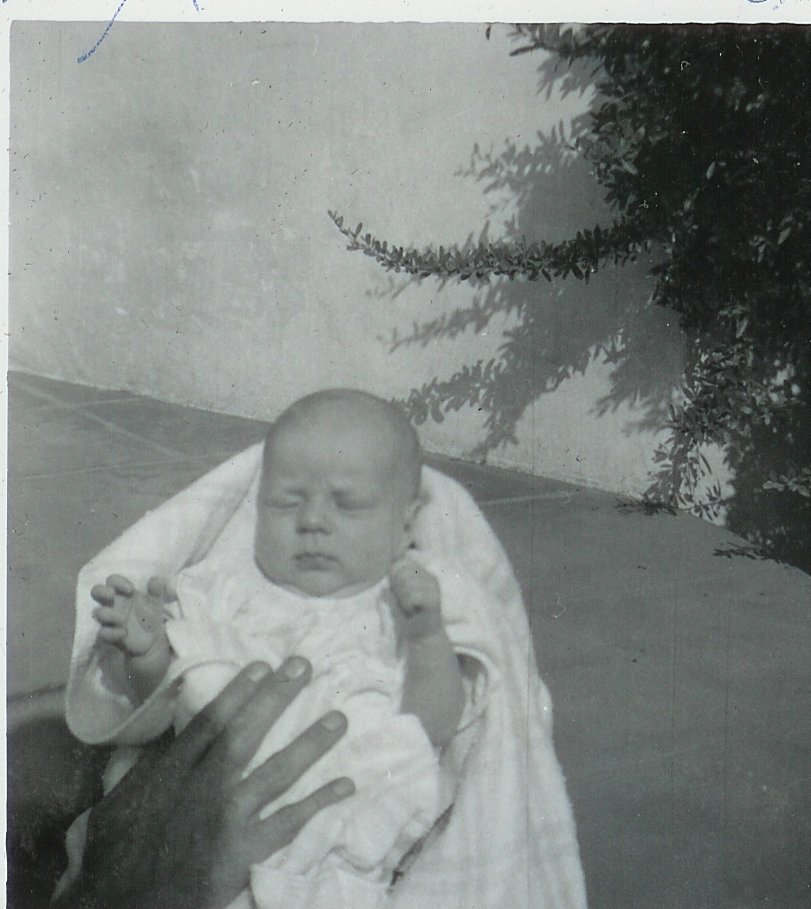
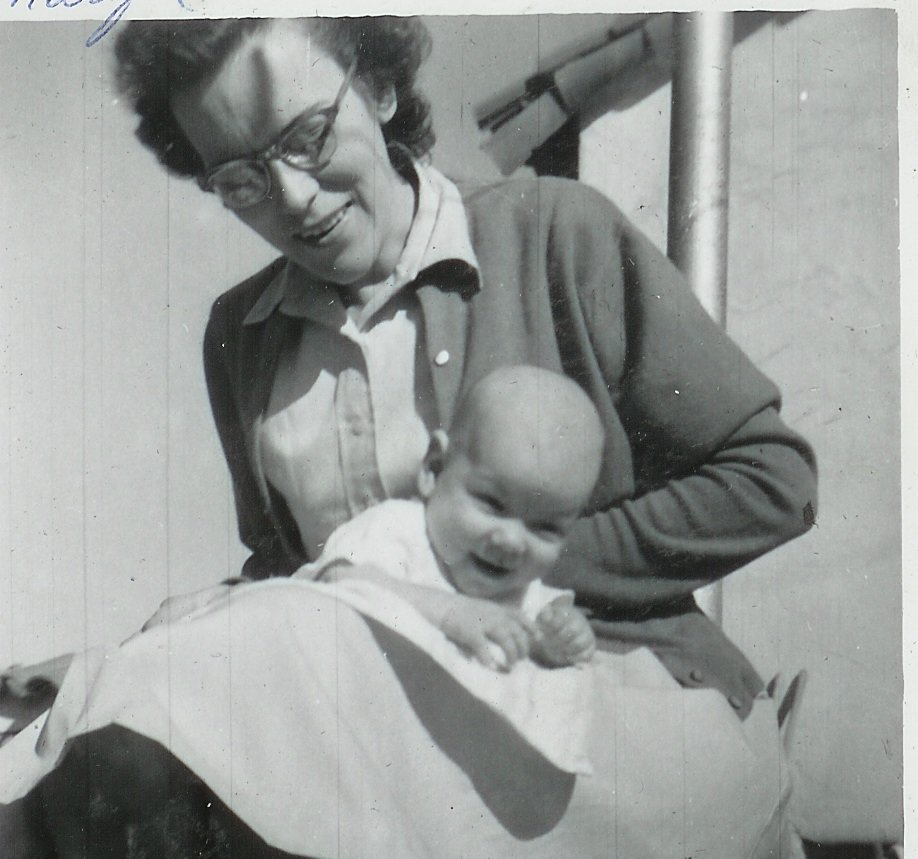
Mary K, three weeks Barbara and Mary K, four months
When we moved back to Simi, we moved into my folkís house, what our kids call the "Big House". We had intended to build our own house, but the folks had settled permanently in Mexico, so we arranged to buy the Big House. I did lots of remodeling and repairing on the house. I totally redid the kitchen, moving and widening the door into the dining room, replacing all the cabinets, all the fixtures and the appliances. I turned Tomís office into a laundry room, installing stationary washtubs, washer, dryer and ironing board. I closed off the door that went from the little room next to the kitchen out to the large back porch, and cut a new door from the dining room to the porch.
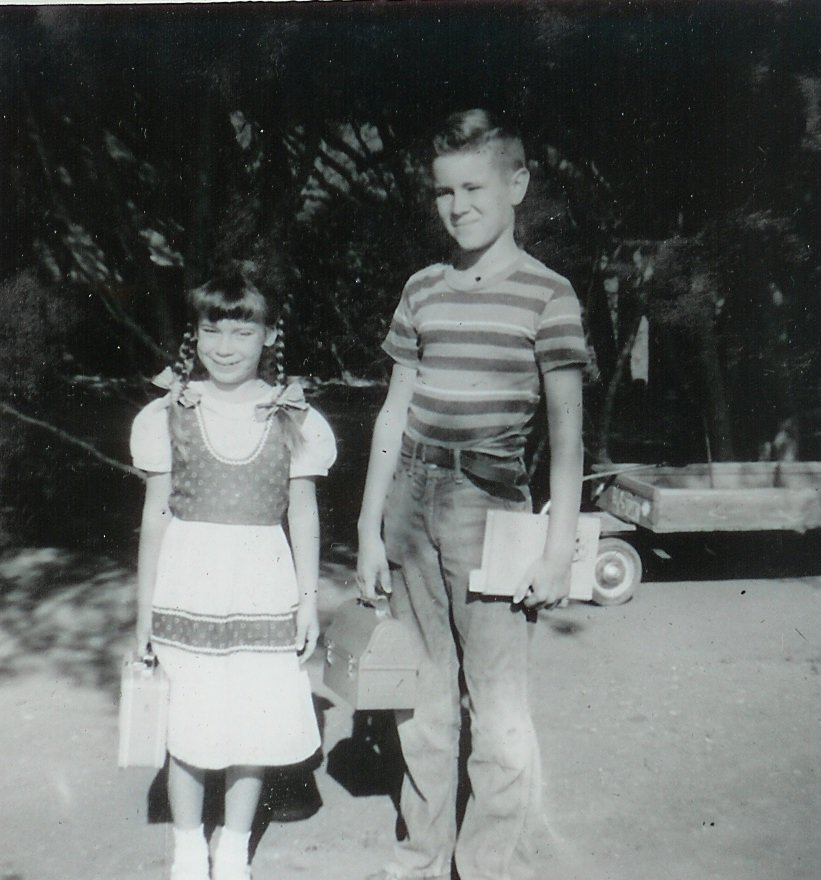
Dan and Terry, first day of school, 1953
Barbara and I took what had been the large guest room as our bedroom. Iím not sure why we did this. It only had a tiny closet, so I built wardrobe cabinets across one entire wall.My folks had partitioned off one end of the large L-shaped porch for their sleeping quarters. It was screened on two sides. I think that they missed all the fresh air that they had become accustomed to. The house in Los Mochis had all the bedrooms on screened porches, because of the summer heat. The little house where we first lived on Sinaloa Ranch also had a couple of "outside" bedrooms, and the folks slept in one of them. We decided to turn that area into a bedroom for Terry. The first thing I did was to level the floor. The original porch floor was sloped to the outside. I poured concrete on top of the old floor, two inches thick at the inside and whatever it took to make it level on the rest. The west wall had windows most of the way across, with built-in headboard and cabinets underneath. I made wardrobe closets on the north wall, and I think a moveable dresser for the south wall. There must have been a table or desk somewhere in the room.
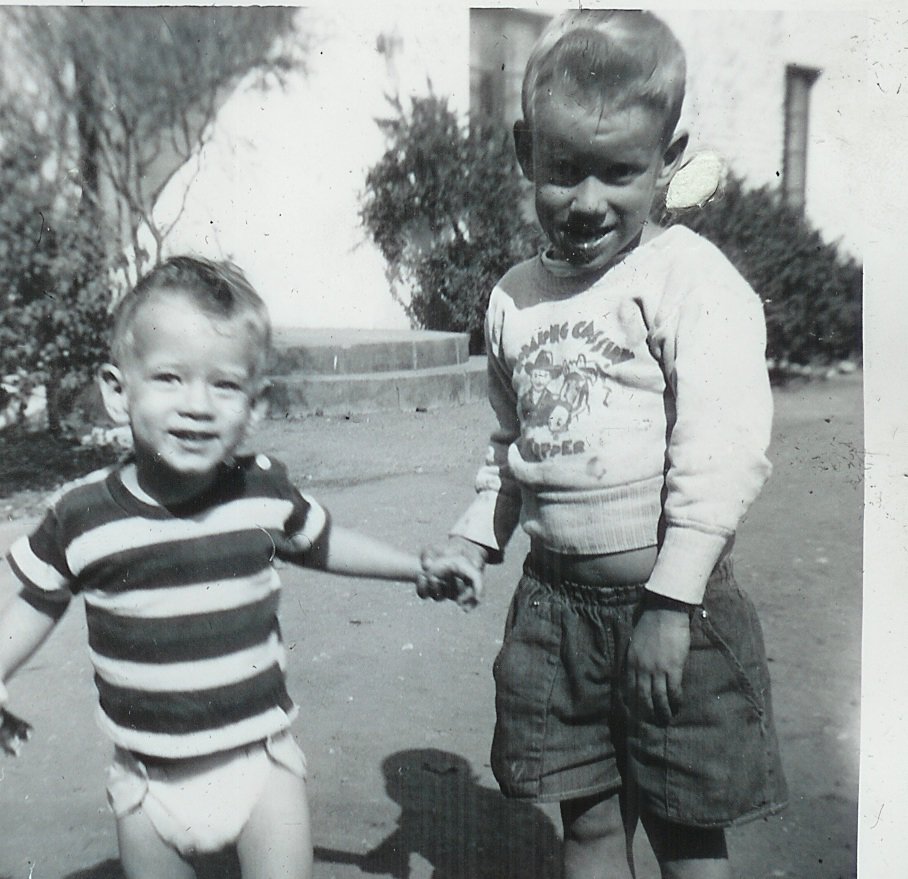
Gerry and Glenn
The other three bedrooms were left alone, except for doing repair work on the windows. The entire house was repainted, inside and out. My sister Rae painted a landscape, with cowboys, mural on one wall of the largest of those rooms. We visited the old house recently, and the mural is still there!
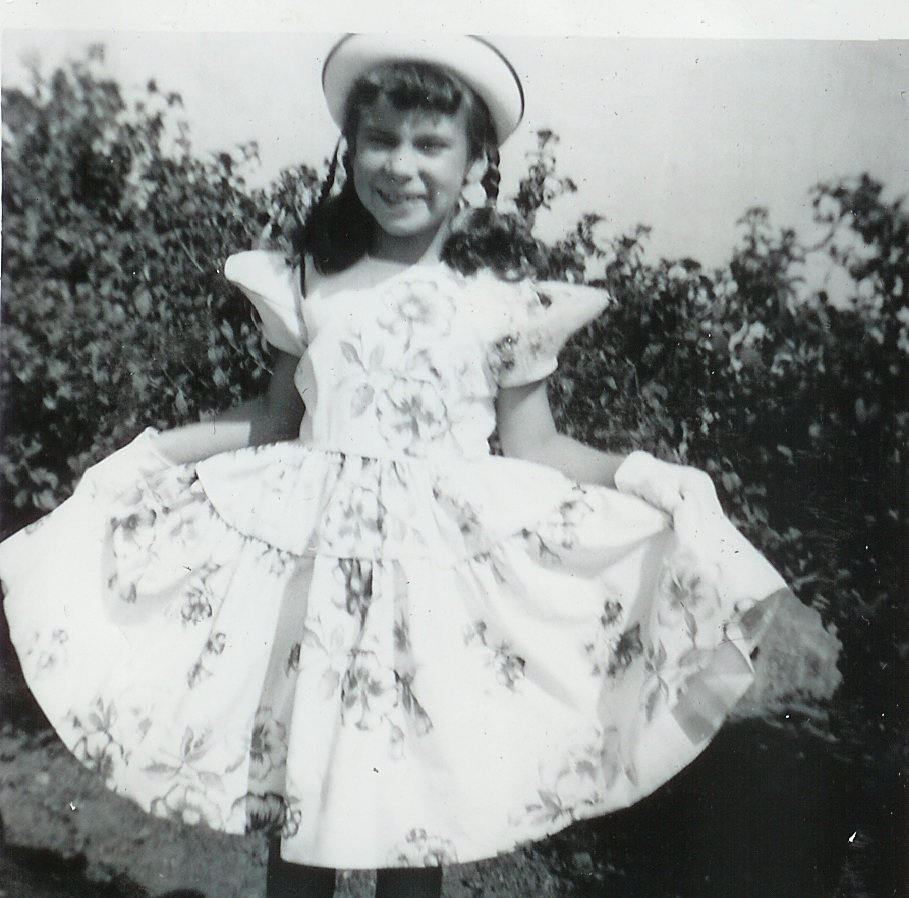
Terry, Easter, 1954
A year or two after Katy was born, Dr Jones told Barbara that for her health she should have a hysterectomy. The surgery was done at St. Johnís in Oxnard. When they brought her back to the room she was sort of awake, but soon fell into a deep, deep sleep. I got sort of worried, and called the nurse. She said something about watching her closely, in case she went into shock. Then she disappeared, not to be seen again for what seemed like an eternity. I sat by her bed, squeezing her hand and talking to her for at least an hour, but she didnít respond. I have never been so frightened, before or since! Finally she started to stir, and opened her eyes. She was probably fine the whole time, but I was a wreck! Dorothy hired me to do some work on Dad Robertsonís house, which was right next door to us. I closed in the garage for a bedroom, and made the shop portion into a tiny bathroom and tiny kitchen. The folks used the house when they came up from Mexico, and they wanted to have a spare bedroom for guests. With the money I earned doing that we bought a new washer and dryer.
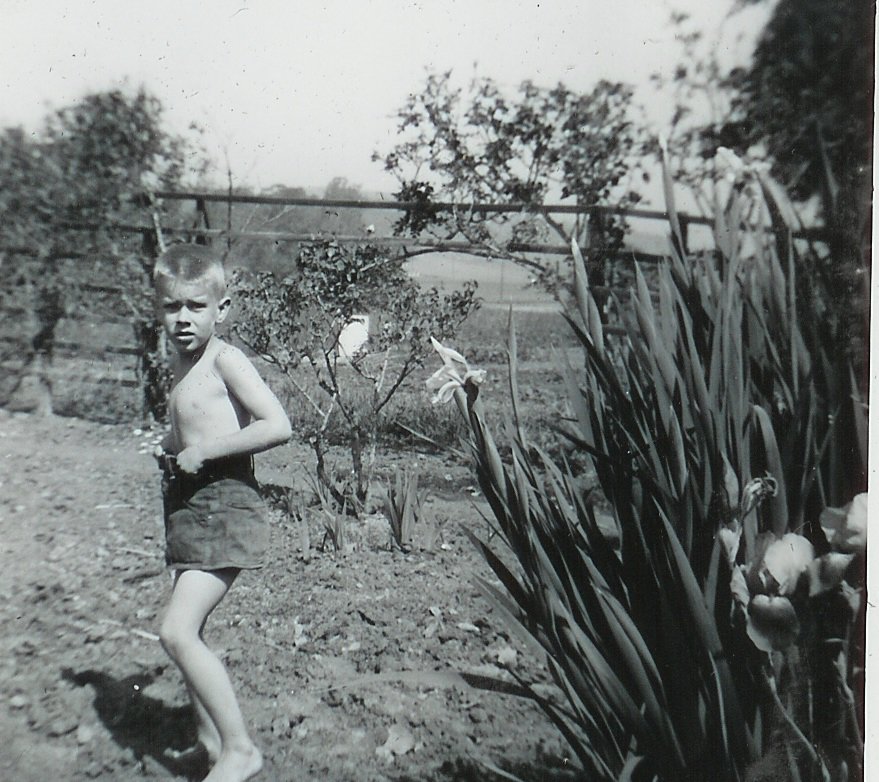
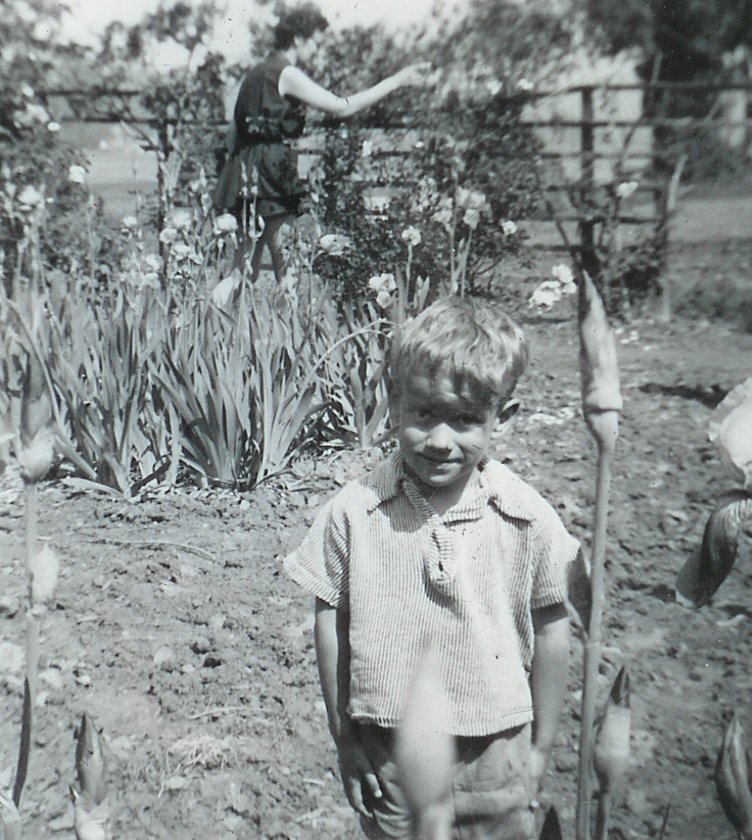
GlennóDavidóEaster, 1954
When all the work was done on the house I converted the detached two-car garage into a drive through carport and a workshop. So, after all the work was done, I finally had a place for my tools and supplies. Pop gave me a vise for my new shop. I had been working for years without a vise. Looking back, I donít know how I managed without one.
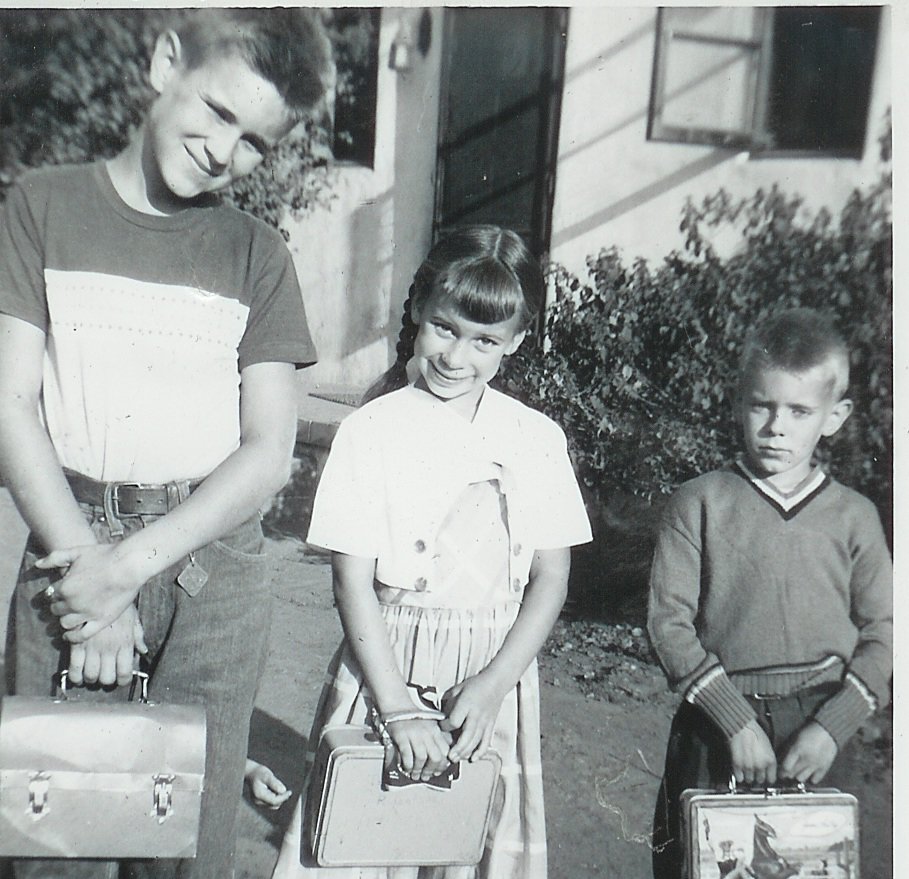
Dan, Terry, David, off to school, Sept. Ď54
Soon after we moved back to Simi the kids started to get involved in activities outside of school. Danny joined the Cub Scouts, and later the Boy Scouts. Terry was in 4-H for a while. I think David was in Scouts for a while, and Glenn was in 4-H. He raised lambs that were shown at the Ventura County Fair. I donít seem to remember the two younger children being in any of those activities. I can recall going with some of the other fathers with a large group of Cub Scouts to the camp at Three Falls, in Lockwood Valley, north of Ojai. Later I was on the Boy Scout Committee, and helped out at some other summer Scout camps. The most notable trip we had was a group of thirty Scouts and ten fathers, to Sequoia Nat. Park. We back-packed ten miles to Bearpaw Meadow. Very few of the group had done anything like this, so we stopped many times to re-do the packs, and treat blisters. It was very slow going. Fortunately, the trail was mostly pretty flat, even though we were at about 7 or 8 thousand feet. One of the men, Fred Chambers, got really lame, so that he could hardly walk. I was sent on ahead to intercept the pack train that was bringing our food and camp gear on a different trail. The plan was to have one of the horses double back to pick up Fred. Where the two trails came together was on a nice little stream. From there on to camp was only about a half mile, but I could see that it was quite a steep climb. While I was waiting for the group to catch up I soaked my feet in the ice-cold stream, and wondered how those struggling boys were going to handle that last half-mile. I should not have worried! When the boys were told that camp was just over the next ridge they just charged up that hill in nothing flat! We were all pretty tired that night. At least I know I was!
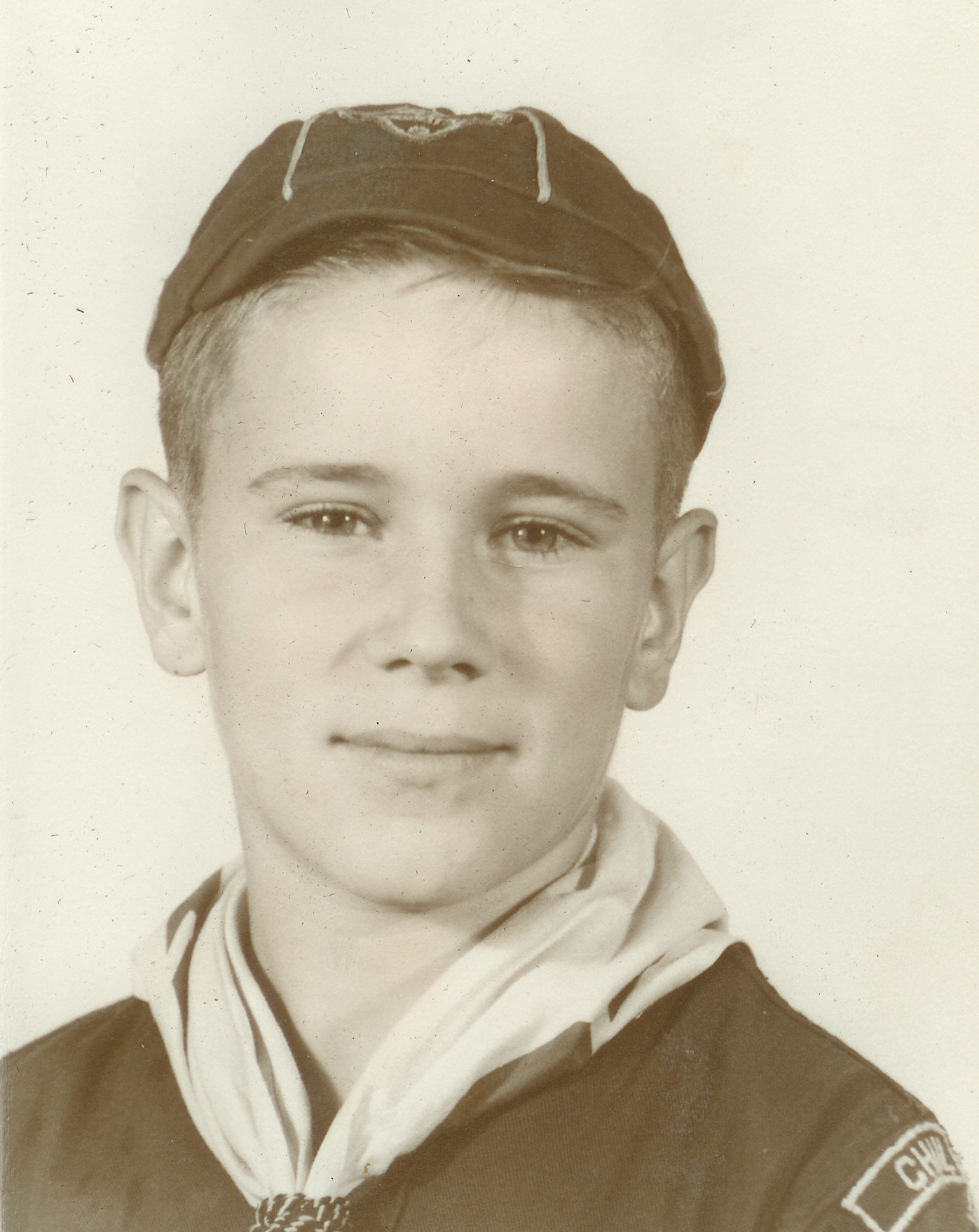
Dan, fourth grade
The next day three of the men took about ten of the stronger boys on up to a lake at higher elevation for a couple of days. I think Danny went with that group, but I "volunteered" to stay in camp. During that time I impressed everyone by making biscuits. I didnít bake them, I just patted them out pretty thin and fried them on a rather low heat, turning them several times. From then on I was asked to make biscuits every evening. Then the Scoutmaster asked me to make enough for lunches for the hike out. I agreed, on the condition that someone do the mixing and someone else keep the fire going at the right heat. All I did was the actual cooking. It worked out pretty well. Each of us left camp with two biscuits in our packs.Barbara and I got involved in another "500" card group that met once a month for many years. This was a rather different group than the earlier one. All the couples were our age, and had kids the age of our kids, so we had lots in common.Barbara also was part of a Koffee Klatch group of mothers that met once a week for coffee and visiting. With all this communication among the parents, our kids couldnít keep too many secrets from us! Barbara heard that there was a group of young men that met at the High School Gym once a week to play basketball, so I checked that out. Mostly we just divided into two teams and played each other. Nothing formal, we didnít even keep score. I do remember playing a game against a group from Moorpark. After about six months I developed bursitis in my left shoulder, so I was having to pass and shoot mostly with one arm. One night a couple of the younger boys lost their tempers and got into a scuffle. I took this as a sign that the game was getting too serious, and used it as an excuse to quit.My shoulder kept getting worse. Dr Jones gave me a very painful shot of cortisone, but that didnít seem to help much. One day when we were checking out of a market the clerk noticed that I winced when I tried to pick up something with my left arm. When I told her what the problem was, she offered me a cure. "Start each day with a half cup of sour cherries and a banana". Nothing else was working, so what did I have to lose? It took several months, but my shoulder gradually got better, until I had full use of my arm with no pain. I leave it to you to decide if I got better on my own, or whether it was the sour cherries and banana treatment.
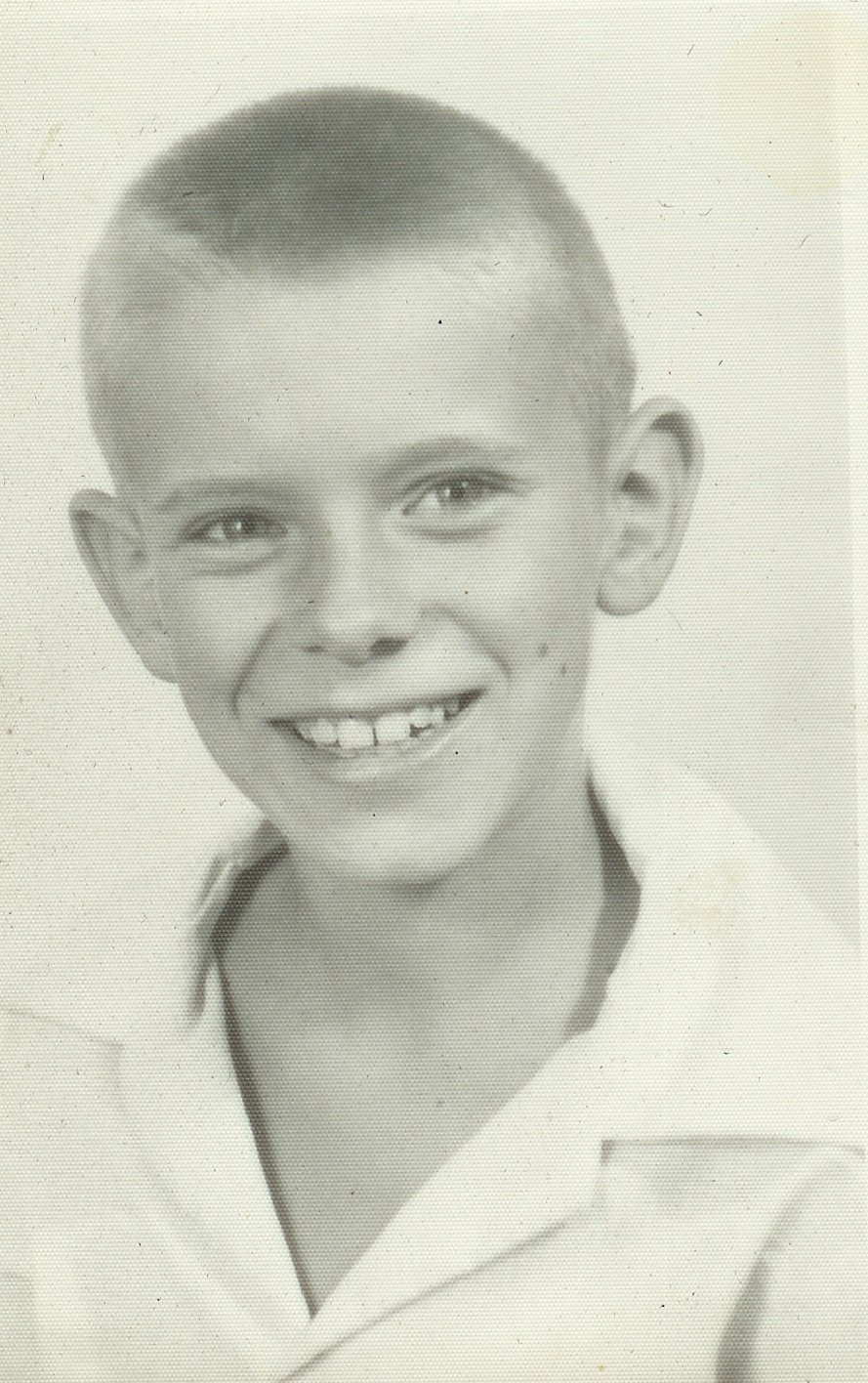
David, 1956
Shortly after we moved to Simi Alan traded his 1951 ford for a newer car. I made a deal to trade in our í49 Ford instead, and paid Alan the difference, so that we ended up with his car. Later, I bought a new í55 Ford station wagon, and Merilie bought the í51 Ford. She was living in the little house next to ours, and teaching at the High School.Merilie woke me up late one night, saying that her house was on fire. I Told Barb to call the Fire Dept. (no 911 then) I ran over to the other house, stopping only to turn off the propane. It seems that Merilie had been cleaning house and moved the little propane heater to clean underneath it. The gas line broke enough to let a little gas out, which soon ignited from the heater. Using a garden hose, I managed to get the fire out by the time the Fire Truck arrived. The firemen thanked me for my quick action, then got out their mops and cleaned up all the water on the floor. I was impressed! I didnít know that was part of their job. Fortunately, there was very little damage to the house.
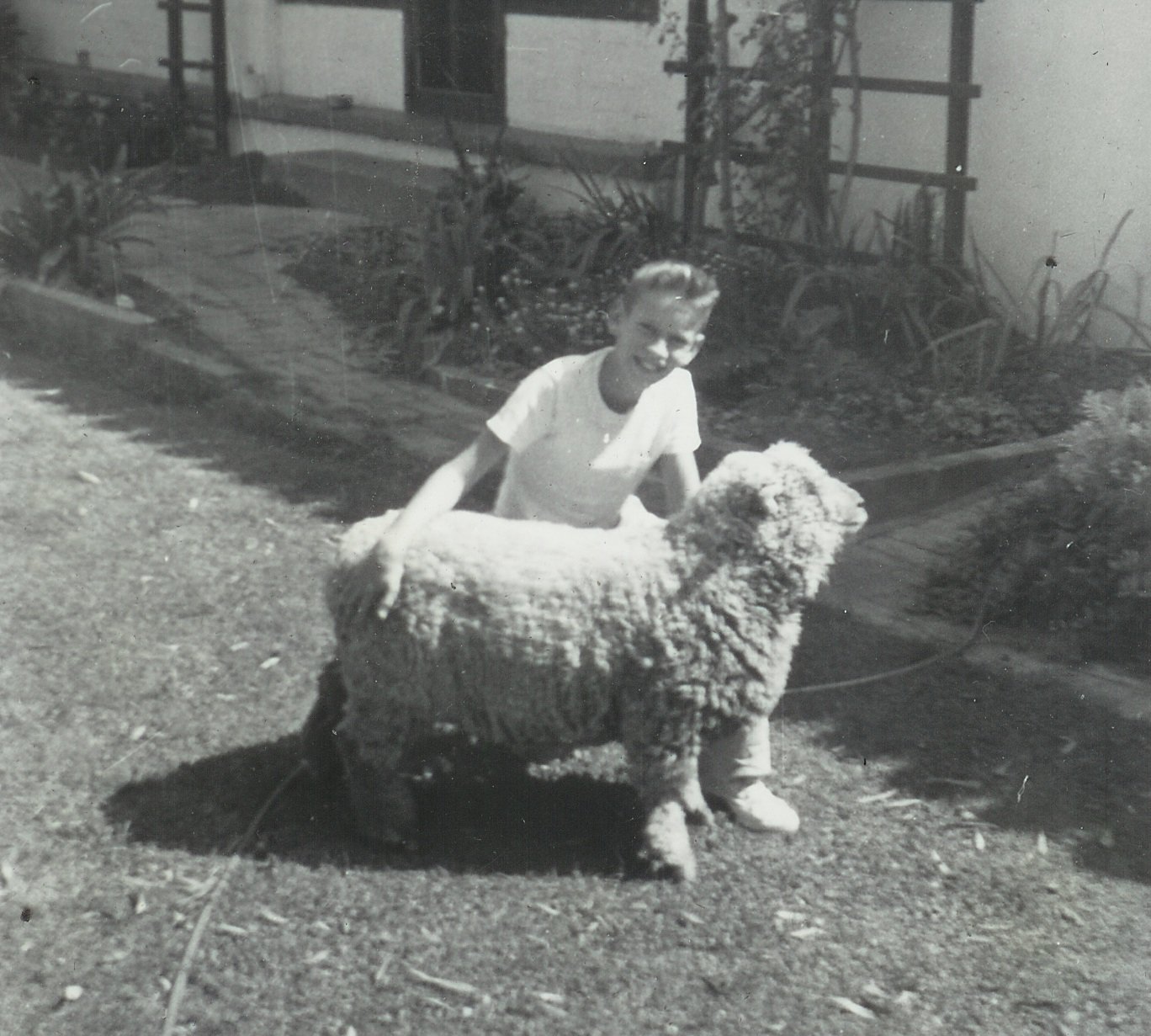
Glenn and his sheep, ready for the County Fair
We used the little trailer given to us by Burpee Seed Co. in Mexico for a family vacation at Refugio State Beach, north of Santa Barbara. I think we stayed most of a week. We did some swimming in the ocean and took hikes along the beach. Surely, there must have been some sand castles! Later, when my brother Tom had a job up near Lone Pine, he bought the trailer from me. He lived in it for a long time.In the summer of 1956 we arranged to meet Mom and Pop at Big Sur State park. They were there in their Airstream trailer, along with Momís brother Ted Reed and his wife Nan. Pop managed to save a spot for us next to them. Barbara and I slept in the back of the wagon, and we had a tent, or tents, for the kids. Katy had not yet been born, but she was with us on the trip nonetheless! After several days Mom and Pop and Ted and Nan left for a long trip up the coast, all the way to British Columbia. They took Danny and one of Tedís grandsons with them. The rest of us came home. We arrived in Buelton mid afternoon, tired, dirty and hungry. We went into Andersonís Split Pea Soup Restaurant. We had not been there before. It turned out to be a bit more fancy than we had expected, or needed in our condition! Nevertheless, we were seated at a nice table with white linen tablecloth. We all had soup, all we could eat, and lots of wonderful bread. I will always remember that we were treated as well as if we had ordered the most expensive meal on the menu.
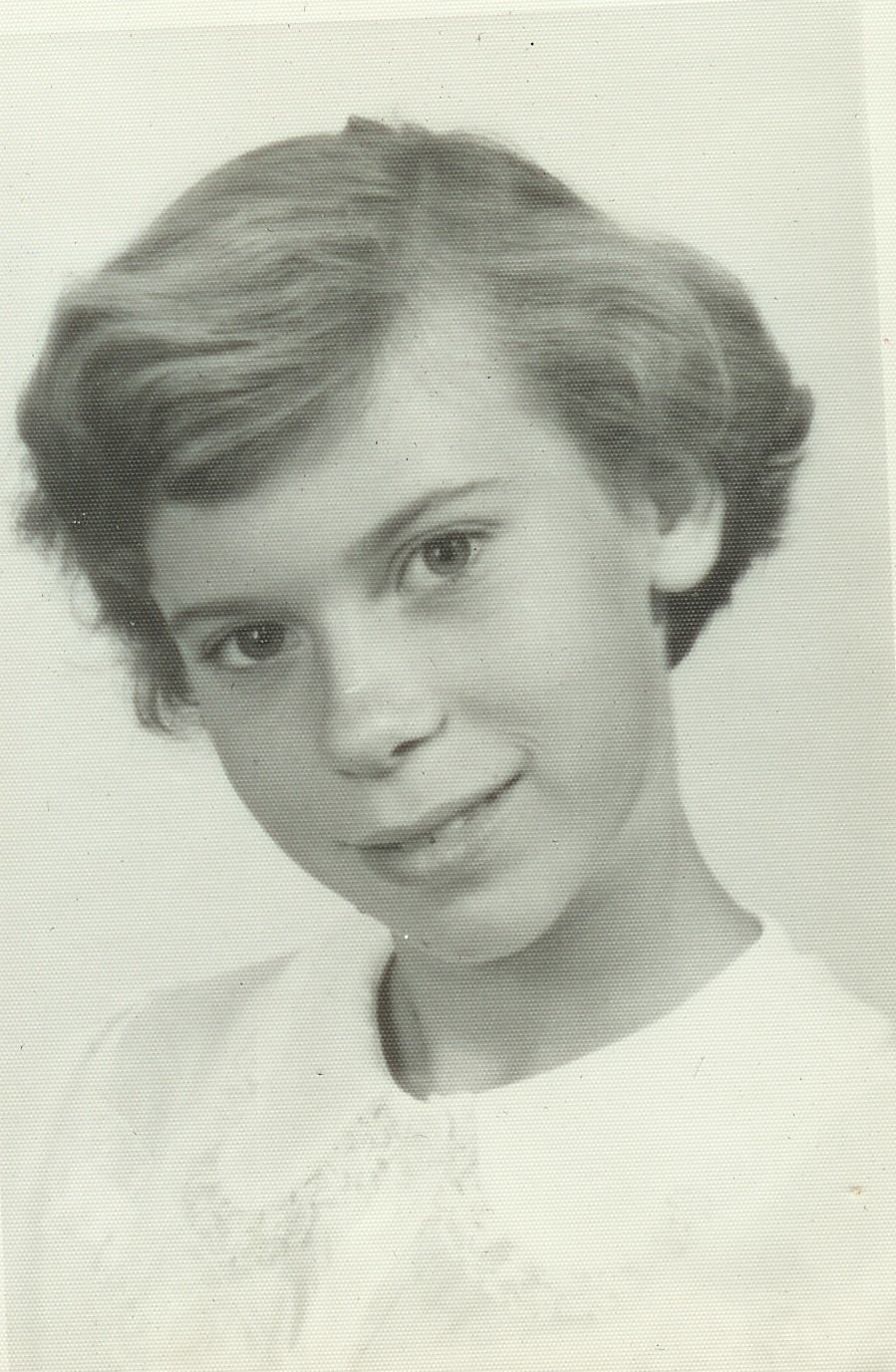
Terry, 1956
Mom and Pop Wilson had purchased a lot about a half-mile from us, and built a nice house. It was great having them so close. I think all of the boys, each in their turn, worked for Pop. He taught them all sorts of things, and the kids all adored both Mom and Pop. I think it was in 1959 that they offered to let us use their Airstream trailer for a vacation in Sequoia National Park.
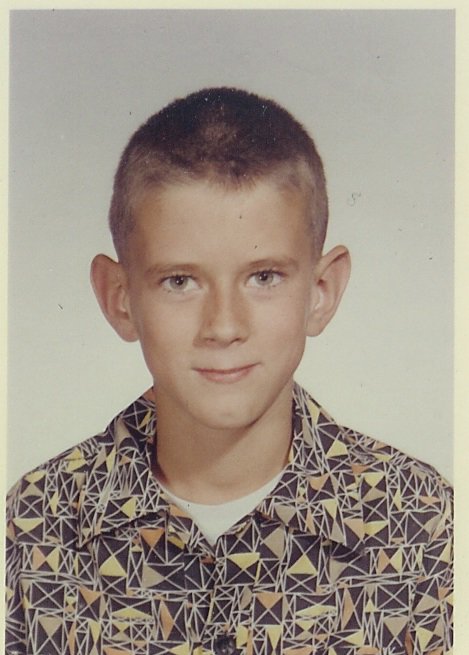
Gerry, 1960
The trailer had a special hitch that transferred some of the weight from the rear axle of the car to the front axle of the car and the trailer axle. It made the whole rig handle better on the road. I had to make a new mount to put the hitch on the station wagon. I think we left for Sequoia the day after school let out for the summer. The first part of the trip was un-eventful. We stopped just before reaching Three Rivers to buy a lug box of nice fresh peaches. The road from Three Rivers into the park is challenging, to say the least. You start at about 500 feet elevation and climb to over 6,000 feet, by way of hundreds of twists and turns. The good part is that you only have to shift gears once. Thatís at the bottom of the grade, into low gear. You stay in low gear until you reach the summit. I stopped about half way to the top, to get a drink of water and check everything. I found that the hitch was about to fall off the station wagon. The problem was that the weight transfer devise exerted a twisting force on the hitch when we turned corners. My mountings to the frame of the wagon were not built with this in mind. I decided to take the weight transfer bars off entirely, and then proceed slowly. I stopped a couple of more times to check, and things didnít seem to be any worse. We found a campsite in Lodgepole Campground. We put up at least one tent, maybe two.Barb and I slept in the trailer, and maybe Katy. We took drives around the park. One day we packed a lunch and drove to Kingís Canyon. We climbed up on Moro Rock. Barb was rather worried about her children up there. It is sort of dangerous. The top of the rock is rounded, so that the farther one walks toward the edge the steeper it gets, and no railings. She was much happier when we were all back on somewhat level ground. We hiked around Crescent Meadow and Muir Grove, Sunset Rock and upstream from our camp to a small waterfall. One day we drove to Crystal Cave. We had to walk about a half mile downhill to get to the entrance of the cave, then took the tour through it. That was the first cave experience for all of us except Barbara. She had been to Carlsbad Caverns as a young girl. We had a bear in camp on more than one occasion. Barbara thinks that we made two trips to Sequoia, but I only remember one. The kids all have very fond memories of sequoia, but one or two, who shall go unnamed, were not real happy campers!
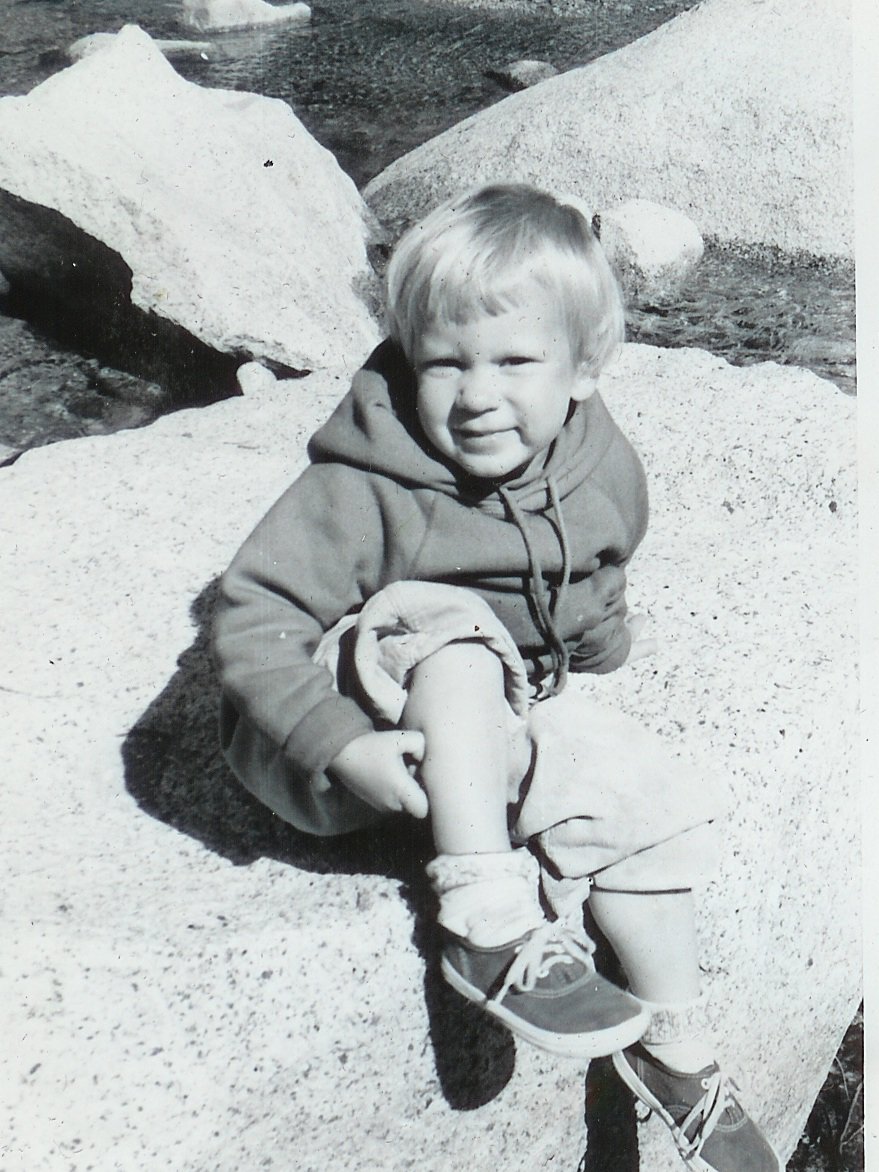
Katy at Sequoia
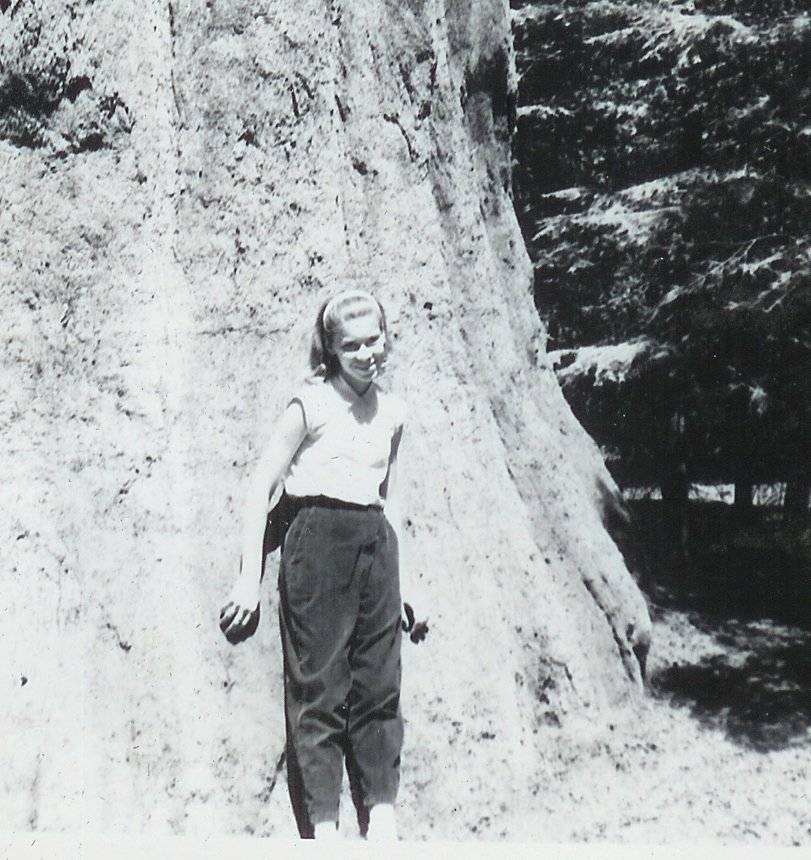
Terry at Sequoia
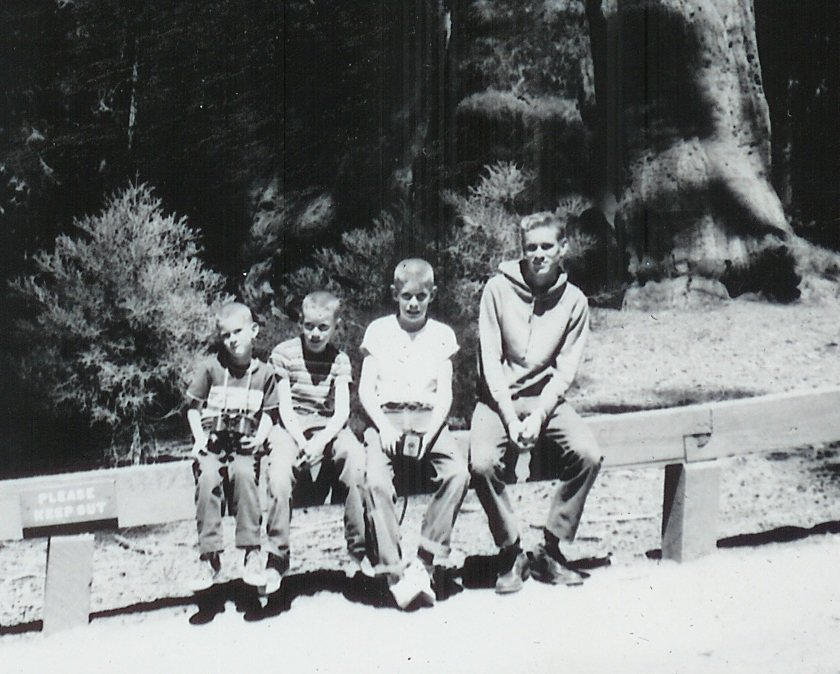
The boys at Sequoia
I managed to scrounge up some bolts to make the hitch a little more secure for the return trip. I left the weight transfer bars off to go down the hill, then put them on with very little tension once we were on straight and flat. We made it home in fine shape. If we used the trailer again behind the wagon, I surely would have mounted the hitch properly.We did use the trailer at least two more times, but I used my pickup to take the trailer to Leo Carrillo State Park, near Malibu. It was Easter Vacation, both times. I was working in Oxnard, so I just drove to work from camp and then back in the evening. One evening it started to pour down rain. The kids in the tents were not faring too well! We moved them all into the trailer. The floor was wall to wall with kids. There was no room left to walk! I think it rained for two or three days.We made at least two trips a year to visit my folks at san Miguel. We usually went in the summer for a week, then on one of the holidays for a few days.
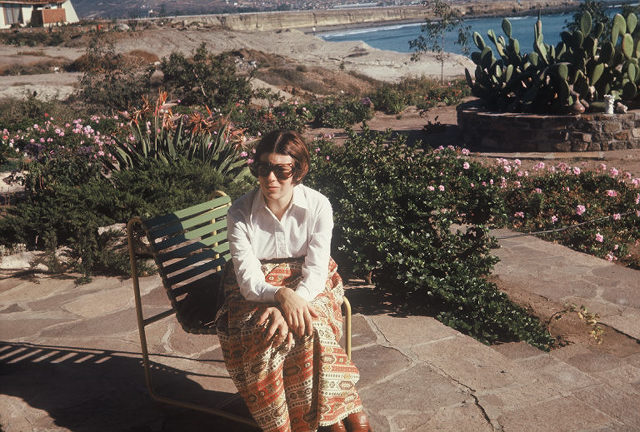
Terry at San Miguel
For many years after we moved to Simi we had large groups in for Thanksgiving. Sometimes it was Rae and Frank and June, their teacher friend from Winters, and Merilie if she was around. Other times it was Barbaraís family, Mom and Pop, Ed and Roberta, Forrest and Babs, and Bob and Marcella if they were around. And of course, assorted children! We had set up the gas range that we bought for Mexico out on the large screened porch. We used that oven to cook the turkey (furnished by Maulhardt Equip. Co). The oven in the kitchen was kept busy baking pies, candied yams, etc. I started early in the morning baking pies. I made apple, cherry, pumpkin, mincemeat, chocolate and lemon that I can think of. I started with the pie shells first, and then went on to the others while Barbara prepared the fillings for the shells. In spite of all the work, Thanksgiving was always something all of us looked forward to.
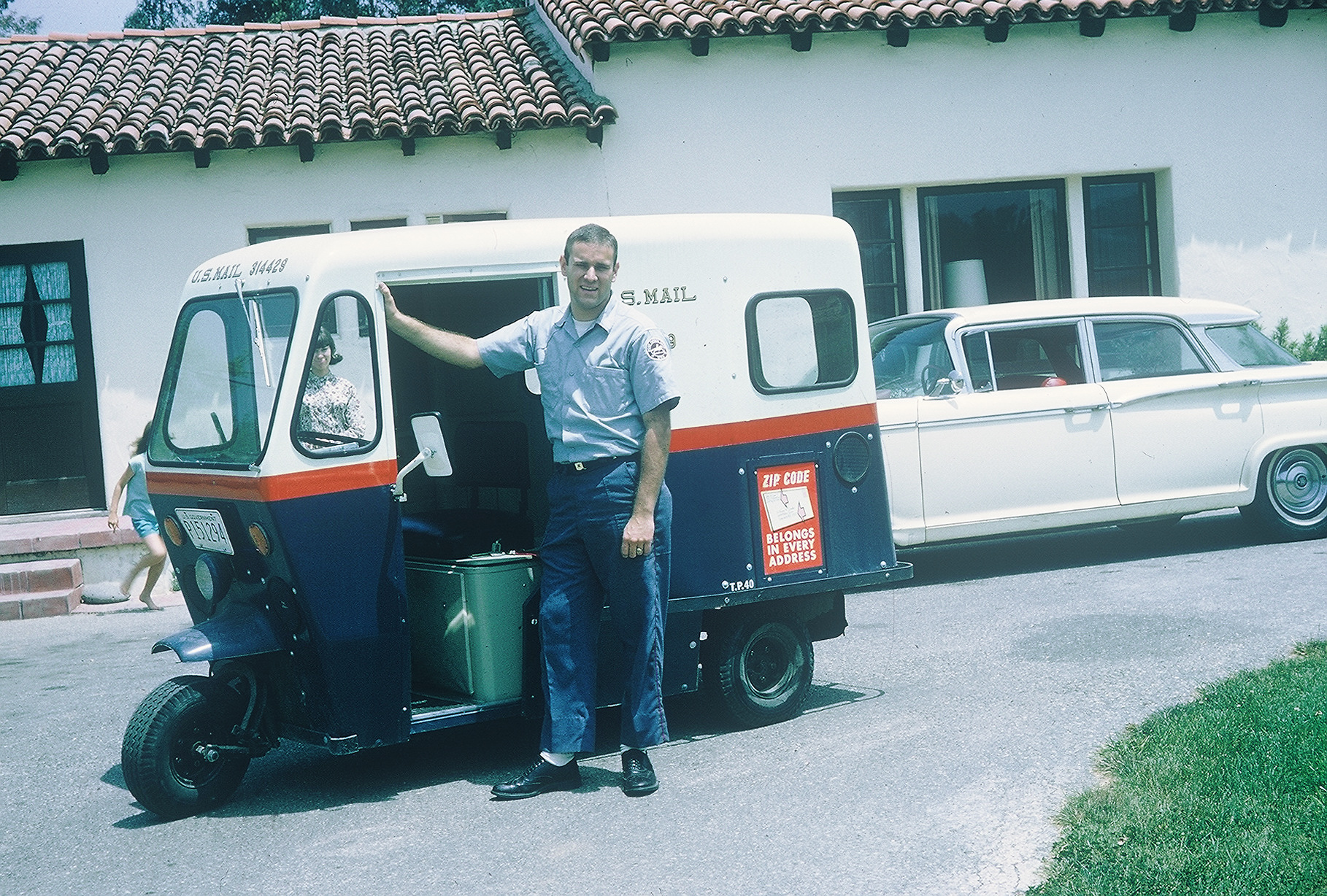
Danny, working for the Post Office
Soon after returning to Simi, I started deer hunting each fall with my brother, Tom. Somewhere along the line, I decided to get binoculars to aid in finding deer. I went to a place in Montalvo and bought a nice pair, 7x35, I believe. On the way home, I began to feel guilty about spending thirty dollars out of Barbís budget without consulting her. When I got home, I put the binoculars in front of her, and told her they were for her. Much to my surprise, she was delighted! She used them to watch birds in the yard, and of course she would let me use them for my hunting. We had permission to hunt on the Runkle Ranch, south of Simi Valley, and on what had been the Wharton Ranch, and before that the Lewis Ranch, on the north side of the valley. It was now called CDLB, Canal de la Brea, and owned by Union Oil Co. This name was given to it by the early settlers, because of the numerous oil seepages in the area. It happened that the caretaker of the ranch, Verne Messemer, was an avid fisherman. We struck a deal with Verne to trade fishing in Sinaloa Lake for hunting rights on the CDLB. We had to call Verne ahead of time, to be sure that none of the Union Oil people were around when we wanted to hunt. Obviously, they were not part of this arrangement! Neither side took advantage of this deal. We hunted a couple of times each season, and Verne fished about the same, and always asked permission. When I was fortunate enough to bag a buck, it was taken to Spencerís Market, in Moorpark. I had Riley grind all the meat, and add a little sausage to it, for moisture and flavor. He stored it in his big freezer, and we used it as needed. That venison was a far cry from what David had in Alberta!
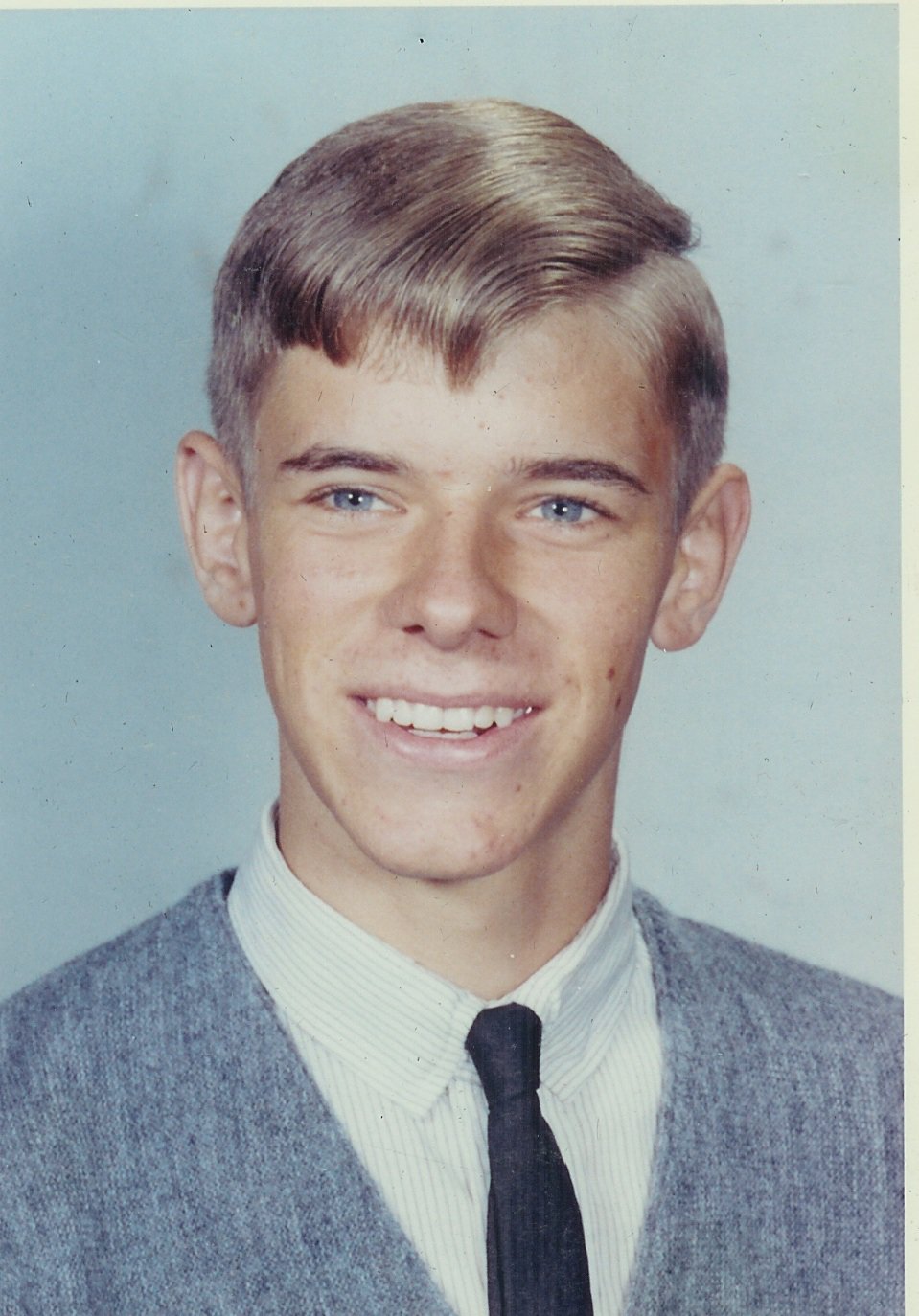
David, High School
I coached a Little League baseball team for a couple of years. It was not really officially Little League, but thatís what we called it. The age group was nine through twelve, I think. One, or both of our oldest boys played during those years. I think there were only three or four teams. On the first day, all the boys that were interested gathered at the old Elementary School playgrounds, for a little workout period. I was running late, so the selection process was ready to get underway when I arrived. When my turn to pick a player came around, I chose the tallest Mexican boy in the group. On successive turns, I picked all the Mexican boys available, then the boys that looked to be the most mature, and therefore the most coordinated. Why the Mexican boys, you ask? My observation over the years had been that they seemed to mature at a younger age, and were good athletes. I didnít think of this at the time, but I suspect that all of them that came to the trials did so because they really wanted to play, while a portion of the other boys came because their parents wanted them to play! My theory worked. My starting pitcher and catcher were both early choices. We only played about six games. The group had agreed upon a rule that required each boy to play at least one inning per game. The other coaches chose to play the best players first, then put in the others in the late innings. I chose instead to play the reserves first. That way, if the game was going well, I could leave them in a little longer. I wanted my best players in the game at the end. In the final game of the season, we defeated a team coached by my brother, Alan, to win the championship. It was the first time ever that I bested him in an athletic competition! And the last, I might add!It was probably about 1960 that we took a trip to the Grand Canyon. Only the four older children went. We left Gerry with my sister Jean, and Katy with Fran Chamberlain. I borrowed a roof rack for the wagon for all our gear. By the time we got to Barstow the kids were getting a little restless and rambunctious. I think that was when these famous words were first spoken. This could have been a fun trip for everyone! Our destination that first day was Lake Mead. I had been studying the map, and it seemed like the shortest route would be to cut across the desert on a secondary road to Searchlight on Highway 95 in Arizona, then north to Boulder City. This road was pretty decent as long as we were in California, but as soon as we reached Arizona it changed to a winding dirt road. We stopped for lunch in the shade of a cactus. The map says it is thirty two miles to Searchlight, but it seemed like a hundred. I can guarantee that the kids have never forgotten that little adventure! Whenever I take a wrong turn they ask if we are going to Searchlight! At Boulder city we went to the visitors center and watched a film of the building of Boulder Dam, then took a tour of the dam itself, and the power house. All very impressive. We pitched our tent in a campground next to Lake Mead. The kids and I all went swimming in the relatively warm water. I donít remember if it was that afternoon or the next morning that we went into Las Vegas to look around in some of the casinos. Some of the kids got "busted" for putting nickels in some slot machines that were almost on the sidewalk.I forgot to mention that Dorothy gave me some money for the trip, $100, I think. She wanted us to be able to buy a few meals along the way, so that we didnít have to cook in camp quite so much. Bare in mind that dollars were very big in those days. I think that the six of us were able to eat out every night on the trip. Of course we had to ride herd on the kids in the cafeterias. They tended to want everything in sight. We sort of put a limit on what they could spend and let them choose what they wanted within that limit. This was one of the quiet, thoughtful things that Dorothy did all her life.The next stop was Zion National Park. We found a nice camp spot and set up the tent. We took several short hikes, one upstream to where the canyon narrows to just a few feet wide. We all enjoyed Zion.The next day we drove to Bryce Canyon National Park. I think we went on a short kike down into the canyon. For some reason, Bryce was not a place that we had a great desire to go back to. After Bryce we headed for the north rim of the Grad Canyon. Before we got to the turnoff at Kanab it started to rain. It rained harder and harder, I ran the wipers faster and faster, and drove slower and slower. Finally, I literally could not see anything in front or to the sides. I had no choice but to stop, and hope that no one crashed into us from the rear. It poured like that for at least ten minutes. As it started to ease up I was able to see enough to be able to edge of the road a little. When it finally stopped we were in the approach to a service station on the edge of Kanab. I guess we had experienced what is called a cloudburst. I guess that helps explain why there are so many interesting formations created by water erosion in Utah.
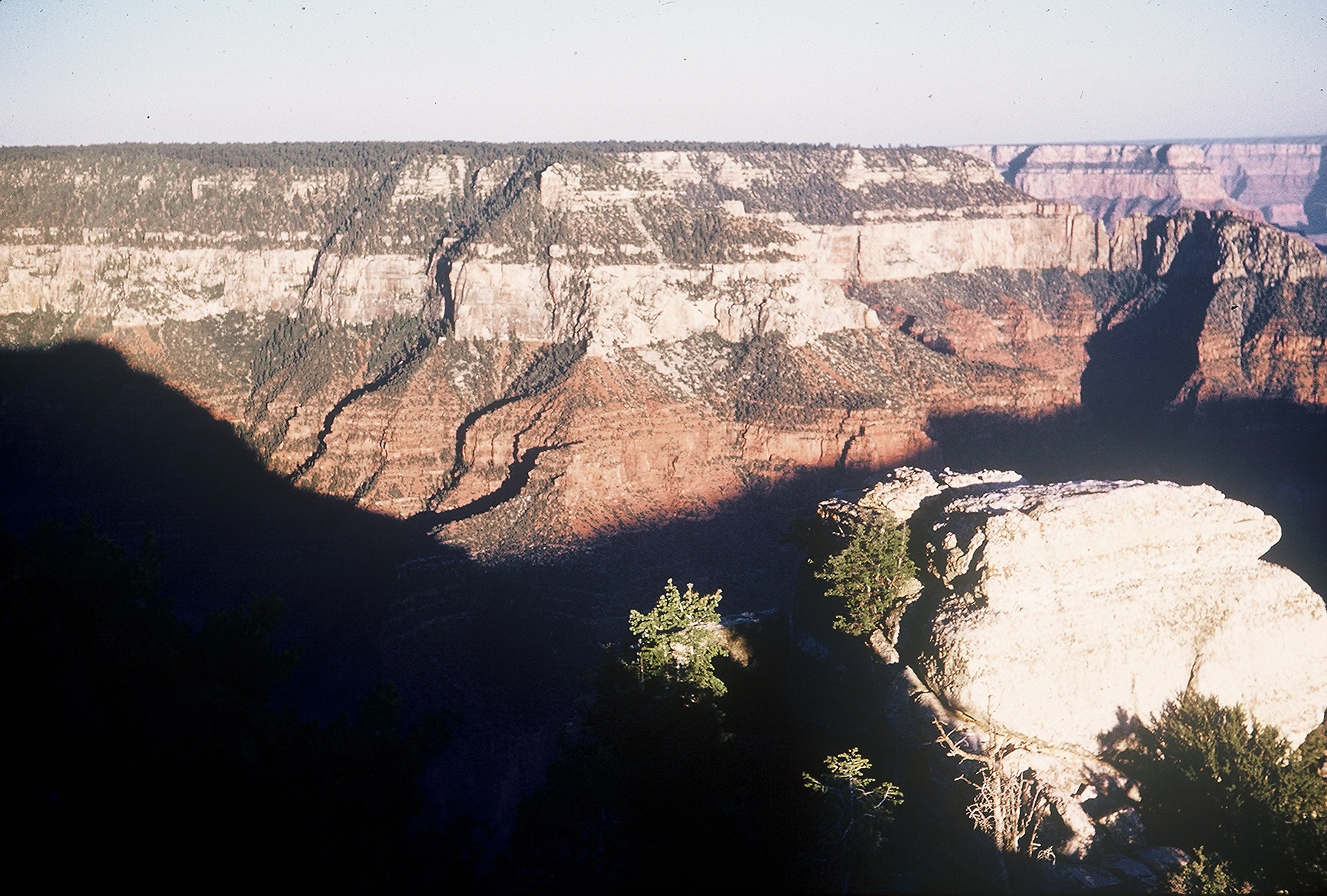
Grand Canyon at Sunset
When we left home we did not realize that the North Rim is only open for about three months each summer. We were lucky enough to find that it had just opened a few days before we arrived. We set up camp, and then walked out to the viewing area. The canyon is truly a breathtaking sight. After dinner in the lodge, we went back out to one of the viewing areas to watch the sunset. The colors are constantly changing as the light changes, especially at sunrise and sunset. I got up early the next morning to see the sunrise, but Iím not sure I got everyone else up! We really liked the North Rim. The campground was nice, we were in a forest of lush green conifers, and it was not crowded.The next day our journey took us out of the forest into some rather desolate desert country. We crossed the Colorado River at the upper end of the Grand Canyon, then wound our way to the South Rim of the Canyon. We stopped at some overlooks along the way, and found them all to be very crowded. When we found the campground at Grand Canyon Village, we were very disappointed, to say the least! It must have been very new. The roads were not surfaced at all, and the dust from them was stifling. The campsites were very tiny, and that side of the canyon is totally devoid of trees. By the time we left everything we owned was covered with fine, white dust. In this area we had to stand in line just to get close enough to the canyon to see it! Not exactly our cup of tea!I called home to talk to Pop that evening, to let him know how we were doing. He had been taking care of Glennís two sheep; a ewe and a lamb. He told me that the ewe had become tangled in a rope and suffocated. I talked to Barbara about it and we decided not to spoil the trip for Glenn with this news.The next day we got up early, took a quick look at the canyon, and started south. We went to a market in Flagstaff to get some things for lunch, including a watermelon. South of Flagstaff we found a nice park where we fixed lunch. I got feeling so guilty about not being truthful with Glenn that I took him aside to talk to him. He was very upset, naturally. He said that he knew by my actions the night before that something was wrong. I donít think he ever really forgave me for not telling him the truth to begin with. Some lessons are learned the hard way!We had intended to stay in a campground in Oak Creek Canyon, but when we got there it was so hot and dusty, the camp so crowded and noisy, the restrooms so filthy, that we decided to go on down the road to look for something nicer. We stopped in Jerome, an abandoned mining town on the side of a mountain. That was pretty interesting. From there we went over some high mountains, but never seemed to find a campground. After descending the mountain there was nothing but hot, flat desert ahead of us. I decided to make a run for Blythe, on the CA side of the Colorado River. Our plan was to get a motel, with swimming pool, then leave early in the morning for home. We crossed the river at about eight in the evening. A thermometer on the CA side indicated 108 degrees!
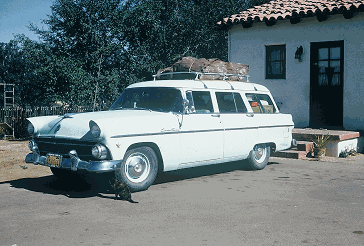
Home from the Canyon
Did I mention that the wagon did not have air conditioning? That was not surprising, as very few cars did in those days, especially in the area where we lived. In Blythe we found that all the Motels with pools were full. We went into an air-conditioned restaurant for a nice chicken dinner. By the time we finished eating, we were quite refreshed, so I decided to just drive on through the night, thinking that it would be cooler than driving the next day. We stopped in Desert Center for gas about midnight. It was 110 degrees! We stopped again at a rest stop in Indio. I stretched out on a picnic table for a few minutes; we all used the restroom, then back on the road. We arrived at our house about 4:00 AM. It had been a long day! I vowed then and there that our next car would have air conditioning!In 1964 Barbara put her name in a drawing at Thrifty Drug. A week or so later, one of her friends called to tell her that she had won a trip to the Worldís Fair in New York! I was playing golf with Pop on the little nine-hole course that Alan had built on Sinaloa Ranch when she got the news. She sent one of the kids down to tell me to come home. Meanwhile, she called Thrifty and confirmed that she, indeed, really was a winner. The two of us drove to the store to talk to the manager about it. He set up an appointment for us at some office in Los Angeles, where we made our reservations and picked up airline tickets, hotel reservations and voucher, tickets to the Fair for two days, as well as to many of the attractions, including restaurants. We were also given $200 in cash for extras.Neither Barb nor I can remember exactly how the kids were taken care of while we were gone. Dan was away at Cal Poly, Terry was in high school long hours because of two bus rides each way. Katy was only nine years old. I think that Mom and Pop must have stayed at the house. On the other hand, this was to be the first time we had been anywhere without them for almost twenty years; maybe we just told them they were on their own, deal with it!
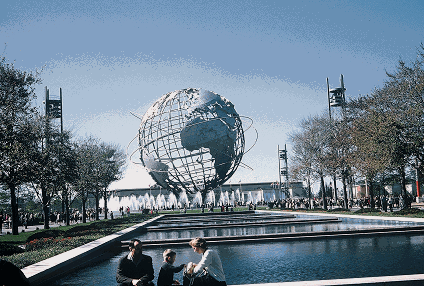
New York World Fair
We decided that we should spend more than the two days and three nights that were paid for, since this might be our only chance to see that part of the country. I think we took $200 dollars of our own, plus what had been given to us. We didnít have a credit card, except for two or three gasoline cards. Credit cards as we know them did not yet exist. Come to think of it, I may have had one of the early Banckamericards, but since Bank of America, at that time, was just a California bank, the card was not accepted on the East Coast.Very early on an October morning, we boarded our aircraft, at LAX. If I remember correctly, it was a Douglas DC-6, four-engine propeller plane. It was the last transport Douglas made before the advent of jet engines. We were delayed an hour or more on the airplane, because of mechanical problems, or weather, or something. Finally, we were on our way. I think we were able to see the Grand Canyon as we passed over it, then some of the Midwest before clouds obscured our view. At the far end of our flight we had to circle for what seemed to be an eternity, waiting for a landing slot. It was overcast enough that we could see virtually nothing, until we were almost on the ground. In the terminal we retrieved our bags and inquired about getting to our hotel. Being simple country folk, not wise in the ways of the big city, we were reluctant to take public transportation, Ďlest we might be lost forever on the subway! So, we opted for a taxi. That was quite a shock. I think we spent thirty five dollars in the first half hour in New York! We noticed another couple getting a taxi at the same time we were getting in ours. When we arrived at the hotel, they were checking in just ahead of us. It turned out that they had also won their trip from Thrifty. We could have shared the cab. Oh well! I think our hotel was called The Americana. It was nearly new, with a floor for each state in the Union, 48 at that time. Our room was near the top. We had to take an express elevator that took us most of the way, then get onto a second elevator to get to our floor. We had quite a view from our window!After getting settled, we went to the Concierge, and managed to get tickets for a Broadway play, "How to Become a Millionaire Without Really Trying." Another night we went to Rockefeller Center to see the Rockettes. I think we went to the Fair two days, seeing all sorts of interesting things. The only really memorable exhibit was Michelangeloís Pieta. To get to the Fair we took a train from Penn Station. We managed to get on the right train, and get off at the right place, then back on the right train for Penn Station. We were beginning to feel comfortable with all this, until we got off the train. Nothing looked familiar. None of the signs that I had sort of oriented myself to earlier in the day were to be seen. Panic! The country boy is lost in The City! Finally, someone recognized the look of desperation, and gently told me that the return train came into the station on a lower level than where we had boarded in the morning. Climbing one flight of stairs set the world straight again, and we made our way back to the hotel.After our prepaid room expired at the Americana, we moved to the very old, and much cheaper New Yorker. It could best be described as a dump! It was demolished soon after our stay. One thing we learned right away was that coffee was always served with milk in it. We had to be certain to order black coffee. We went several times to eat in the Automat. The Automat was a cafeteria sort of restaurant, except that each item of food or drink was in a compartment of a glass cabinet. Putting a coin in the slot allowed you to open the cabinet to remove one item at a time. When we got to the coffee compartment, there was no black coffee. A helpful soul behind us said to tap the glass with a coin to get assistance. That seemed to work well, and we soon had our coffee. The Automats were open twenty four hours a day, and served a broad spectrum of humanity. We observed well dressed business people, scrub ladies, and some rather bedraggled ladies of a more dubious profession. Marcella put us in touch with her sister, who lived in New York. She and her husband picked us up in their car and gave us a good tour of the sights of new York. We had lunch in a restaurant overlooking Central Park. Another day we went to the top of the Empire State Building, visited time Square, and rode the Statten Island Ferry to New Jersey and back, without getting off. I think the fare was 10 cents each way. From the Ferry, we got a good view of the Statue of Liberty.
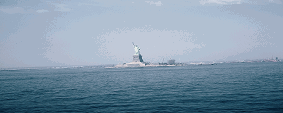
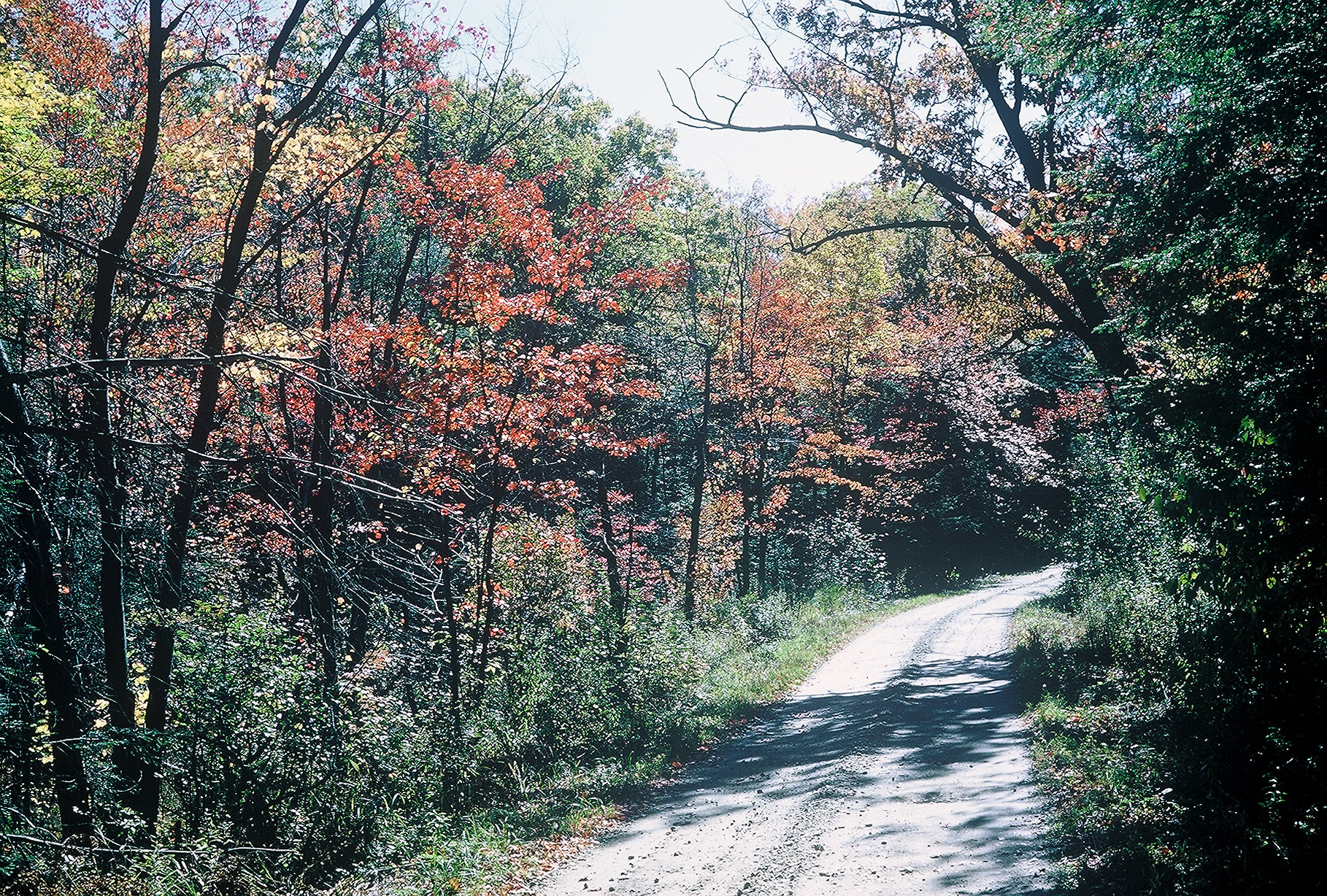
Statue of Liberty Fall Colors, Connecticut
Last on our list of things to do was a driving trip through Connecticut, to see some covered bridges, and the autumn colors. We checked out of the hotel, and walked the two blocks to the nearest car rental. Of course the first thing we needed was a credit card, but none of my cards seemed to satisfy the manager. I told him that I planned to pay cash, but he still needed a card for security. We discussed this matter for a while, then I told Barb that we would walk down the block to the other rental agency, to see what they could do for us. Suddenly, as if by magic, the manager decided that he would accept my Texaco Card. Soon we were on our way to Connecticut! Driving in New York was so totally confusing that I felt lucky to get out of town with only one traffic ticket!I think we spent two days driving around Connecticut. We found a couple of covered bridges, and the trees were putting on a fantastic display of colors. We really enjoyed this part of the trip. My one disappointment was that I could not find the well-kept red barn that I had imagined would dot the countryside. The farms were extremely small, and the barns neither red nor well kept!Before we left for the swing through Connecticut we changed our return reservations to a later date, and a different airport, that would be easier to drive to. I donít remember much about the return trip, except that as soon as the pilot told us we were over Las Vegas, I could tell that we were starting our descent for landing in Los Angeles. It turned out to be one of those perfectly clear nights, so the lights of Los Angeles were quite impressive. It had been a great trip, but getting home is always the best part! The 1960ís would see many changes in our lives. Danny went off to college at Cal Polly in San Luis Obispo. Toward the end of his four years, he and Catherine Crosby were married. After graduation, they settled in San Diego, where Dan was to work for the U.S. Navy for his entire working life.
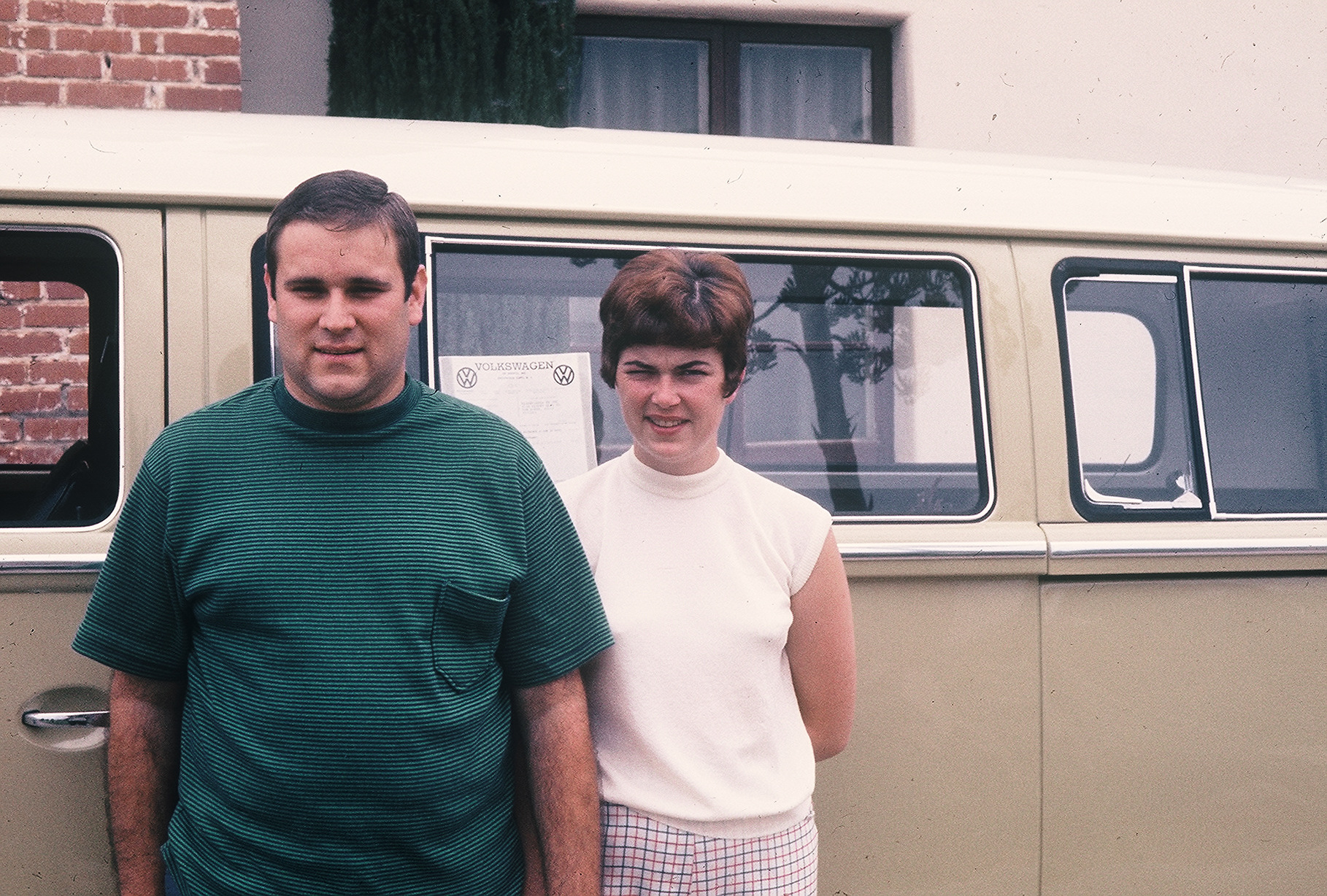
Dan, Cath, and VW Wagon
Three years after Danny, Terry also went to Cal Polly. In her second year she married Jim Cochrane. After Jim graduated, they settled in San Clemente, then San Juan Capistrano, where Jim worked as a teacher.Barbaraís brother, Bob, and his wife Marcella visited us from North Africa, where Bob worked for the Air Force. Their daughter, Catherine stayed with us the following year, so that she could go to Simi High School for her senior year. The following year she went to Cal Poly. Being an only child, growing up in the somewhat sheltered environment of the Air Force base, being thrust into a household with six cousins was sort of a culture shock, to say the least! I think it was a rather miserable year for her, but now she has fond memories of that time. Glenn was sort of her soul mate for that year.
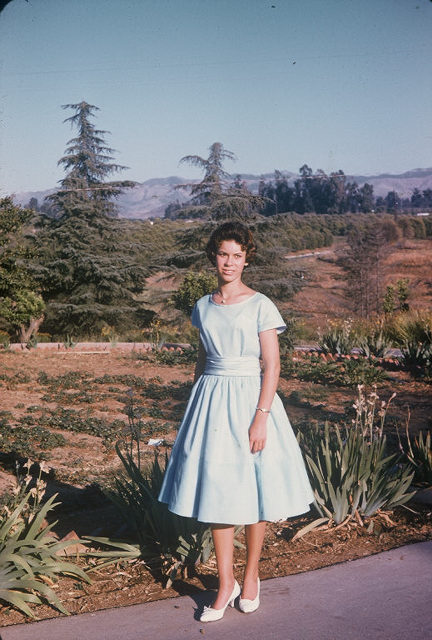
Terry
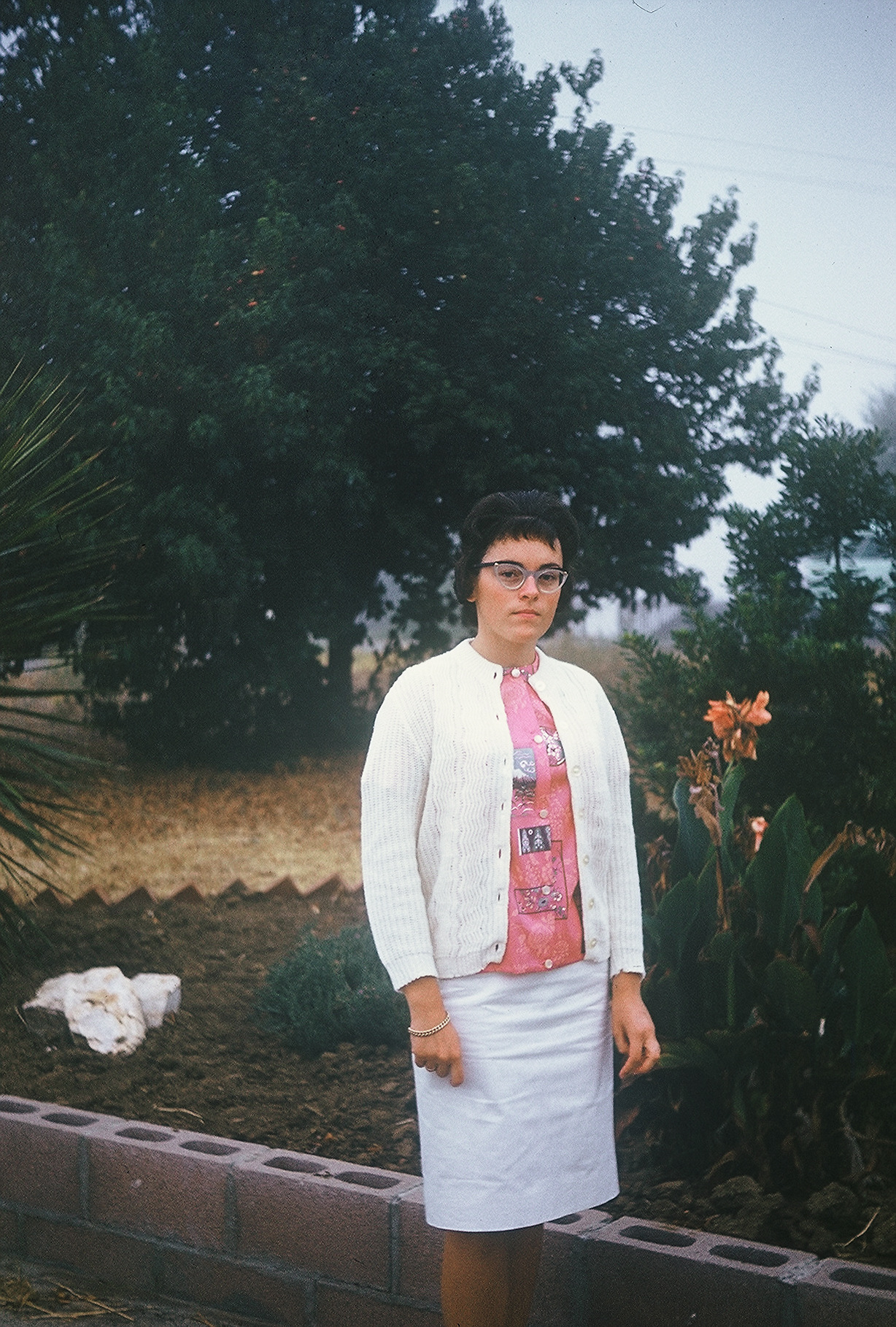
Catherine Wilson
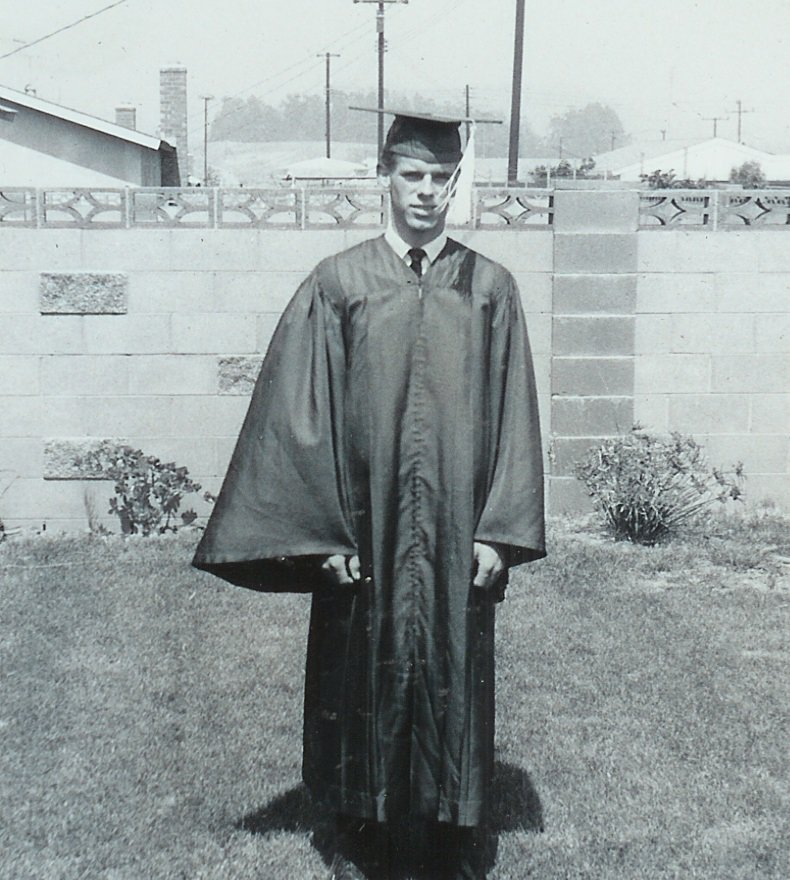
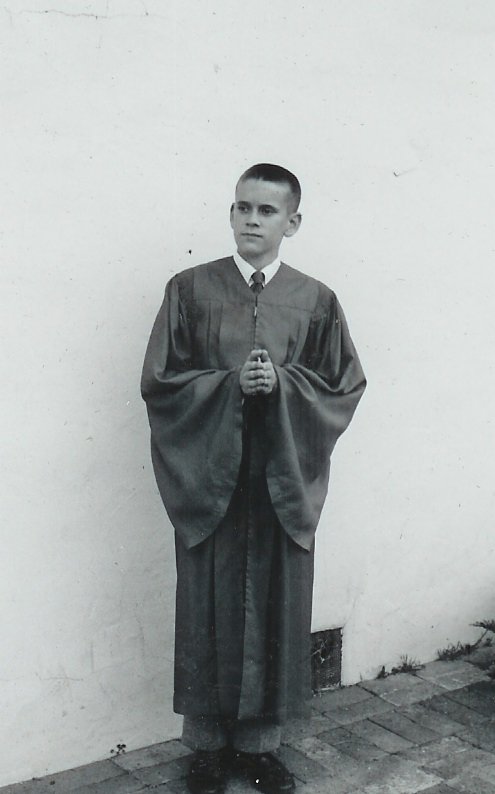
David Glenn
David went to college in San Diego for a year before moving to Canada, where he married Susan Reed. They lived in British Columbia and Alberta for about 15 years.Glenn graduated from high school, and immediately went to live in San Miguel, to work for my father.Barbara lost her mother, Aileen (Mom), in Jan. 1968.The "Big House" was host to a couple of large family events. In 1968 Barbara and I celebrated our 25th wedding anniversary. In 1969 all the family gathered to celebrate my parentsí 50th anniversary.
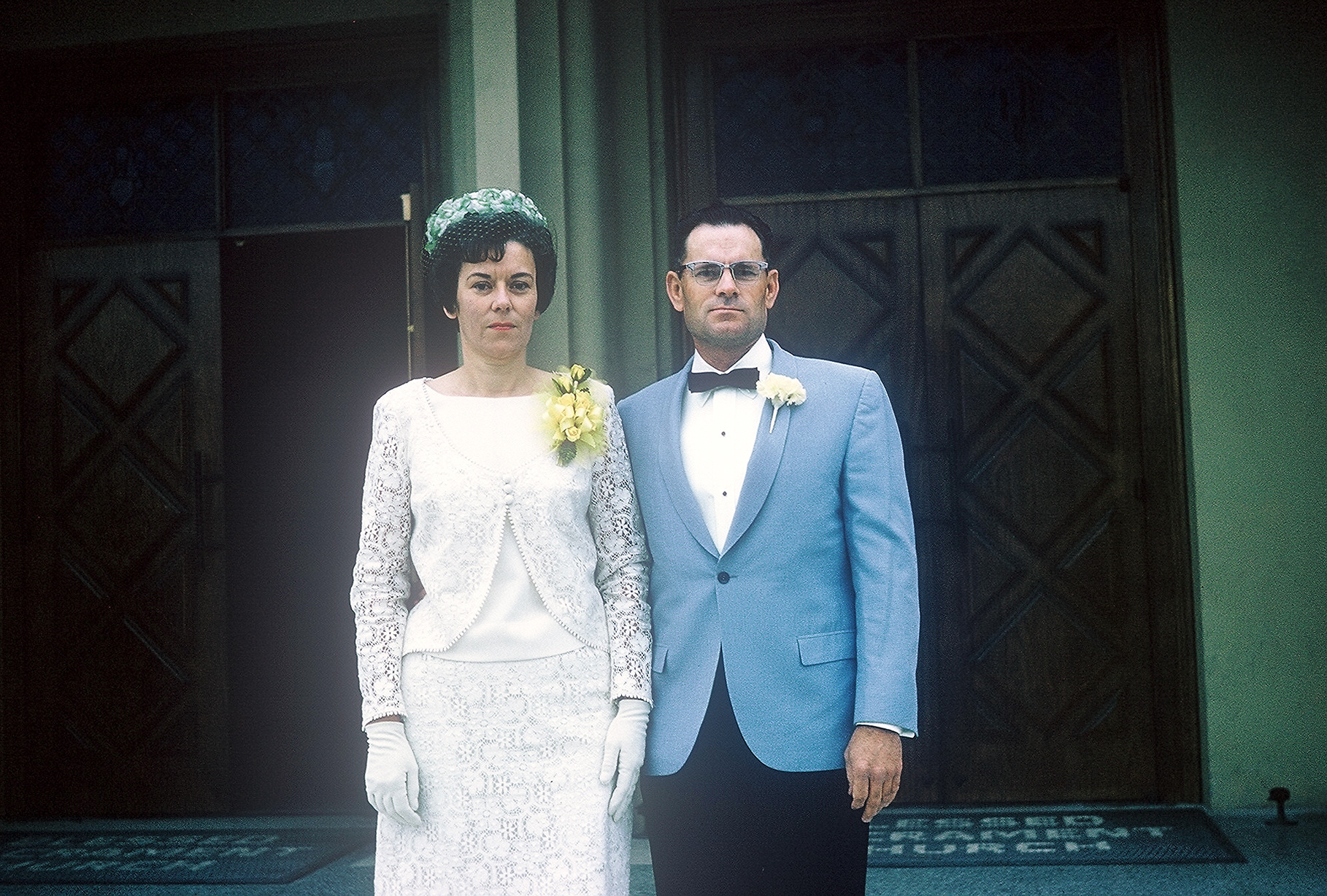
Barbara and Leigh, 25th Anniversary
I think it was later that year that we sold the house to Joe Feeney and family. They had 10 children, I think. So, the old house was home to the six kids in my family, the six of the Leigh and Barbara family, and ten Feeney kids. It sure has earned a rest! As of two years ago, Georgia Feeney was still living there. (2001) We bought a three-bedroom house from my brother, Alan. He had subdivided a parcel of the Sinaloa Ranch west of Madera Rd. He had hired Bill Bunker to build a dozen or so houses on some of these lots. His timing was bad, and he had trouble selling them. I think the house we bought had been rented out for two or three years. Our address changed from 1191 Capri to 1366 Los Amigos.In 1967 we bought a new Ford LTD, just in time to take Gerry and Katy on a trip to the Grand Canyon. Yes, the LTD did have an air conditioner! In fact, it was a very nice car, one of the first to be sealed and soundproofed, so that there was almost no road or wind noise. It drove and rode extremely well, much better that some bigger, more expensive cars of the era.We left right after the kids were out of school. Somehow, we missed the turnoff to Searchlight, so we arrived earlier at our campsite at Lake Mead. We must have gone into Las Vegas to show the kids the Casinos, but I donít have any memory of it. The next day we drove to Zion. Just as we started to set up our tent, it started to pour down rain. We stuffed everything in the car and made a mad dash to the lodge. I may have had to nudge a few people out of the way, but I managed to get the last available room! We took some short hikes the next morning, then set out for the North Rim of the Grand Canyon. We had decided to skip Bryce.The approach to the North Rim runs about seventy miles through the Kaibab National Forrest, on a relatively flat plateau. What I remember most is the miles and miles of Quaking Aspen. I had heard of Quaking Aspen, but never seen them prior to our earlier trip. That early in the year the campgrounds were not too crowded, so we found a nice spot, not too far from the Rim. We walked to a nice viewing area, took lots of pictures, and watched the sun go down. It is quite amazing to see the change of color in the canyon as sunset approaches. That show is only surpassed by the sunrise!The next day we drove forty miles north to the junction at Jacobís Lake. There we turned east, to cross the Colorado River at Marble Canyon. Along the way we could see some old cave dwellings in the cliffs. We also took a side trip to Leeís Ferry, at the lower end of Glen Canyon. This is where those that raft the river through the Grand Canyon start their journey. In the old days, before bridges and dams, this was the only place to cross the Colorado River with wagons for two hundred miles or more in either direction. Down-stream, at the very upper reaches of what is now Lake Mead, Pearce Ferry provided the next crossing. Barbara and I drove there and camped overnight many years later, in our first motor home.
(If I havenít already done so, I will write an interesting account of a Colorado River adventure in 1925, involving my two Grandfathers.)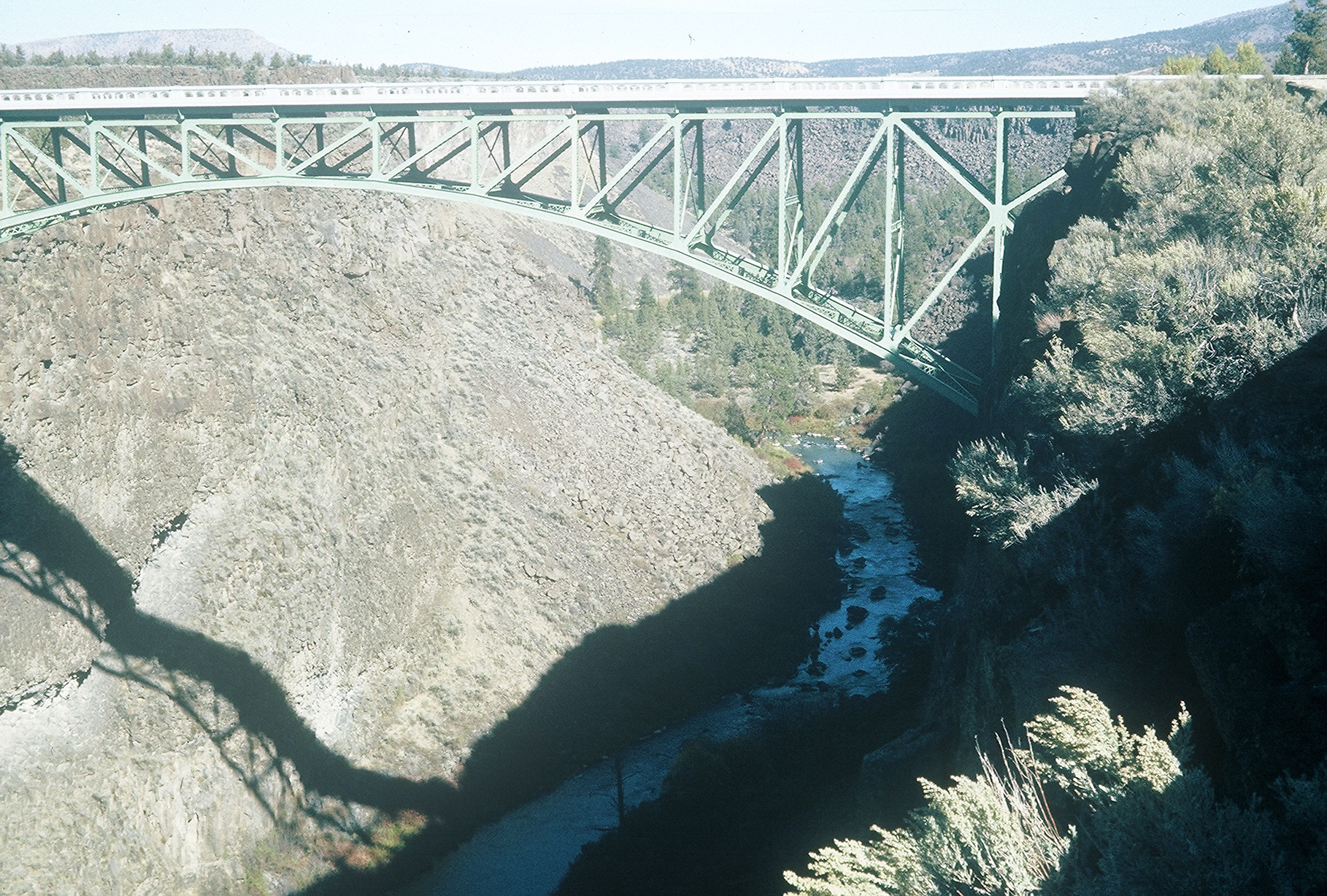
The Marble Canyon Bridge
Back on the main road, we soon came to Marble Canyon, on the Colorado River. Navajo Bridge, over this canyon had the distinction, at that time, of being the highest or longest bridge of itís kind. We crossed the bridge, turned south for a while, then north, to Page, AR, the town closest to Glen Canyon Dam and lake Powell. The dam was under construction when we made our first trip. We had debated driving out to see it, but decided instead to continue on to the South Rim. This time the South Rim was off the agenda, and newly completed Glen Canyon Dam and Lake Powell were definitely on! We went first to see the dam. I donít recall that there was any kind of tour such as at Hoover, no, make that Boulder, no itís really Hoover Dam. Nevertheless, it was a very impressive sight.
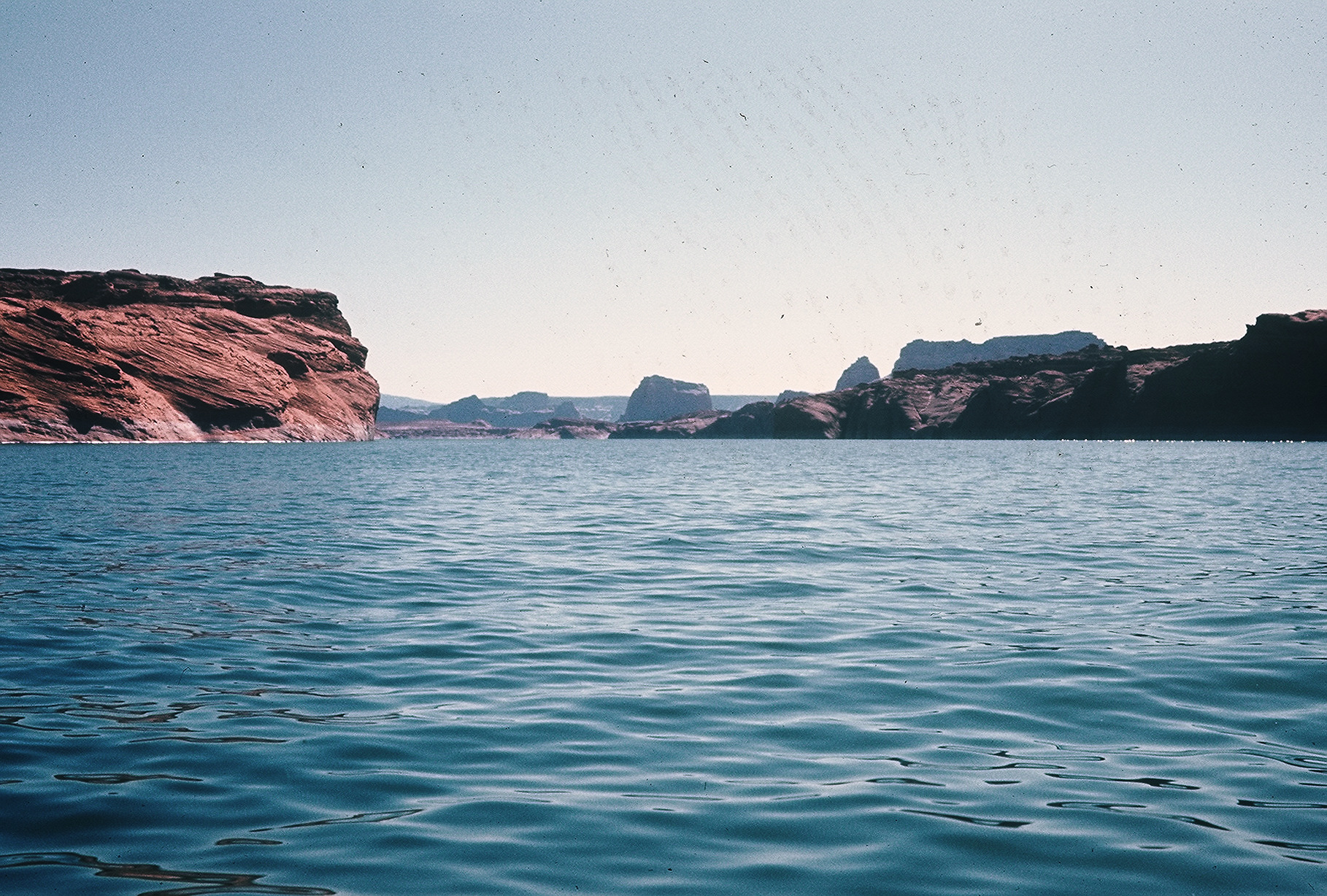
Lake Mead
Next we went to Wahweap Beach, campground and Marina. The sight of the lake, and all the boats coming and going, prompted us to walk out on the boat rental dock in hopes of renting a boat. The manager said that all the boats were out. We were so disappointed! We really wanted to get out on the lake. We turned to walk away, but only took a few steps before the manager called after us; "wait, I see one of my boats coming in!" We arranged to rent it for an overnight trip. I think our little craft was about 12 or 14 feet long, what Dad would call a skiff. It had an outboard motor, and two tanks of gas. I made certain that we had a good pair of oars and oarlocks, just in case. When we had stowed our tent, camp stove, some food and water, I fired up the motor and started to make my way out of the Marina. I saw a larger boat coming directly at us, so I moved a little to the right to let him pass. As we got closer, I recognized George Chamberlain at the helm of the larger boat. George was the older brother of my classmate of twelve years, Ralph. Georgeís wife Jean was also in my class. We had no idea that they were anywhere in the area. Sometimes it really is a small world! We chatted for a few minutes, then went our separate ways.Lake Powell is a rather amazing sight. It is over 150 miles long, with many, many side canyons, so that it has more shoreline than the State of California. The shores are almost all vertical walls of pink and red sandstone. We followed the shore to approach the dam as close as was allowed, then started upstream. The first canyon we came to was Antelope. We followed that until it got too narrow to turn around in. Without knowing what lay ahead, around the bend, I decided it would be prudent to turn back. The canyon walls must have been hundreds of feet high, and no wider at the top than at the water line.Returning to the main channel, we turned upstream, then into a large bay on the left. By now it was getting late, and I realized that finding a place to camp for the night might be a bit of a problem. This bay, Warm Creek, seemed to open up into some flat terrain, so we followed the shore on the left into a little cove, where we found a spot wide enough and flat enough for a camp. All the shoreline is nearly devoid of vegetation, so finding something to tie the boat to was not easy. Also, our campsite was just flat rock, and our tent required tent pegs and ropes to hold it up. I managed to get a couple of pegs into small cracks, and carried in some rocks to anchor the other corners. Even in the late afternoon it was very hot, so we all had a nice swim in the cool water. When it was time to retire for the night, Gerry started with his bedroll outside, with the rest of us in the tent. Sometime in the night Gerry had an encounter with a scorpion, or some sort of insects, so all four of us ended up in the hot and crowded tent. It was a long night!After breakfast the next morning, we stowed our gear in the boat and set out to do more exploring. We headed back downstream a bit, and then turned into Navajo Canyon. This turned out to be much wider and longer than the canyon we had explored the day before. When the first tank of gas was empty, I hooked up the other one, and headed back to the Marina. I was not anxious to use the oars. It had been a great adventure, even though we saw only a tiny portion of the lake.Leaving the lake we headed north-west, back into Utah by a different road. We detoured even farther north to drive through Cedar Breaks. The rock formations are sort of like Bryce, but for whatever reason, we enjoyed Cedar Breaks more than we had Bryce on the first trip. For one thing, it was at a higher elevation, and therefore cooler. Also, there was almost nobody there. As we were approaching the Breaks we stopped to play in the snow alongside the road. The weather was quite warm, but the snow had not yet melted. After getting back in the car, we wanted the Air Conditioner on, not the heater! After seeing the sights we went on west to I-15, and south all the way to Las Vegas, the last hour or so in the dark. This time we did find a motel with swimming pool. We got cleaned up, walked a block or two to an inexpensive buffet, came back and sat in the pool until bed-time. The next day was an easy drive home, a far cry from our earlier trip!In December of 1967 my folks took us on a trip to Los Mochis, and San Ignacio Bay. By then Danny and Terry had left home, so it was Barbara, David, Glenn, Gerry, Katy, and I. The three boys went with Tom in his Scout, leaving a week or so ahead of our group. Alan and his two boys were also in that group, in a separate vehicle. Dorothy, Barb, Katy and I traveled in Tomís pickup with a small camper on the back. We left from Simi, and drove to Tucson, where we spent the night in a motel. The next day we crossed the border at Nogales, safely navigating through Customs and Immigration. We spent that night at Guaymas. We surely must have had a shrimp dinner! The following day we drove to Mochis. I think we went directly to the Jordan home to see if the other group had returned from their trip south to Mazatlan. Tom, Mamie, and Ora Jordan were all there, but the travelers did not show up until the next day. Alan and his boys did not linger, taking off for home almost at once.
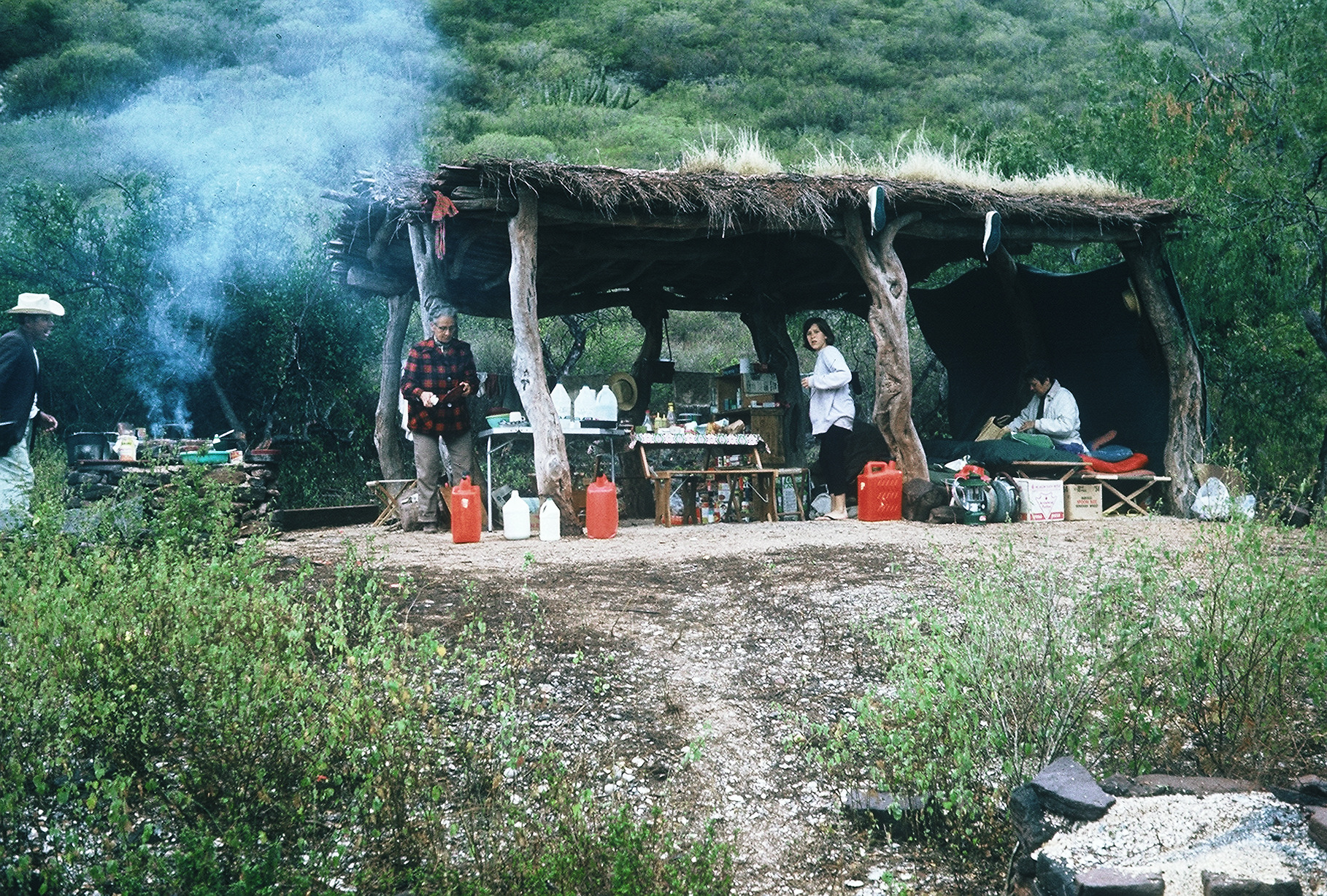
Our Camp at San Ignacio
The next morning we all drove to the little fishing village of Cabezon, on San Ignacio Bay. The sons of Tomís longtime hunting and fishing companion, Lino Jocobi, lived there. Soon after arriving, the boys noticed coolant leaking from the scout. I think one of the boys had hit an obstruction in the road on the way to Cabezon, jarring the radiator into the fan. We managed to get the radiator back in itís place, but two or three of the tubes were leaking badly. Using a pair of pliers, I managed to crimp the tubes, above and below the damaged area. About this time one of the ladies of the household offered coffee to anyone that wanted it. Barbara and I accepted the offer. Barbara probably didnít know, and I had forgotten, that Mexicans always roast their coffee beans in sugar. The brew from these beans is exceedingly sweet, and strong! Since neither of us had ever used sugar in our coffee, we just about gagged on the first swallow. I donít know what Barb did, but I carried my cup out to where we were working on the Scout. I picked my time and then quickly poured the coffee into the radiator. As I sit here writing this, I realize that another possible fix for the radiator would have been to put some coffee grounds into the radiator. As the water and grounds circulated, the grounds would eventually have found their way into the leak, thus plugging it. As Dad used to say, "There is always more than one way to skin a cat!" As I recall, we completed the trip without taking the radiator to a shop for repair.The folks had done this trip the year before, with one of the other families. At that time Tom contracted with his friends to build a small "ramada", or shelter, made of native material; mesquite poles and beams, brush of some sort for the roof and two walls. This ramada was on a small island in the bay, El Metate. This was our ultimate destination, and home, for several days. Leaving Cabezon was quite a chore. The dugout canoes that I had seen in 1936 had been replaced by fiberglass "Pangas", each about twenty feet long. Since the tide was low, we had to wade several hundred feet in soft mud just to reach the panga. Of course, all our gear had to be packed out the same way. Finally we were all in the boats, and most of the mud washed off our feet and legs. That accomplished, we were off for El Metate. The island is pretty much a jumble of volcanic rock, sloping up in a cone shape. On the northern shore is a small flat area of sand above high tide, with a sandbar extending out into the water, perhaps fifty or one hundred feet. On this little beach the Metate Hilton grandly awaited us. With guidance from Tom and Dorothy, we soon had a kitchen and small table set up. All of our bedrolls were spread out on the ground, some under the shelter and some not.During our stay we took one or more excursions to see the bay and some of the other islands. One day we took our lunch and went to the sheltered side of the long sand dune that is San Ignacio Island, which separates the bay from the ocean. In the shallow, clear water we were able to catch a few crabs to augment our lunch. We went somewhere on that island, possibly across to the seaward shore, to gather shells. There was a great variety of shells, and most of them miniature. I think Barb probably still has some of them. Another day our guide and boatman, Milesio I think, took some of us out to join the fleet of shrimp fishers casting their nets. Each panga had a man in the bow, casting his net, and a man in the stern to manage the boat. When a net came up with a good catch, all the other boats would gather in close to cast their nets. Milesio cast his net a few times, enough to gather a goodly number of shrimp for our table. When we got back to camp, a pot of water was put on the fire, and we were soon feasting on the freshest shrimp ever. There is such a difference in seafood that is that fresh.On the beach, Milesio demonstrated the art of gathering the net in a certain way, how to hold it, and the backhand method of throwing it so that it would spread out completely, into a circle of about twenty feet. These nets were hand tied, creating square openings small enough that shrimp could not get through. Around the perimeter were lead weights, to sink the net to the bottom. All of the strings came together in the center of the net, where they were fastened to a rope. About halfway between the weights and the rope there was a tab fastened to some of the strings. To prepare to cast, he coiled the rope in his left hand, put the tab between his teeth, then started gathering the net, just above the lead weights, in his right hand. The gathers were about two feet each, working his way all around the net. When he was ready to cast, he swung the net to his left, then with his arm extended, he made a wide sweeping motion, releasing first the net, then the tab, and as much rope as necessary. When done properly, the net will open to itís full diameter. This demonstration was for the benefit of the boys. He had each one take a turn at casting the net, with rather poor results. I was watching all this at a little distance. Milesio turned to me and told me to try my hand. I gathered the net as he had done, swung left, then right, laying it out in a perfect circle. He was quite surprised. Iím sure he thought it was a fluke, and challenged me to do it again. Now, Mrs. Robertson did not raise any stupid children. I replied that I had done it perfectly the first time, so there was no need to do it again. No use crowding my luck! It was not until the next day that I told Milesio that I had learned to cast an exact duplicate of his net from my grandfather, Dad Robertson, as a teenager. It was what you might call a "right of passage" to learn to cast the net, bait a hook, clean a fish and learn some basic knots. Until you mastered these things you were not yet ready to become an adult!
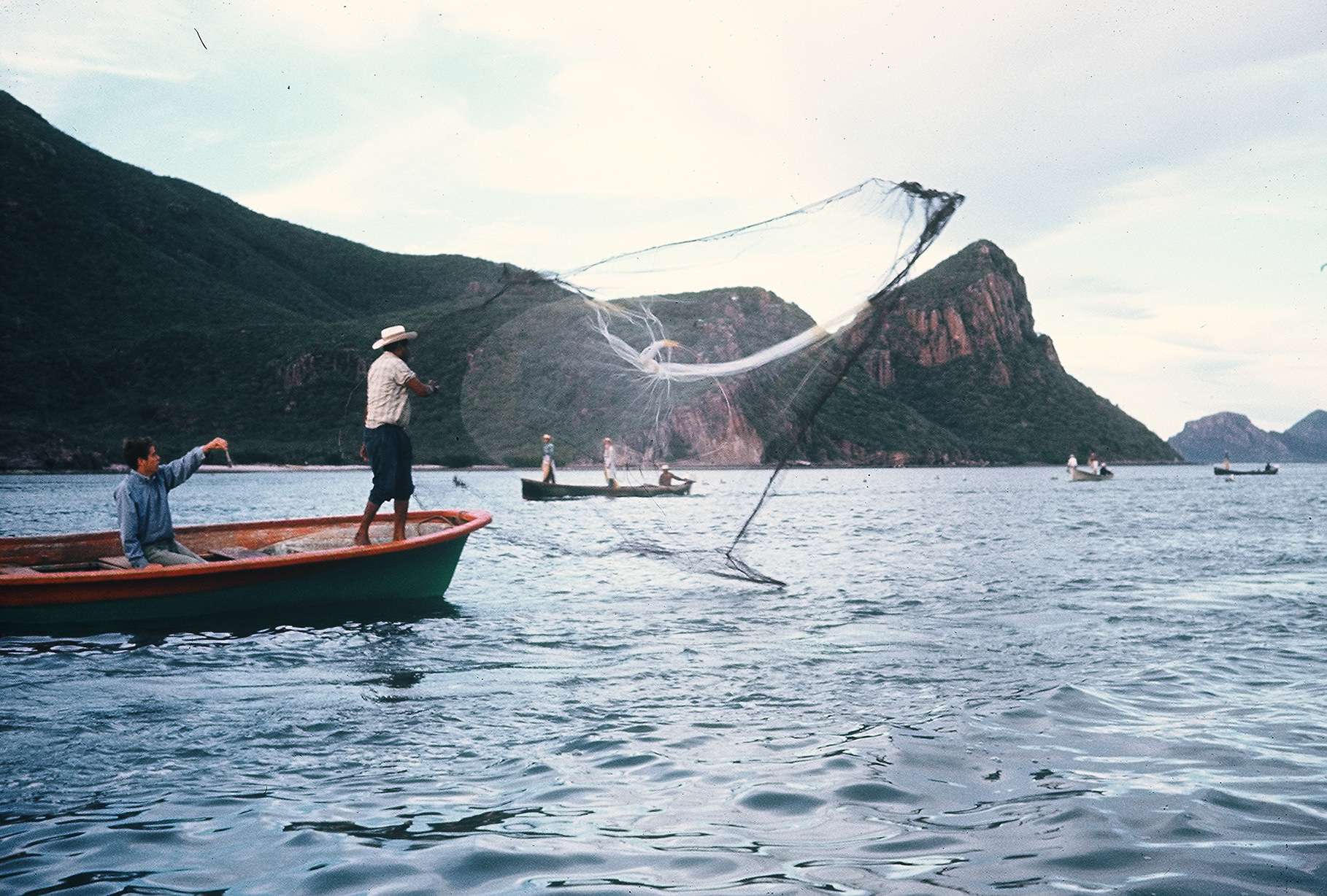
We timed our return to Cabezon with a high tide, so getting ashore was much easier. We returned to Mochis, where we spent at least one night. The Jordans had a gathering of all the old time Mochis friends still in the area.We left Mochis on New Years Eve. Instead of going north, we headed east, stopping briefly in El Fuerte. The folks knew the people that had the very nice hotel there. After a short rest, we drove on up the Fuerte River to the large dam that impounded water for the irrigation of hundreds of thousands of acres. Tom inquired about the road going north from there. He was assured that it went all the way to Alamos, which was on our agenda for the trip north, so we struck out on that little dirt road, for what turned out to be an adventure. From the end of the pavement in El Fuerte to the pavement in Alamos is about fifty miles, as the crow flies. However, for that entire distance we felt as though we were in a time warp, having been carried back a hundred years, or more. The terrain was low hills and small valleys, dotted with small farms that grew corn and beans. The houses were of adode or brush, always with an outdoor kitchen under a brush roof, or "ramada". On the farms, the only vehicles were pulled by horse, mule or donkey. The corn-cribs were built on poles, high enough to keep the grazing animals out. We went through several small villages, where there were apt to be one or two pickup trucks.
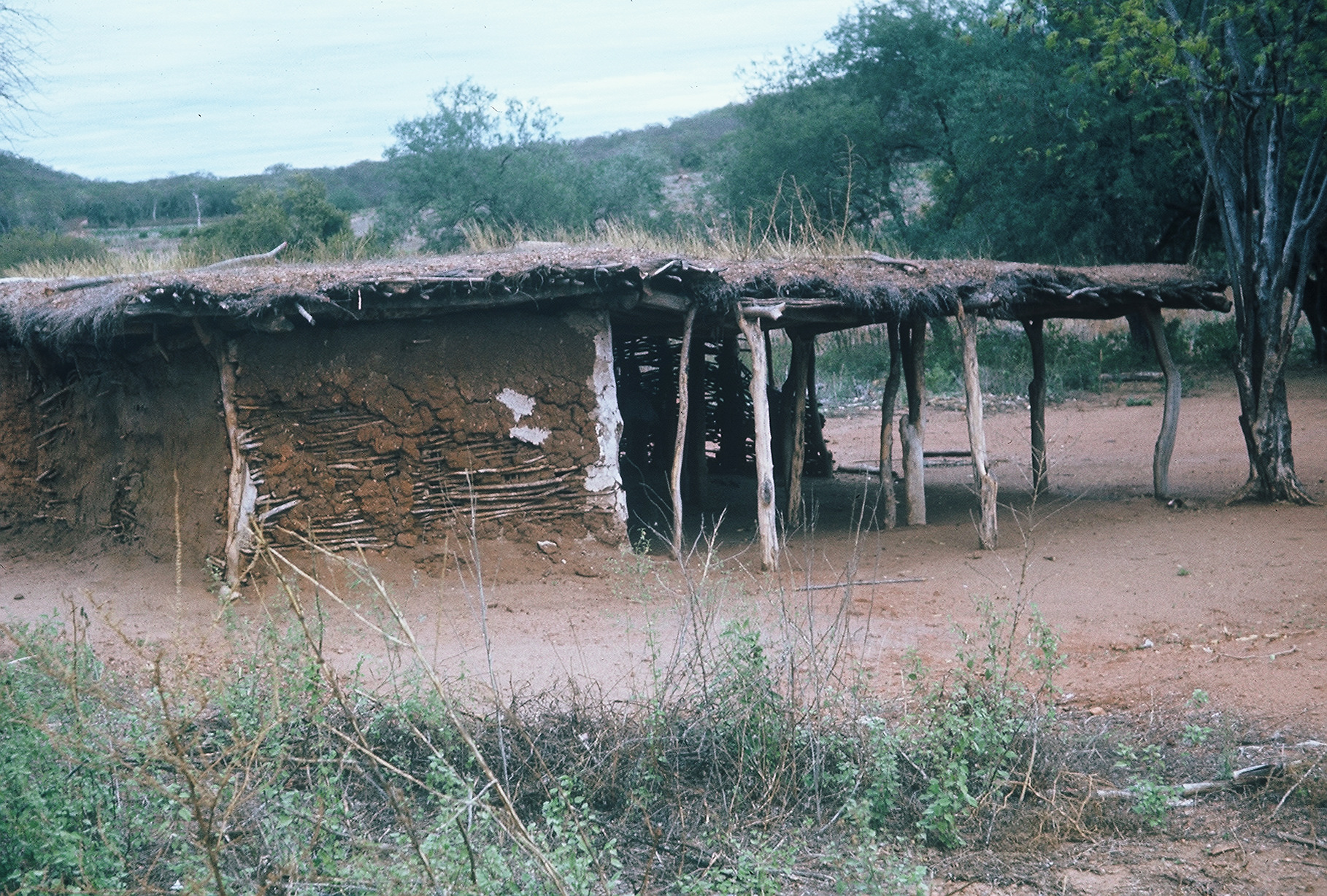
Typical Farm House
In the largest of these villages we found a baseball game under way in the large village square. Tom did much inquiring about the road ahead, as there were many branches, and none of them well traveled. Little by little we figured out that the vast majority of these people had never left their isolated area to go to Mochis, El Fuerte, Alamos or Navajoa. All of these thriving communities are within a hundred miles of their mountain fastness, but they just felt no urge to leave. Most of the men who had traveled to Alamos had done so on horseback. The horse trail was usually more direct than the meandering road. These men had very little knowledge of the road. Another interesting thing was that they estimated distances not in Kilometers, not in Miles, but in Lequas, or leagues. This is a term used by the Spaniards who first explored this country. I think it is equal to about two and a half miles. By late afternoon we decided to make camp for the night. We cooked and ate our meal, and were preparing to retire when we heard singing in the distance. The voices grew louder, and finally passed by our camp. There must have been a dozen people in the group, men, women and children. Most were walking, some road in the two wheeled cart pulled by a mule. They were headed into the last village we had passed, to celebrate the New Year. The one thing that was totally out of place was a gasoline-powered generator in the cart. It was to be used to provide light for the festivities! Shortly after settling into our beds, it started to rain, and not gently! I conferred with Tom, and we decided we needed to break camp and leave as soon as possible. We were in country that was subject to heavy rains, and traveling on mostly red clay soil. If we got trapped there we might be a long time getting out. We threw everything in the vehicles and took off, Tom in the lead. He seemed to make all the right choices at the forks in the road. It wasnít too long until the condition of the road indicated we were approaching Alamos. The folks knew the manager of the only hotel in town, so we went there to get some rooms. Alas, there were no rooms at the Inn, but we did not have to spend the night in a barn! The hotel manager suggested that we go to the home of Mr. Otto Skutt. Otto was a close friend of my Uncle Jimmie Utt. In fact, he maintained a small cabin for Jimmie on his property. I believe that the folks knew him slightly, through Jimmie. After much pounding on the gate we managed to wake someone inside. It was the man that worked for Mr. Skutt. He and his family lived in one wing of the house. Tom explained who we were, and the connection with Jimmie Utt. That was enough to prompt the man to wake Mr. Skutt. We were welcomed immediately, even though it was by now nearly midnight. Otto directed his man to get fires started in three bedrooms for us. What a royal welcome!I should explain that the town of Alamos sprang up near what had been, at one time, some of the richest silver mines in all of Mexico. So much silver was produced here that the Federal government had a mint on the edge of town for making the coin of the realm. The mines created great wealth for many people, and for the town itself. A grand Palacio Municipal, or government center, was built; also a beautiful Catholic church, fronting on the central plaza so typical of old Mexican towns. The gazebo in the plaza is a work of art in itís own right. Some of the main streets are of decent width, while some of the side streets are so narrow that two cars cannot pass each other. The houses of the wealthy were typical of the times. Each house was a totally enclosed compound. The walls were built right to the street, with no sidewalks. The only entry was a gate wide enough to accommodate a buggy. The outside walls had no doors, and few windows, facing the street. The rooms were all side-by-side around a patio in the center. A porch running in front of the rooms served as a hallway. There were nearly no doors from room to room. Besides the main quarters, there were servantsí quarters, and, depending on available money and space, there might be some stables for the horses, with another gate to the outside.
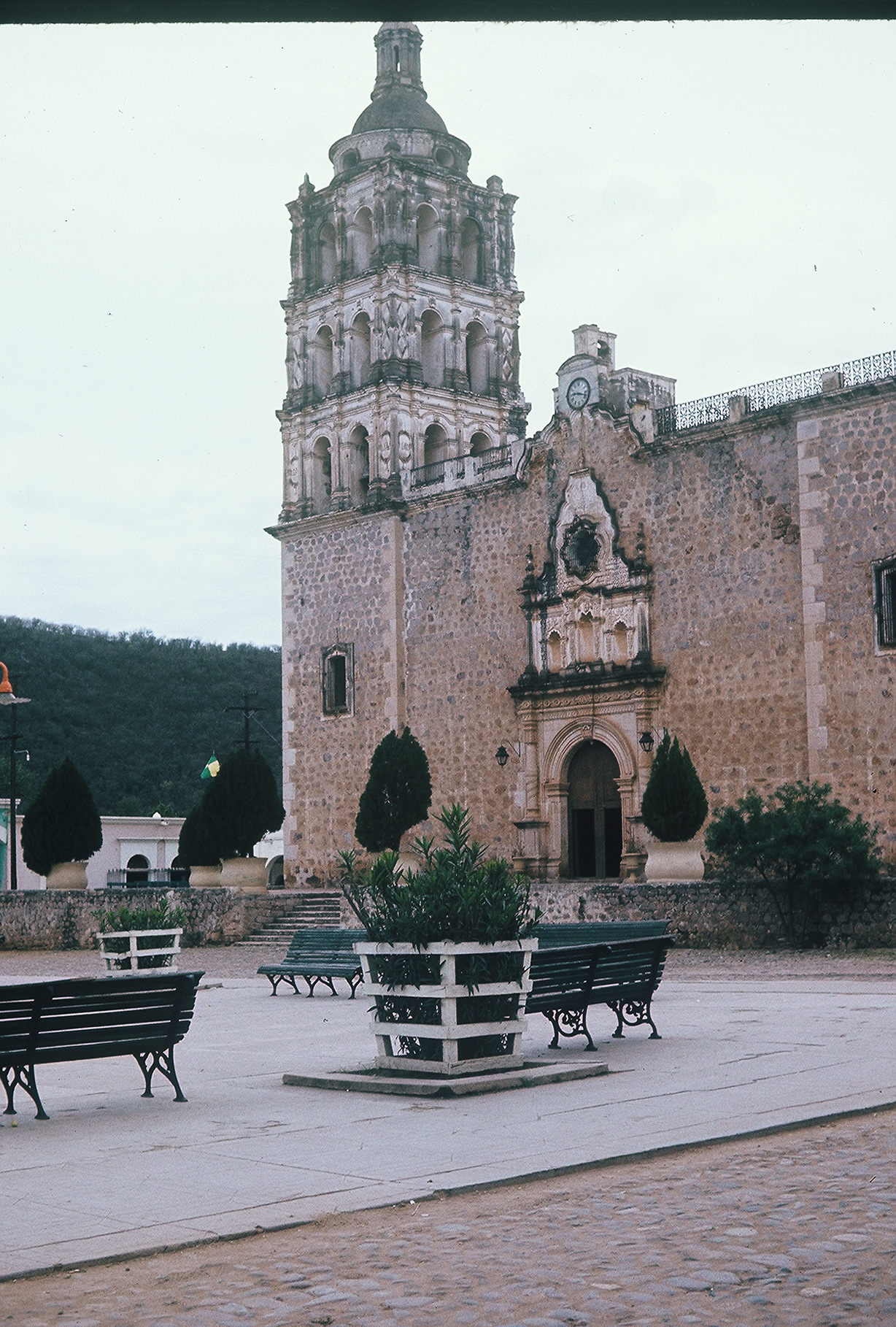
Plaza and Church
I donít know the time frame of the heyday of Alamos, nor when the silver mines were exhausted. My guess is that the town went into decline about the early 1900ís. Eventually, it became a typical, or perhaps atypical, ghost town. It had a much longer run than our ghost towns here in California. Therefore, the structures that remained were of much grander scale, and more resistant to decay. At some point, probably about 1940, or maybe later, it was "discovered" by people from the U.S. Little by little, those with a little money started to buy the old houses and restore them to their original state and elegance. I believe that Uncle Jimmie Utt bought one of the old houses, but his wife, Charlena, wanted no part of it. So, he eventually sold it. Iím not sure, but I think it was this house that Otto Skutt purchased.After a good sleep, we were fed a wonderful breakfast, and had a good visit with our host. He told us that he had operated some kind of business in Los Angeles. Sometime after he lost his wife, he took a trip to Mexico. When he visited Alamos, he fell in love with it. He went back out to Navajoa, (no phones in Alamos at the time) called his sons and told them to sell his business, and wire the money to a bank in Navajoa. He had never returned to the States in the ten years or more since he first came to Alamos. I think he was eighty years old when we met him. He and his helper had done all of the restoration of the old house, including making all the tile for roof, floor, and ornamentation. Since his home was sort of on the edge of town, the enclosed compound was much larger. The main gate opened up into a very large open area. All the front wall and parts of the two side walls were living and storage quarters. Jimmieís cabin stood alone in a back corner. In the other corner was a corral and stables for two riding horses. He told us that on a typical day he and his helper would be up at daylight, saddle the horses and ride out into the hills for two or three hours. When they returned, they ate breakfast, and then started the dayís chores, whatever they might be. The workday ended when the work was done. He said, with a great deal of satisfaction I might add, that he was so busy doing nothing that he did not have time to do it all! I think of Otto Skutt whenever someone asks me what we find to do in an out-of-the-way place like Mariposa. My response is something like Ottoís. "Well, not much of anything, but we keep busy doing it!"
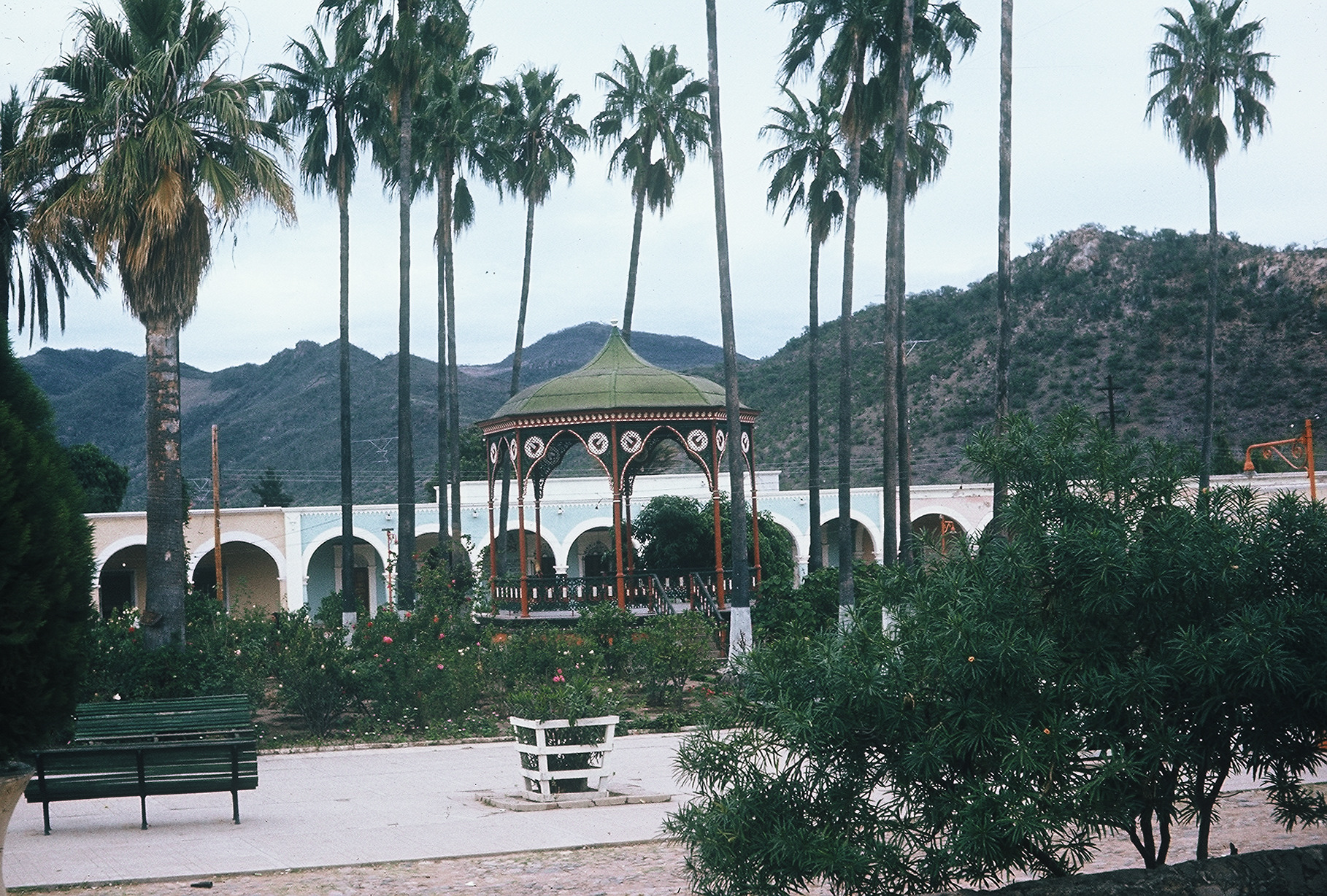
Plaza and Gazeebo, Alamos
After a little looking around in the town of Alamos we drove to Navajoa. No visit there is complete without going to El Mercado Central. At that time it was all enclosed in one very large building. There were dozens of stalls where one could buy just about anything imaginable. We bought a few food items for our evening meal, and headed north again. I think we made two overnight camps on the way home. The first was south of Guaymas, and the second was in the desert south of Sonoita. I also remember having to hire a tractor to tow us across the Magdalena River, which was rather deep because of heavy rains.The changes in Sonora and Sinaloa since my trip in 1936 were quite startling. The changes we saw on our most recent trip, in 1999, were equally as startling. See "Trip to Sinaloa, 1936" and "Trip to Los Mochis And Copper Canyon, 1999" Sometime in the late sixties Barbara announced to me that she had taken a part time job at the Sears Catalogue Store in Simi. She had talked about working off and on for years, but I always discouraged her. Looking back, that was rather selfish of me. I think that I just didnít want people to think that I could not support my family. This time she did not discuss it with me, she just did it! I think that at that point I realized a couple of things that should have been obvious. First, I had no right to tell her she could not do what she wanted to do, and second, this was something she wanted to do for her own self esteem. She started before Christmas, as a temporary part time worker. After Christmas her boss put her on permanent part time. She went to work after dropping Katy off at school, and was home when Katy came home. Her job was to take orders, either on the phone or at the counter. Soon enough, her boss realized that her maturity, ability and dedication set her apart from the mostly teenage girls working there. He gave her the responsibility of gathering all of the individual orders, calling them into the warehouse, then checking in the deliveries. She also got a nice raise. Things went well for a few years, until she got a new, younger boss. He decided that she was being overpaid, and set about making life miserable for her, to the point that she had to quit. She was terribly angry and discouraged. I felt so badly for her. I should not have worried! She soon had another job, at Simi Stationers. After a couple of years, she changed again, this time working for a Florist Shop. She really enjoyed that. She worked with a friend from high school, Ruth Flanagan, and the owners were very nice people to work for. There was one drawback to this job, and that was that before most holidays everyone worked long hours, sometimes Ďtil midnight or later. I think she worked about eight years, all in all. An interesting note is that except for her last year at Sears, she was never paid as much as I paid my workers when I farmed.
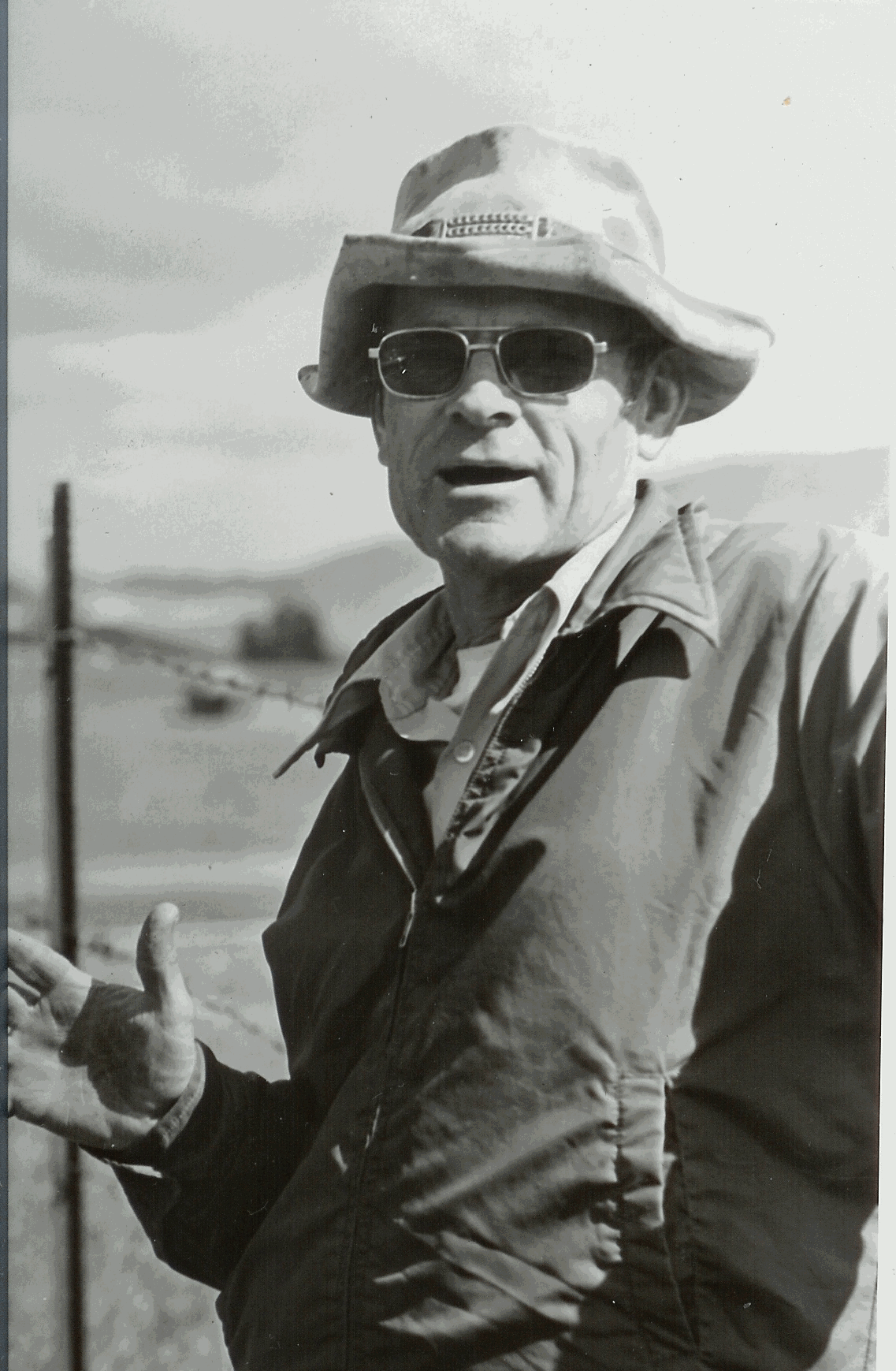
Leigh, in farmerís uniform
Barbara saved most of her earnings, which she eventually used to buy new furniture for our newer house on Los Amigos. We also got new carpeting, and did some wallpapering. I think her money paid for most, if not all the improvements to that house. We had a block wall put up between our neighbors, Luis and Josephine Sanchez and us. We split the cost of that, and I also had the wall extended to close in the back of our lot. I had a slab poured on part of the back yard and then built a roof over it. I installed sprinklers in the very small front yard and large side yard, then planted lawns. Soon after I started farming Gerry decided that he wanted to live on his own. He rented a small house and moved out, leaving a vacant bedroom. I put wood paneling on the walls and made the room into my office. I moved my metal desk in, and also a two-drawer filing cabinet. We put a small sofa in that room as well. I also bought my first electric calculator, which was invaluable for doing payroll. Katy got married sometime about 1974, to Dave Garcia. They lived in Lodi, CA. Dave was an aspiring baseball player. He played on a minor league team in Lodi. The marriage only lasted about a year, and then Katy came home to live. She got into the CETA program, and learned the skills she needed to be a secretary. After a year or two in school, she got a good job in Westlake.It was more or less the same time that Gerry took a long trip to Europe. Barbara had found a book about cheap travel in Europe, and that sort of inspired him to go. He took only a backpack, and was armed with a Eurail Pass, and a directory of Youth Hostels. We took him to LAX to start his adventure. I canít say for sure, but I think he was gone for three months or so. He did a lot of growing up on that trip!
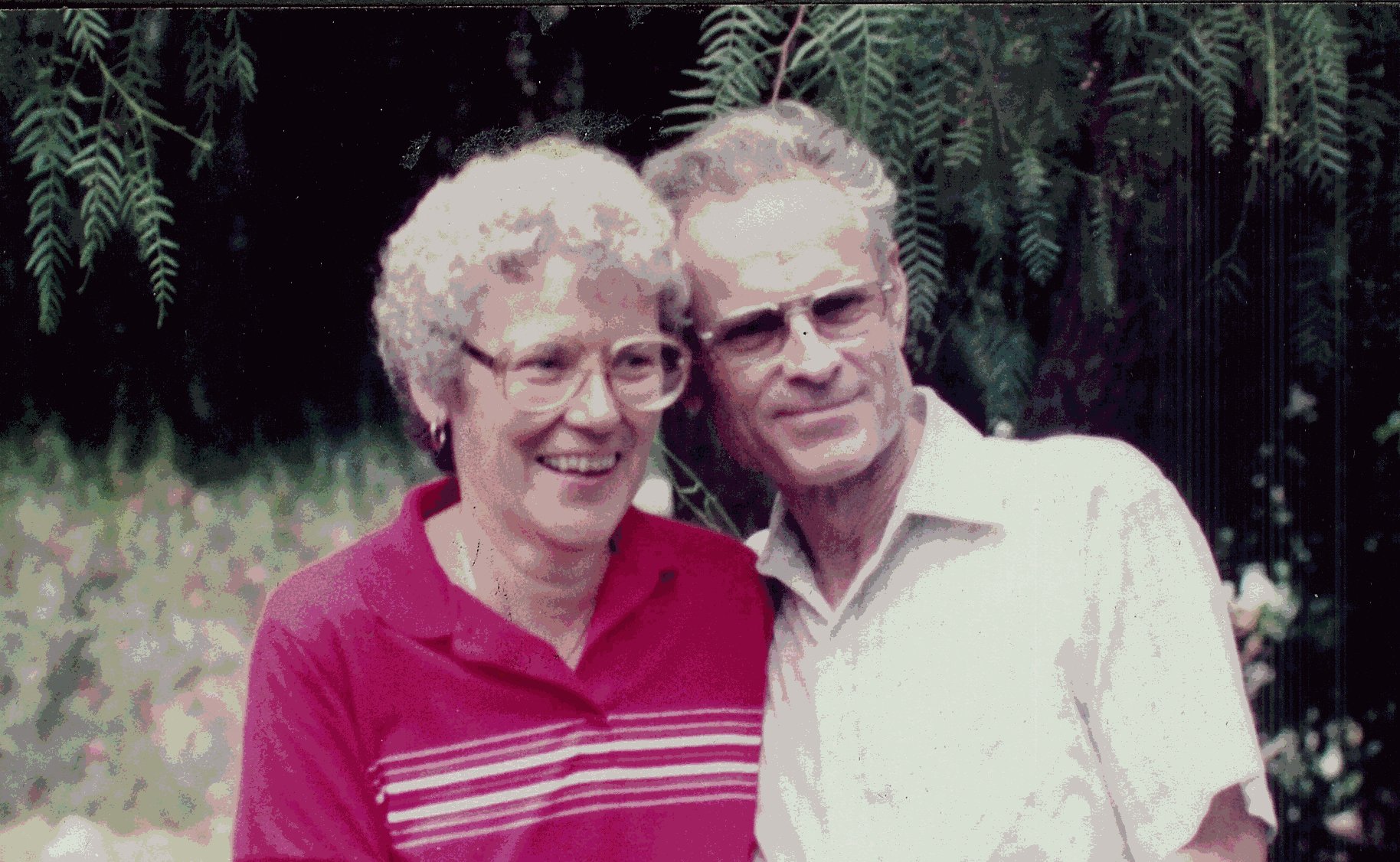
Barbara and Leigh
When Gerry returned from Europe, he went to work for me again, and also started a little farming of his own. He also got married a year or two later.When Katy got married, she was the last of the brood to leave the nest. We didnít talk about it right away, but both of us were very filled with all sorts of emotions when all the children were gone. For my part, I had guilt feelings for not having spent more time with them, not having done more things with them, not having prepared them better to face the world. Time pretty well healed those wounds. We realized that they were all facing the world pretty well on their own. Also, doing the writing that I have done in these past few years has been therapeutic for me. It has helped Barbara to go back and type all the letters she wrote her mother during the child rearing years. We realized that we were O.K. parents after all. We surely have the love of our children as living proof of that! Any, or all, of our children would be my first choice to share a new adventure with!
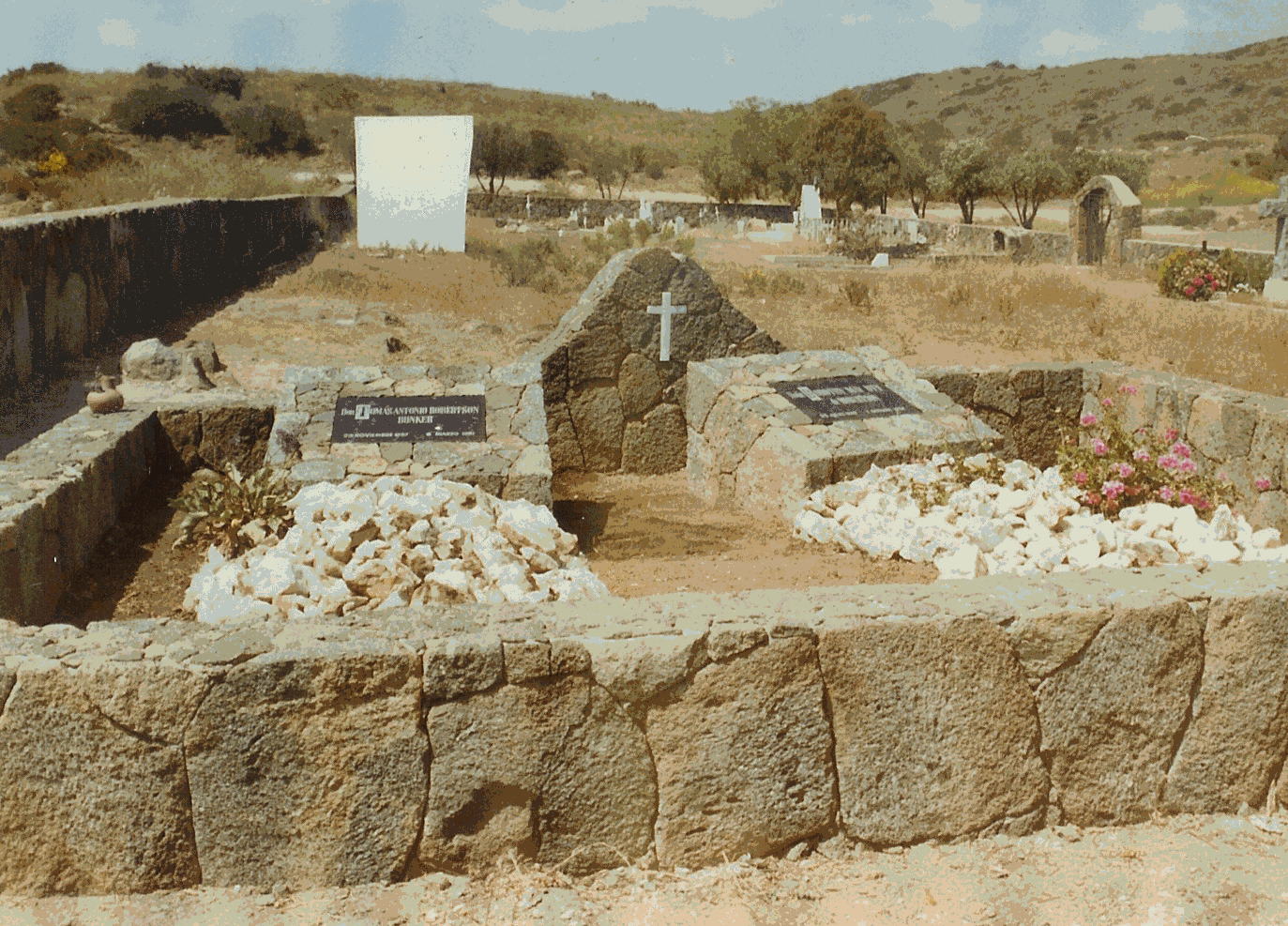
This is the final resting place of my parents, Thomas A. and Dorothy
M. Robertson.
Villa de San Miguel, Baja California Norte, Mexico
About 1970 or so, my brother Alan and his second wife, Dorothy, moved to the Paso Robles area. My father asked me to take over the affairs of Sinaloa Ranch.Actually, there was no farming going on at all. It was just a matter of selling off a few remaining parcels of land. One fifteen-acre parcel was already in escrow when I took over. When I looked over the terms of the sale, it seemed very Mickey-Mouse. Tom told me that I should go ahead with it, so I did. When the first payment came due, I had to foreclose, and start over again. Meanwhile, we had released a portion of the land, according to the sales agreement. I managed to sell the remainder to a sub-divider.We had one view lot on Sinaloa Lake, which I sold to a doctor down the street from us. The last parcel was thirty plus acres of abandoned walnut orchard, in the canyon south of Sinaloa Golf Course. A young man that purported to be a developer approached me. He wanted cut it into half acre lots and build houses. After a bit of haggling, I got my price, and the deal was closed. Soon after that I learned that he was only representing some of the Montgomery family, who owned the large ranch south of Sinaloa Ranch. It seems that they wanted to create a subdivsion on several hundred acres of that ranch. Because of the size of the project, they were required to have a second entrance. Our thirty acres would give them access to a county road. I had known all the Montgomery family since childhood. I never did understand why they felt it necessary to hire someone else to make this deal. Anyway, I got a good down payment and collected two annual payments. The plan for the Montgomery development collapsed, and once again, I had to foreclose. In truth, in both of these cases, the buyers voluntarily signed Quitclaim Deeds, which meant that I saved the expense and time required for foreclosure.Soon after that the Ventura County Flood Control District purchased the land for the construction of a large flood control dam that impounded water from two canyons, during the highest runoff, then released it slowly.My other responsibilities were to do some record keeping and get a Partnership Income Tax return to the IRS and the State of CA. Alan had been using an accountant in Ventura. After one year with him, I collected all the records he had, and sorted them out the best that I could. I turned over the tax preparation to my accountant in Oxnard, and we got them filed on time, for a change. The income from land sales was mostly turned over to my folks, but some years there was excess to be distributed to the six children. At some long ago point in time the folks became concerned about inheritance tax on the ranch if something were to happen to them. To ease that burden, they started gifting small interests in the ranch to each of us. It eventually worked out that Tom owned 40%, Dorothy 9%, and each of us 8.5%. This ownership was on paper only. We all understood that the folks should have all the income that they wanted, or needed.Another thing I did during those years was to help my parents make new wills. I took them to my attorney in Oxnard. They asked me to be executor in both cases.In the mid seventies Barbara and I started thinking of buying an RV of some kind. We bounced back and forth between a camper, trailer, or motor home. After much looking and discussion, we bought a small motor home; a 22-foot Monaco. A couple of years later we sold the Monaco and bought a 26-foot Apollo. In 1980, we bought a Toyota Pickup to tow behind the Apollo.
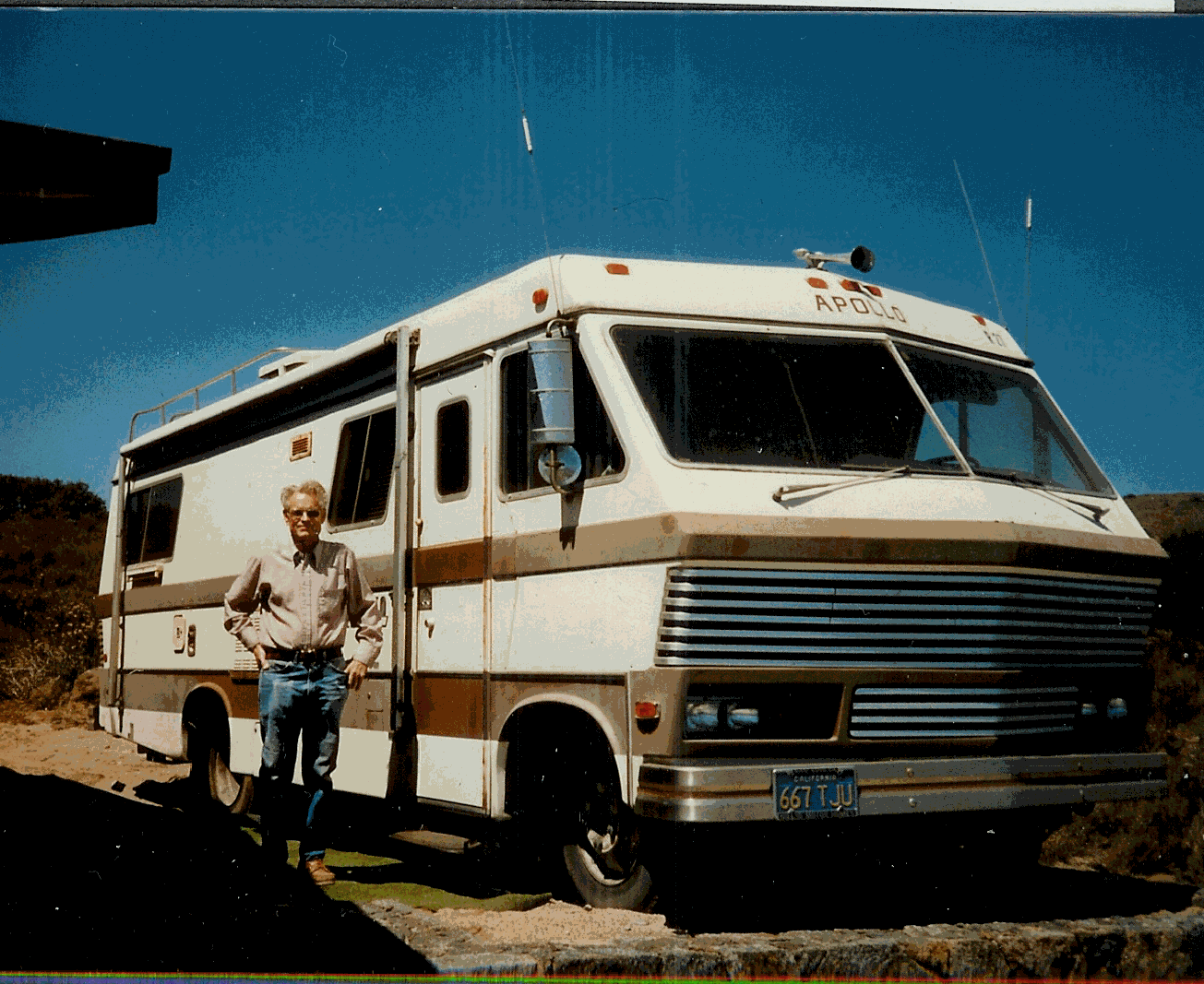
Apollo Motor Home, probably the most extravagant thing we ever did!
Some day Iíll get around to writing about some of the great trips we had in our two Motor Homes.We lost Barbaraís father, Pop Wilson, in 1979. We all felt his loss greatly. He was such a kind, gentle man. All of our children have fond memories of both Mom and Pop Wilson. They had both been teachers by profession, and they taught our kids lots of things. Pop had named the trust department at Bank of A. Levy as executor of his will, so that none of his children would have that burden. Nonetheless, it fell to Barbara to go through all the personal things and dispose of them. She was on his checking account, so she kept all his bills paid up to date. We went to the bank where he had a safe deposit box, and managed to get the things out of it, not that there was much of any value. We were not supposed to do that without having a tax appraiser present, but we just didnít let on that Pop had passed away. The branch manager was Popís neighbor, and of course he new the situation. As soon as he saw us coming, he walked to the far end of the bank, so that he wouldnít be a witness to what we were doing! We became quite upset with the Trust Dept. They seemed to take forever to settle what should have been a very simple estate. Finally, I got them to make a preliminary distribution so that we could sell the house. Barbara and I cleaned it up, put a sign out in front, and sold it rather quickly. It took the Trust Dept two full years to finally make the final distribution. That experience sure soured me on having an outsider handle these matters!By 1980, I had decided that I could no longer farm. I really was feeling miserable. I had disposed of all the Sinaloa Ranch property, my folks lived in Mexico, and Barbaraís folks were gone, so there was very little holding us to Simi Valley. So, we started thinking of where we might want to re-settle. One of our objectives was to get out of the smog, thinking that I might feel better. Tom had given us a lot at San Miguel, on "Magic Mountain." (so named later because it was constantly moving and falling into the sea) We talked some of building a small house there, and getting a small place in Oregon, so that we could drift back and forth according to the seasons. Another place we looked was the Hemet area. One trip down there was enough! The smog was worse than Simi, and there was nothing about the area that appealed to us.
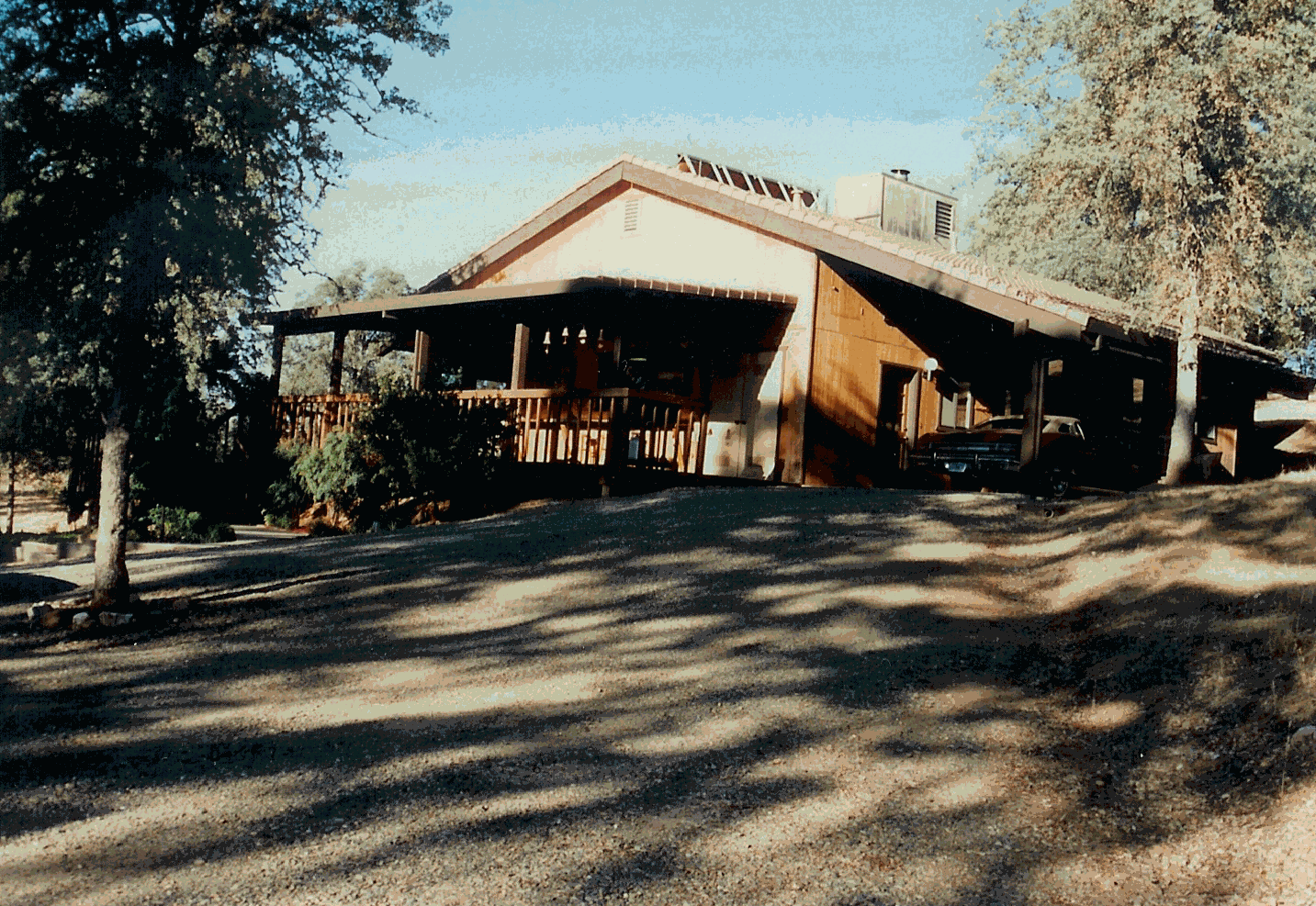
NE corner of the house we had built in Mariposa
Our long-time friends, Fran and Ralph Chamberlain, owned a couple of small parcels of land in the Lake Don Pedro area, near Sonora in the Mother Load country. They invited us to spend some time with them at the campground at the Lake. They had a trailer at the time, and we took our motor home. While we were there, we took some short trips out and about, to visit some of the towns. After that we started north on Highway 49 in our rigs. We stayed a night or two in the Fairgrounds in Angels Camp, and took more side trips from there. One place that we really fell in love with was Murphyís, a few miles east of Angels, on Highway 4. It was a very small, old town, with a nice restaurant and hotel. We were so intrigued that we went back a second time, and made some inquiries about places for sale. I donít seem to remember how far north we explored on 49.Next we headed south, ending up with some other friends, Mark and Mary Lou Montoya, in Bootjack, just south of Mariposa. When we started home, we were traveling alone. As we went through the little town of Ahwahnee, north of Oakhurst, I remembered that our long, long time friends, Bob and Elaine Cannell lived there. I stopped at the little Post Office, and after considerable persuasion, got directions to their house. They were not home, but I left a note telling them that I had "borrowed" some of their nice apples. During this entire trip, I seemed to feel much better than I had at home, so we decided that maybe we should look in earnest for a place to live somewhere along Highway 49.Sometime in the winter of 1980-81we decided to spend some time looking for a home to buy. The plan was to start in Mariposa, and work our way north. Iím not sure why we didnít park in Montoyaís yard, but chose instead to park in some large parking area in town, near the Minerís Inn. I knew that Bob Cannell had been in the real estate business, so I got in touch with him. By this time they were living near Ponderosa Basin, closer to Mariposa. He told me that he was no longer active, but put me in touch with a lady from their church. She drove us around and showed us several houses that were for sale. As we drove, she said that it was lucky we came in the winter. She said that many people that bought in the summer chose the higher elevation, because of the pine and fir trees. Then when the snow started to pile up in the winter, they regretted their decision. I told her I did not want to shovel snow, so that limited our choices a bit. We really didnít see anything that was interesting to us. We had not planned on building, but that started to look like more of an option. Mark drove me around one day, just to get me acquainted with the different areas. We looked around at Mormon Bar, then drove out Old Highway. Mark said that Strathearn Bros. had a nice subdivision that we should look at. As we drove through on Bridgeport Drive I spotted what looked like the ideal lot. We then went to George Strathearnís house, but no one answered the door. Later in the day, I called and Georgeís sister Joan answered. I guess I should point out that the Strathearns were from Simi. Joan was a year behind me in school; George was two years behind, in Raeís class, I think. Doug was the youngest.
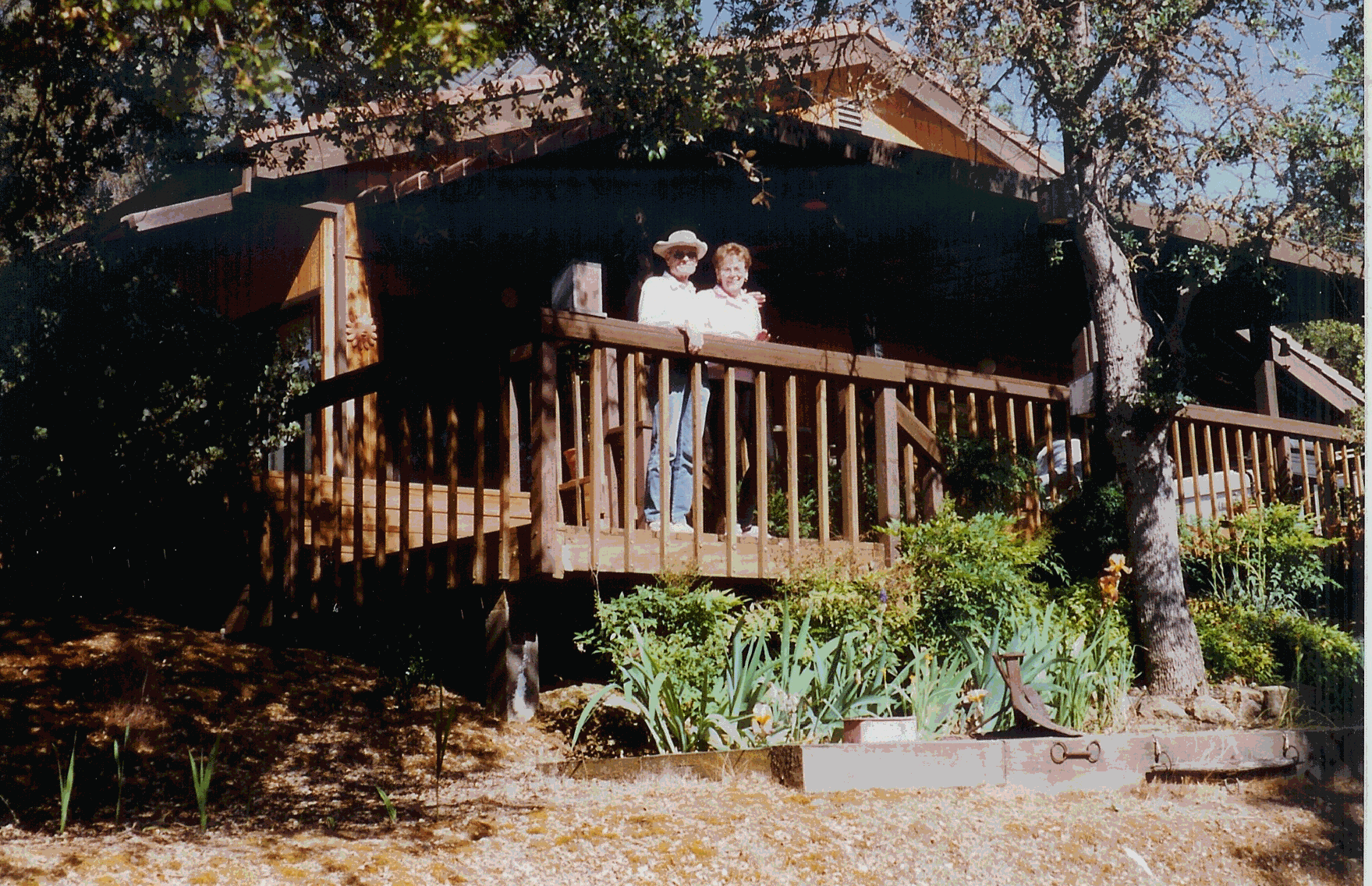
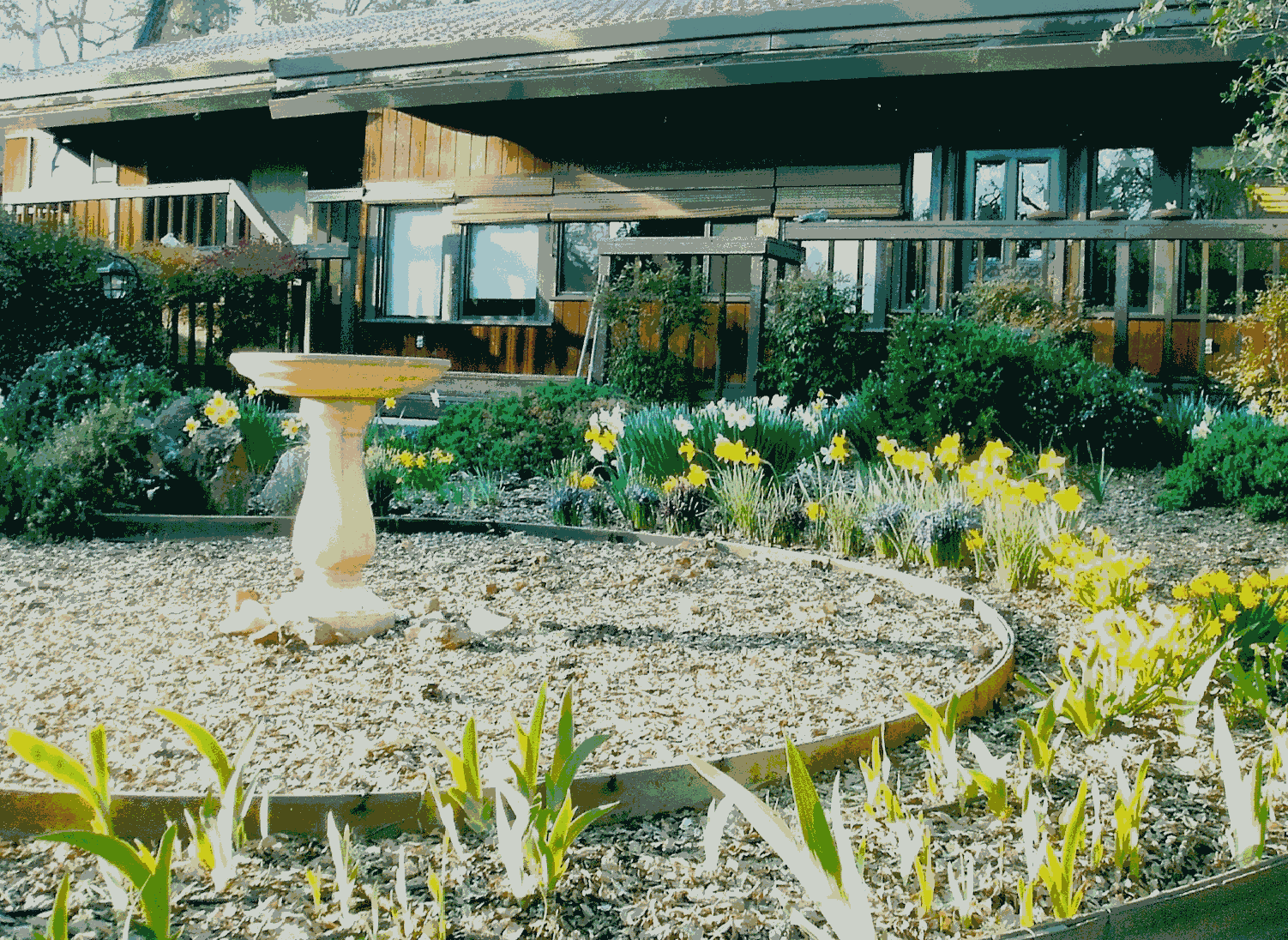
Front Yard Covered Deck
I drove back and had a long visit with Joan. She told me that George was working for the State of California, in Sacramento. She said I could catch him on the weekend. We got in touch by phone, and I met him at the house for breakfast on Sunday. Later, he drove me around and showed me the unsold lots that he thought might interest me. There were plenty to choose from. He suggested that we park the motor home on one of the vacant lots, so that we could take our time in picking one that we wanted. So, we did just that. Barbara and I drove around in the pickup, stopping to walk around on the lots that looked interesting. We decided against the lot that I had liked on the first day. It was on the edge of a steep hill, and had very little level ground, and that was quite close to the road. The view was great, but we thought we needed more space, considering the motor home. Besides, a house at the top of a hill is very much at risk in case of a brush fire. One morning I went out on foot to walk some of the lots, and discovered a nice large meadow, with Oaks and Bull Pines all around. . I took Barbara over to look at it, and we decided that it was just what we wanted. George had not shown this lot to me, so I didnít know if it was available. I called him in Sacramento, and found that it was, and the following weekend we made a deal.As I mentioned, we had planned to look farther north also, but it just seemed like there was so much to chose from in Mariposa, that looking farther would just confuse us! In retrospect, it was a good decision. Most of the family was to the south, so going another hour or two up the road would just make it that much harder to get together.About this same time, my father became quite ill. We drove our motor home to San Miguel, and stayed there for several weeks. Tomís good friend, Dr. Etchegeray came to see him every day. He told us that his heart was failing. Rae was there during this time, and Merilie at the end. Tom died March 6th 1981. He was buried in the little cemetery on the hill overlooking Villa de San Miguel. He and Dorothy had chosen their last resting places some years before. He had a traditional Charro funeral, with all of his Charro friends on horseback, in their finest gear. There was also the rider-less horse, Tomís own saddle horse. Once the cavalcade reached the cemetery, tradition demanded that the horse be unsaddled and released, since his work was done. Dominican Fr. Walsh gave a very nice tribute to my father, and then went off to the top of a little hill, to grieve by himself.
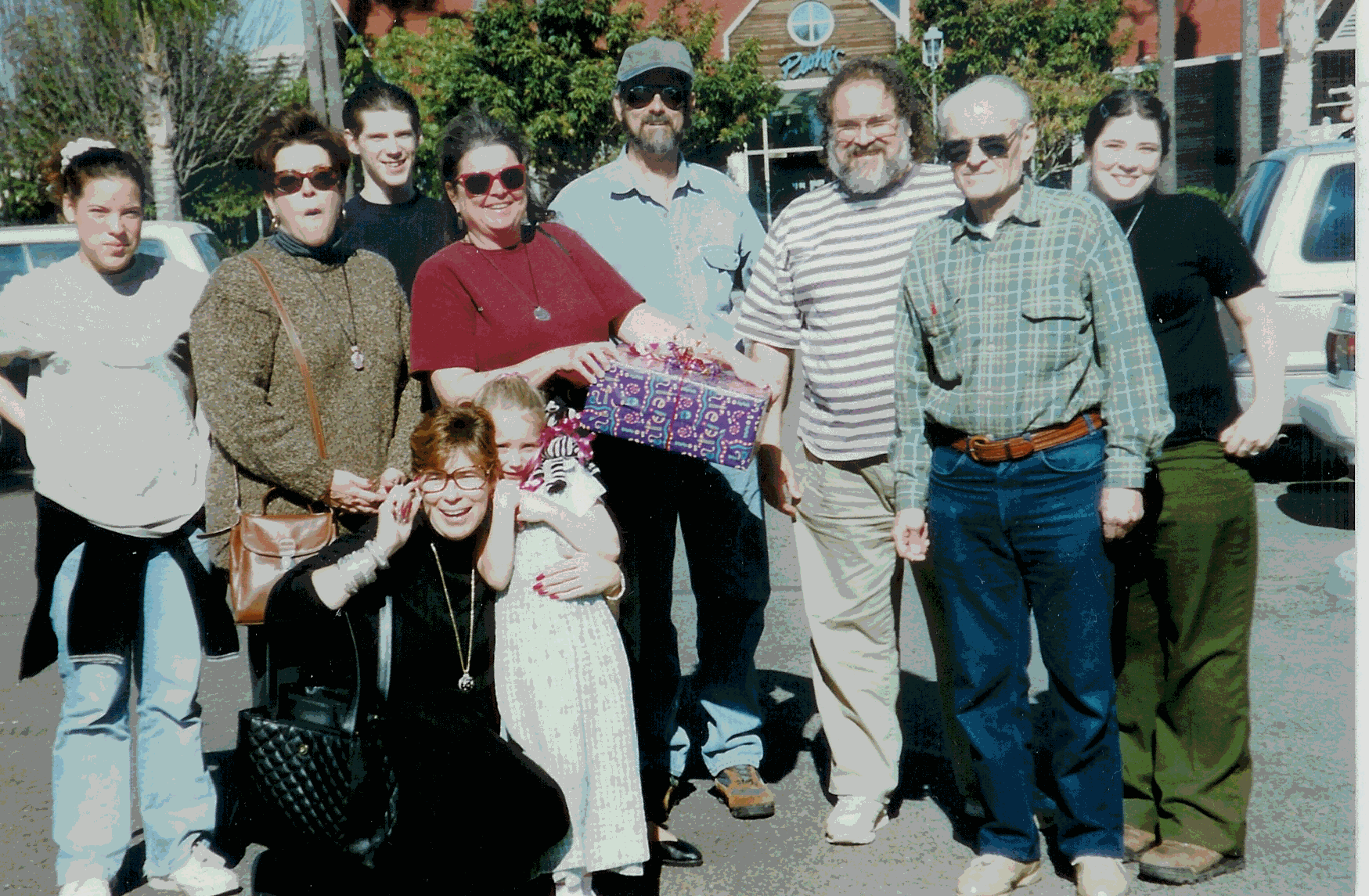
Kirsten Katy Mike Cathy Gerry Dan Leigh GloriaTerry Zarli
This was when Dan arranged a tour of the S.S. Constellation
My mother had not been well for several years. She needed around the clock care, which Glenn was able to arrange for her. Six months after Tom died, she fell and broke a hip. There was not much alternative to a hip replacement, but she never recovered from the surgery, passing away October 1st, 1981. Her services were quite different than Tomís. She had expressed her wishes to Rae. She wanted the simplest casket available; a pine box would have been fine. We just had a small gathering of family and friends in her garden. She rests next to my father, in the little cemetery on the hill. Not long ago our dear Glenn joined them. Barbara and I, and some other family members, want that spot to be our final resting place, somewhere in the distant future.
Our 50th anniversary, with Photo of our wedding in the background. Gee, we havenít aged a day!
I wonít go into too much detail on the building of our new house. It is a long, sad story! Unlike some people, we had not spent years planning our dream house. We had hoped to buy a house already built, but that didnít happen. We had one of our new neighbors design a house for us. We told him more or less what we wanted, with emphasis on keeping it small. At some point we decided on three bedrooms rather that two. The designer claimed to be able to build us a house that was nearly all solar heated, and that would stay cool in the summer. The man was a scam artist. I canít believe how gullible I was. I think you will agree that this was totally out of character for me!We did have good sub-contractors, and they built us a good, solid house. Never mind that the money we spent on solar was wasted, and the house could just as well have been on one level. I take the blame for much of this, because I should have known better.At the time we decided to move to Mariposa, the market for homes was rather dismal. Interest rates were sky high, which puts a real damper on home buying. We decided to list the Los Amigos house, even though our new house was barely underway. We listed with a lady across the street from us, because she was so gung-ho about the neighborhood. She held an open house, and came up with a potential buyer, contingent on the sale of their house in Thousand oaks. We negotiated an acceptable deal, only on the condition that our house remain on the market until they could close the deal. That condition worried the buyers and the broker, naturally. The broker and her boss were so confidant that the whole deal would come together that the brokerage went ahead and bought the our house, so that the buyer would not get away. One reason that we were able to sell it so quickly was that we didnít need the money to start on our new house. We got a 20% down payment and carried the balance at 10% interest, for ten years, with a balloon payment at that time. In the end, all the parts of the puzzle fell into place, and we had 30 days to get out of the house.
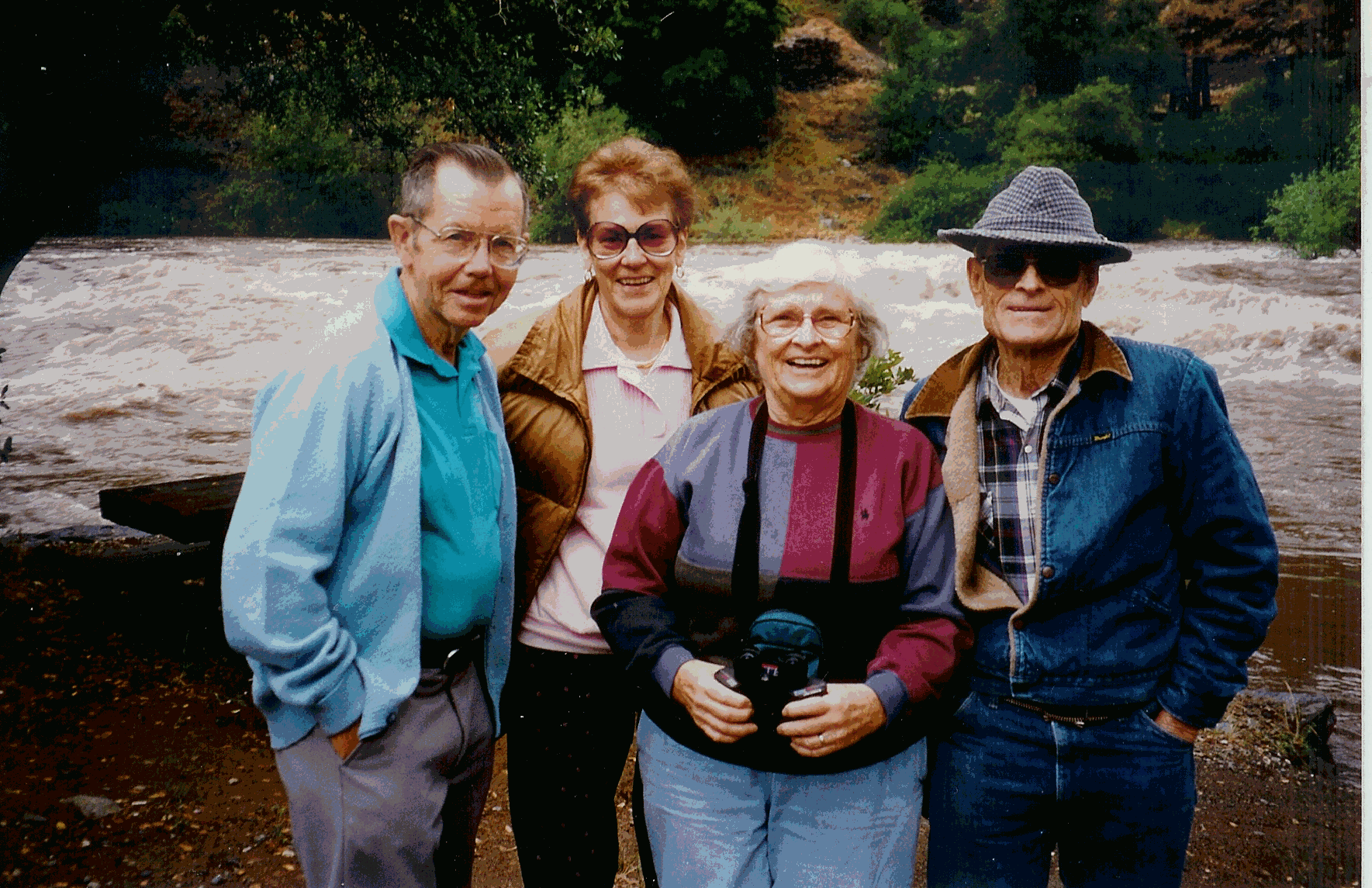
Frank Barbara Rae Leigh Merced river on a rampage
Fortunately, we had sort of anticipated this. We had the builder do the garage first, so that we would have a place to store things. Also we had a parking pad next to the garage, and water, electricity, and telephone were in. All summer we made trips back and forth, sometimes with the motor home, sometimes with the pickup and a little cargo trailer that I had built. We brought all the outside stuff, such as tools, power tools, welder, welding table, workbenches, barbeque, and patio furniture. In the motor home, we brought lots of household things. On the next to last trip Barb drove the pickup, and I drove the motor home. We left the pickup, and on the last trip, she brought the car. We got a mover to bring all the furniture, and appliances, and anything else that was left. Our final move was on September 20th, 1981.We spent the next five months in the motor home, while the house was being finished. I ran a long telephone cord from the shop, so we were pretty complete. I set up the washer outside the garage, so we could wash clothes, but we had to take them to town to get them dry. We also had to unhook everything to take the motor home to town for propane, about every three weeks. We had over forty inches of rain that winter, and it seemed like as time went on the motor home got smaller and smaller. I think it was on March 1st that we got final inspection on the house, and were able to start moving our things up from the shop. The first thing Barb discovered when she started to open boxes was that we had been invaded by scorpions. She started opening boxes outside, and carefully removing every item, to avoid taking too many scorpions in the house. Soon enough, scorpions stung us both. The pain was intense, but to our surprise, within a few minutes it was completely gone. "Our" scorpions are very small, being only about an inch in length. For the first few years we had lots of them in the house, but as time goes by there are less and less. We have learned to respect, but not fear them.
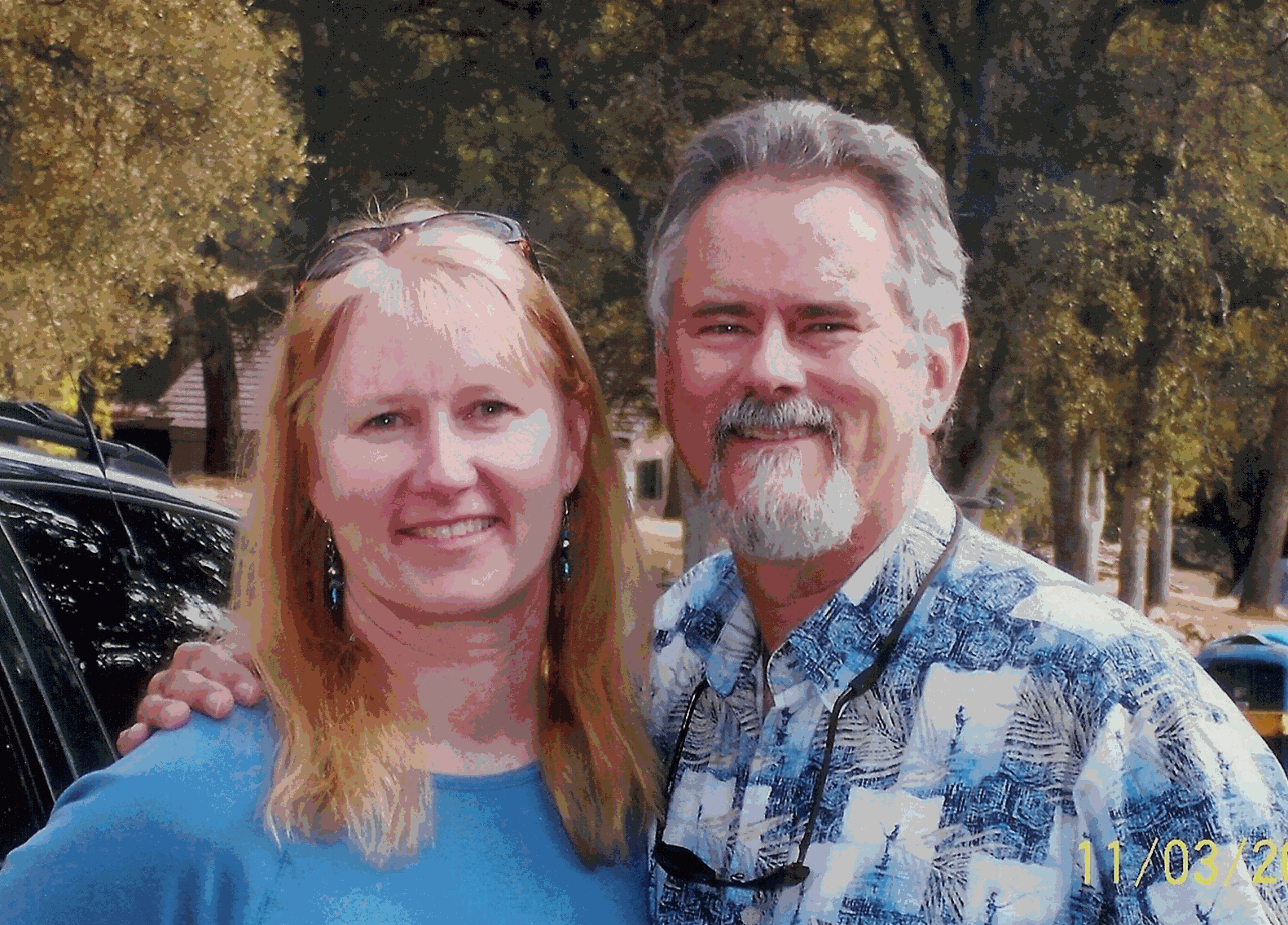
Colleen and Gerry
The genius that designed the house had not seen fit to provide any way to keep the morning sun off the east facing glass sliders. We put up a bamboo shade, but that was not very effective. So, my first major project was to build a roof over the deck on that wall. As I recall, several family members helped out at various stages of construction.One of the first things I bought after moving to Mariposa was a chain saw. P.G.&E. had trimmed some oak trees in order to bring power to the house. They left the wood cut into four-foot lengths. I cut all that into 16-inch lengths to burn in the heating stove. We had also removed a very large oak in order to build the house, which I cut up for firewood. During this time I realized that although I had sold many new saws, and instructed the buyers on how to keep the chain sharp, I really didnít have a clue! An old-time friend from Simi, John Cushman, visited for a few days, and gave me some good instructions. Since then I have always had a sharp chain! Various of my neighbors have brought their power splitters to help me do that chore. Very early on we bought one cord of wood, and all the rest has come from fallen trees or limbs, pruning, or from some of the neighbors that donít burn wood at all, or donít burn any pine. Another thing we bought was a small weed eater. What a miserable little devise that was. For starters, we did not understand that the weeds need to be dry and crisp to cut well, otherwise they wind themselves around the cutter, choking it down. My health was poor, so Barbara insisted on operating this contraption part of the time. I think we got rid of it after the first year.
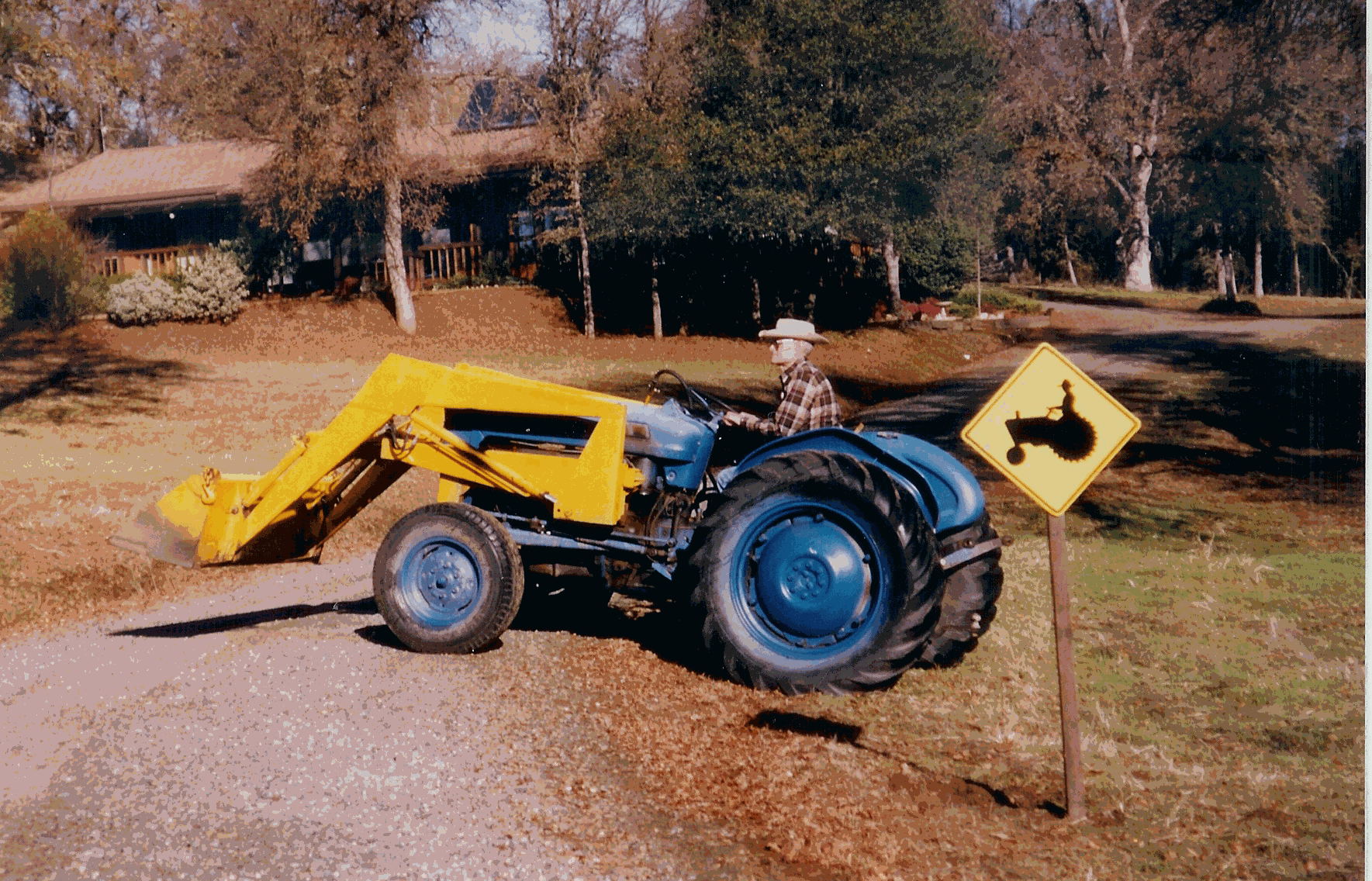
Back in the Saddle!This tractor was 40 years old when I bought it.
As a friend of mine used to say, "she donít look like much, but sheís got
a heart of gold!"
I decided I needed a tractor and mower to keep the weeds down on our eight acres. In Oxnard I found a used Ford Tractor that was just what I needed. It happened to have a loader on it, which turned out to be a lucky break for me. The mower I bought is indispensable, but I actually use the loader more than the mower. To round out the package I bought a box-scraper. Later, I bought a 30-gallon weed sprayer to mount on the tractor, and fabricated a boom with four spray nozzles, so that I can spray small areas by a hose and wand, or wide areas with the boom. Now my practice is to use the sprayer to keep clean the mandatory thirty feet around the building, for fire protection. Then, when the grass is thoroughly dry, I mow the entire lot with the tractor, then trim up around the trees by means of High School Boy, or with my newer weed whacker. A great benefit of letting everything go through its life cycle is that we have magnificent wild flower displays every year. As I write this, in mid-May, the mower is mounted on the tractor, the grass is dry enough to mow, but Iím waiting for the last wild-flowers to go to seed. After the second winter, we decided to have a furnace and air conditioner installed. The heating stove had required nearly constant attention in the winter, and the swamp cooler was totally inadequate. Life has been much better since then! I also installed a large wholeĖhouse fan, to bring in the cool night air.After a few years, I hired Mike Montoya to put in a retaining wall and pad for the motor home alongside the carport. That made it easy to load and unload for trips. When we stopped using it for travel, it became a spare bedroom, and a sort of transitional storage space for things we were not using, but not yet ready to throw away.In 1992 I built a 6X16 foot addition to the back of the house that became Barbaraís closet. This also meant that I had a closet to myself. We had found that we needed two sets of clothes, one for summer and one for winter. This meant that we needed much more closet space.Little by little, we learned what we could grow in the garden, and what the deer would demolish. The yard that has evolved is pretty well deer proof, but from time to time they fool you. They wonít touch Daffodils, or Iris, but they love Tulips and Roses. I planted some sort of fir shrubs next the shop, and for fifteen years the deer ignored them. About three years ago, while we were away, they ate everything down to bare branches, even breaking some of the branches. Go figure!
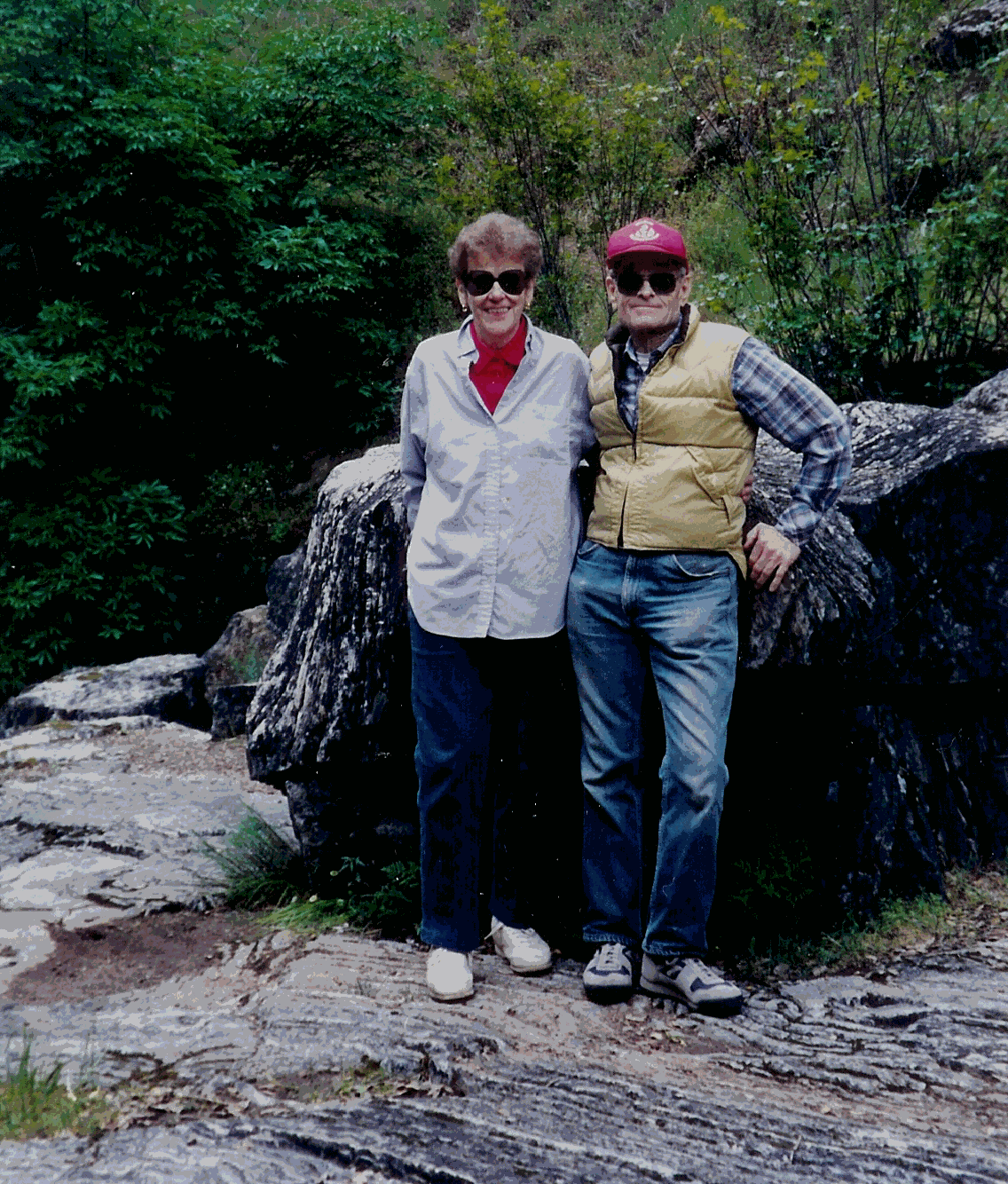
Leigh and Barbara, hiking in Yosemite
Ourís was the third house to be built in a thirty-five lot sub-division. As new people moved in, we made many good friendships. In the beginning they were mostly near our age, mostly retired, mostly without children living at home, mostly delighted to be living here, mostly friendly and mostly respected the privacy of everyone else. So, there was a large group of people of the same mind. The world does not stand still. Today there are only four vacant lots. Some of the old timers have left. The new people moving in are younger, some have young children, and some are still working. All of that is fine. The only problem is that some of them seem to want to bring big city ways to our quiet little neighborhood. Iím not complaining. For now, there is no place we would rather be.A tremendous, and unexpected, bonus for us is having Yosemite National Park almost outside our back door. The only time either of us had been to Yosemite was a couple of years before we moved up here. We spent a few days at Lake Tahoe, then came down through the gold country on Highway 49. We turned east on Highway 120, intending to spend the night in Yosemite. This was in the fall, so the waterfalls were mostly dry, the valley full of smoke from controlled burning, and it seemed rather crowded. We were not impressed! I found a phone, and called Montoyaís to arrange to stay with them. We stopped for dinner at a little restaurant in El Portal that was washed away in the Great Flood of 1997.Soon after we made our move to Mariposa we took a drive into the park. We went through Oakhurst, then out to Glacier point. The little snack shack was closed for the season, so we drove to the Valley for a late lunch. This little excursion changed our opinion of the Park. Since then we have visited there many times every year. We are able to see it in all seasons. Even in the most crowded time of year, we can escape the crush of people in the Valley by going to Washburn Point-Glacier Point, or Tenaya Lake-Tuolumne Meadows. Even the Valley is possible in the summer. Many times we decide at breakfast time to make a run to the Park. We can go to the viewpoint near the tunnel, stop to admire each of the waterfalls, find a spot to eat our lunch with our toes almost in the Merced River, and be headed home before most people get there.Best of all, the Park was an added incentive for our children to come and visit!
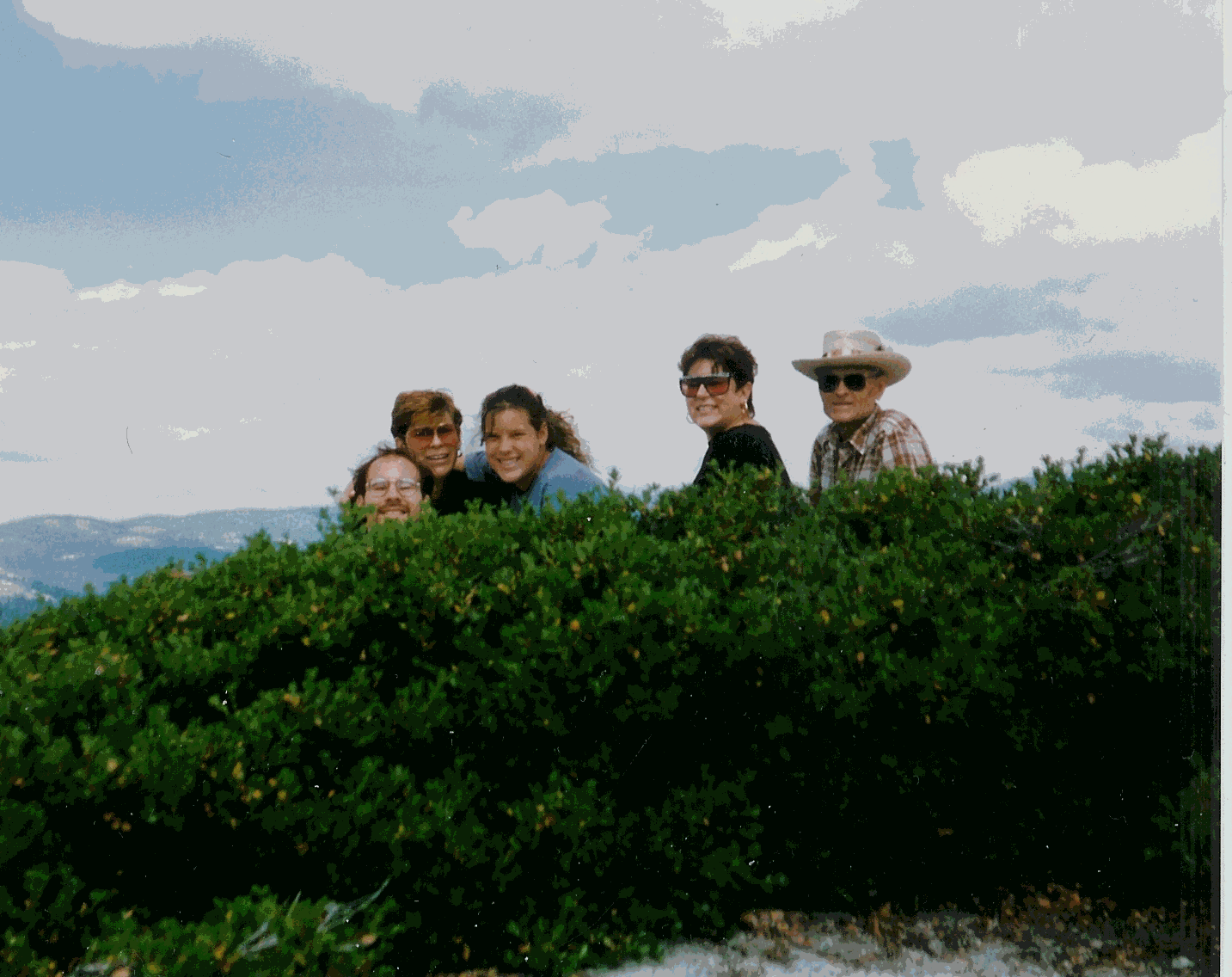
Sean, Terry ,Kristen, Katy, Leigh at Taft Point, about 2500 feet above
Yosemite Valley Floor
In the early years here in Mariposa we only observed the Park from near the road, as I was not able to do any hiking. After my second heart surgery, in May of 1991, I found that I was able to do more and more hiking. There have been many hikes, sometimes just Barbara and me, sometimes with our neighbors, Bob and Muriel Larson, but mostly with various family members; my sisters, our children and grandchildren. At Easter time we hiked up the South fork of the Merced River to see the vast array of wildflowers. In the summer we hiked from the Glacier Point road out to Centinal Dome and Taft point, both overlooking the Valley from the South.Over the years we hiked to some waterfalls in Hetch Hetchy, in the north-west corner of the park, to another in Wawona, in the south west corner, to all the major falls in Yosemite Valley, and to two lakes in the high country. There were also hikes to Merced Grove of Giant Sequoias, and Nelder Grove outside the park.Some of these hikes, the most difficult, were one-timers. Others were sort of traditional, repeated year after year. The South Fork Trail to Hites Cove, and the Mist Trail to the top of Nevada Falls fell into this category. I canít count how many times we hiked those trails. One of the most difficult and tiring was a hike I took with Gerry, to the top of Yosemite Falls. It took us a full eight hours. Of course that includes a good deal of time just marveling at the view. The other tough one was with Terry and Sean. Barbara dropped us at Glacier Point. From there we started downhill to Illiluette Falls, then a climb back up before dropping again to Nevada Falls and then to Vernal Falls, and finally the Valley Floor. At Happy Isles we got on a shuttle bus to get to the Ahwahnee Hotel, where Barb awaited us. Another tradition was to have a huge Tamale Pie waiting for us at home, ready to be heated.
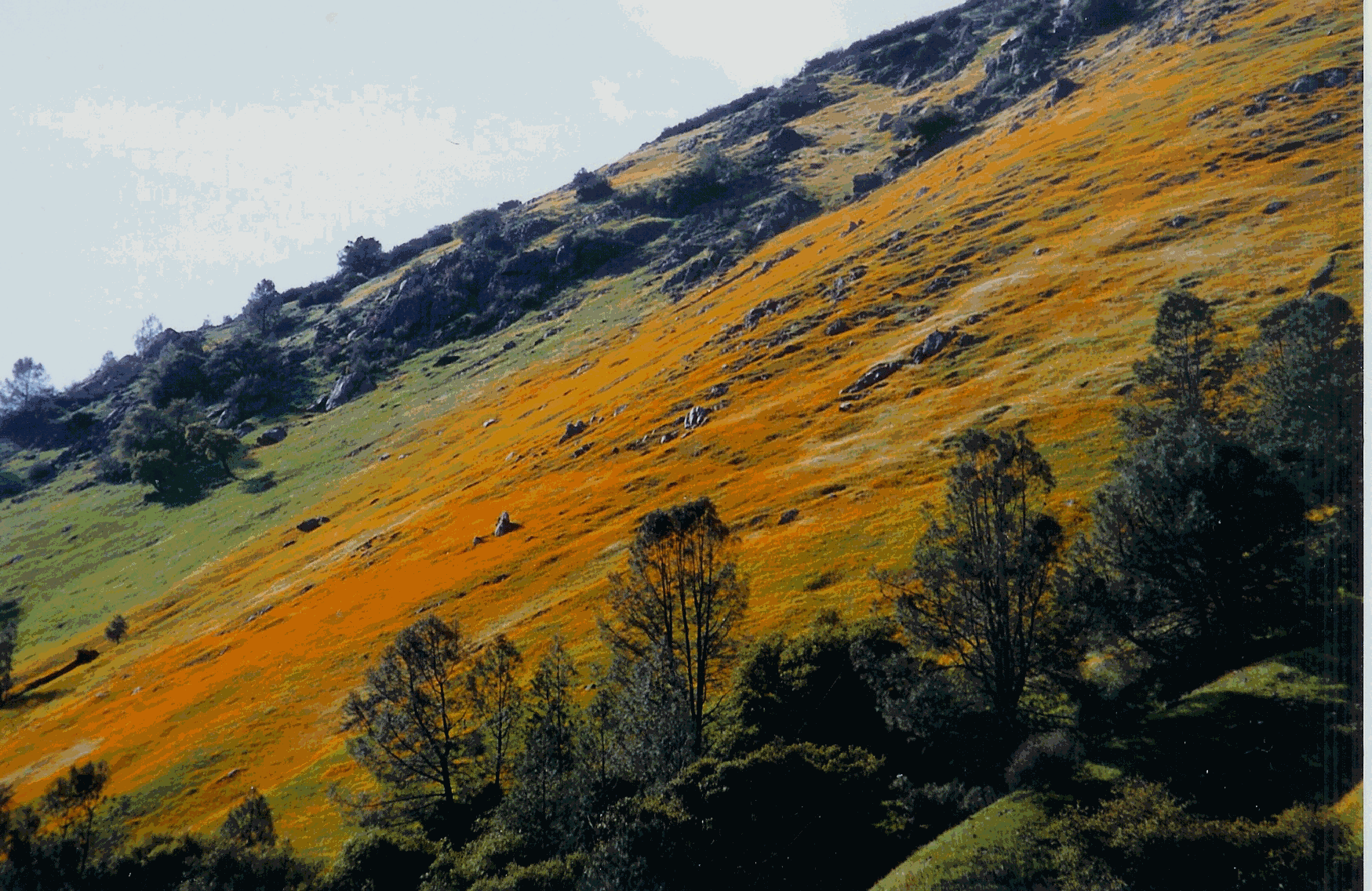
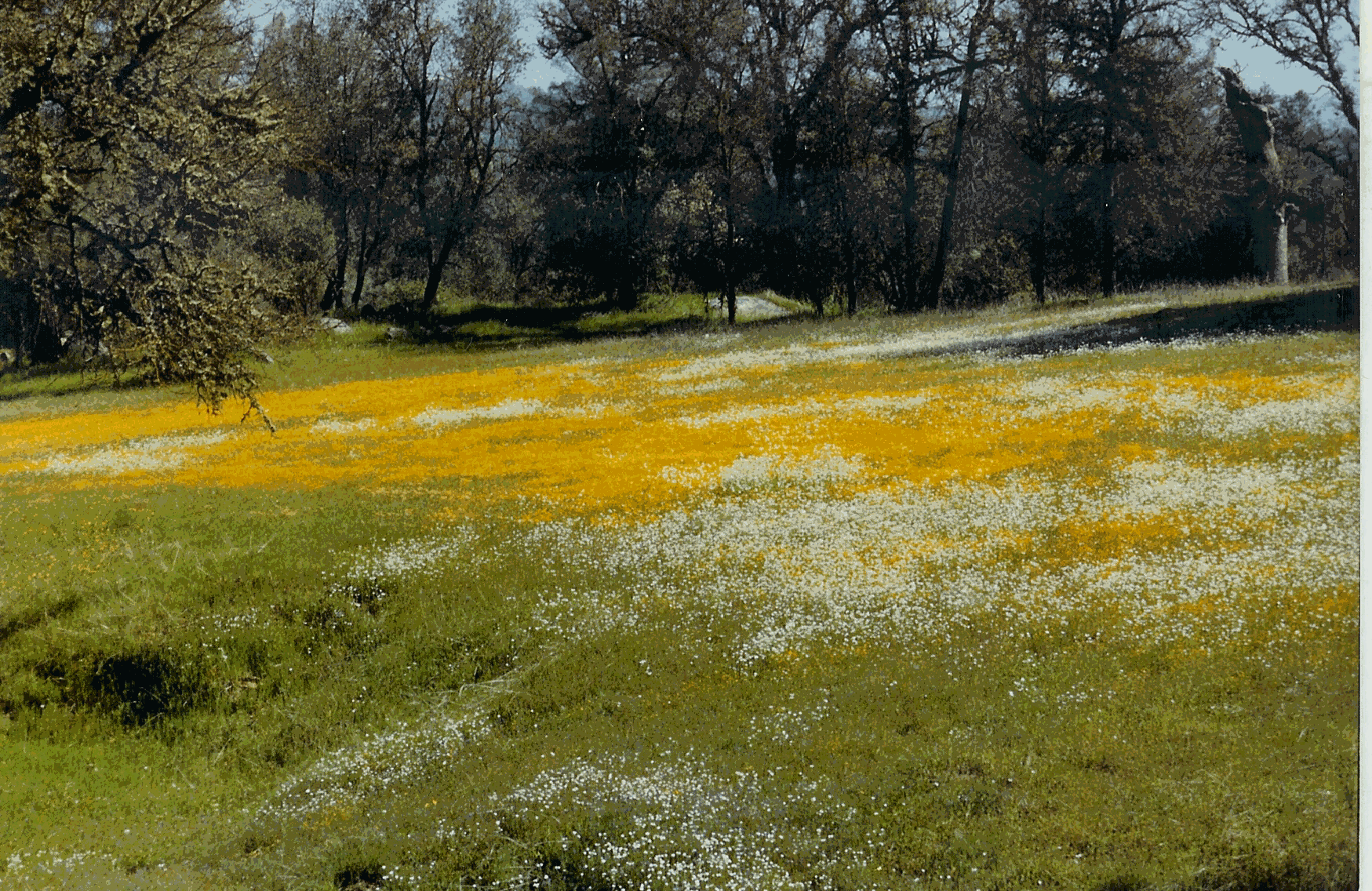
Poppies in the spring, Merced River Wildflowers on our lot
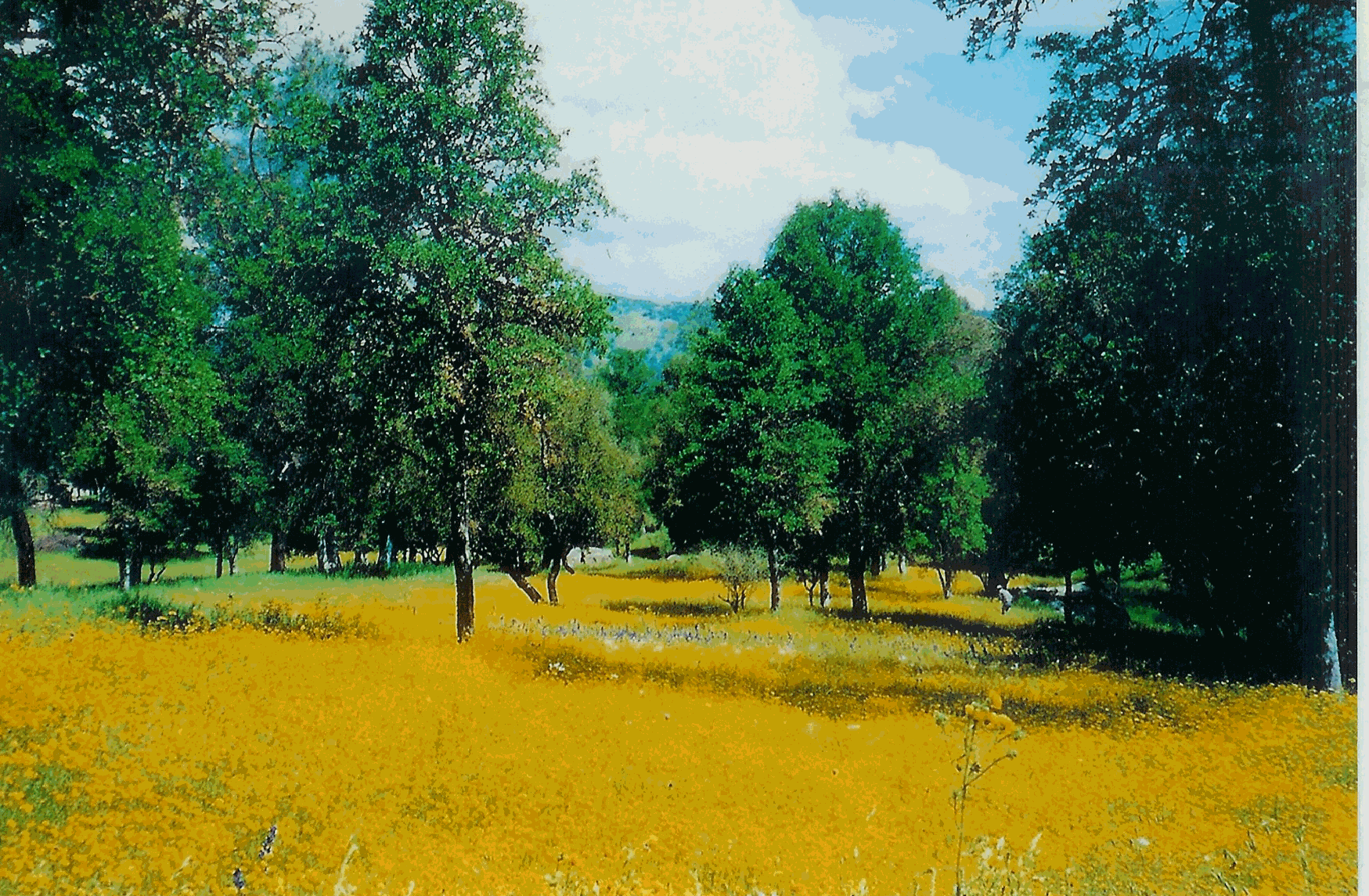
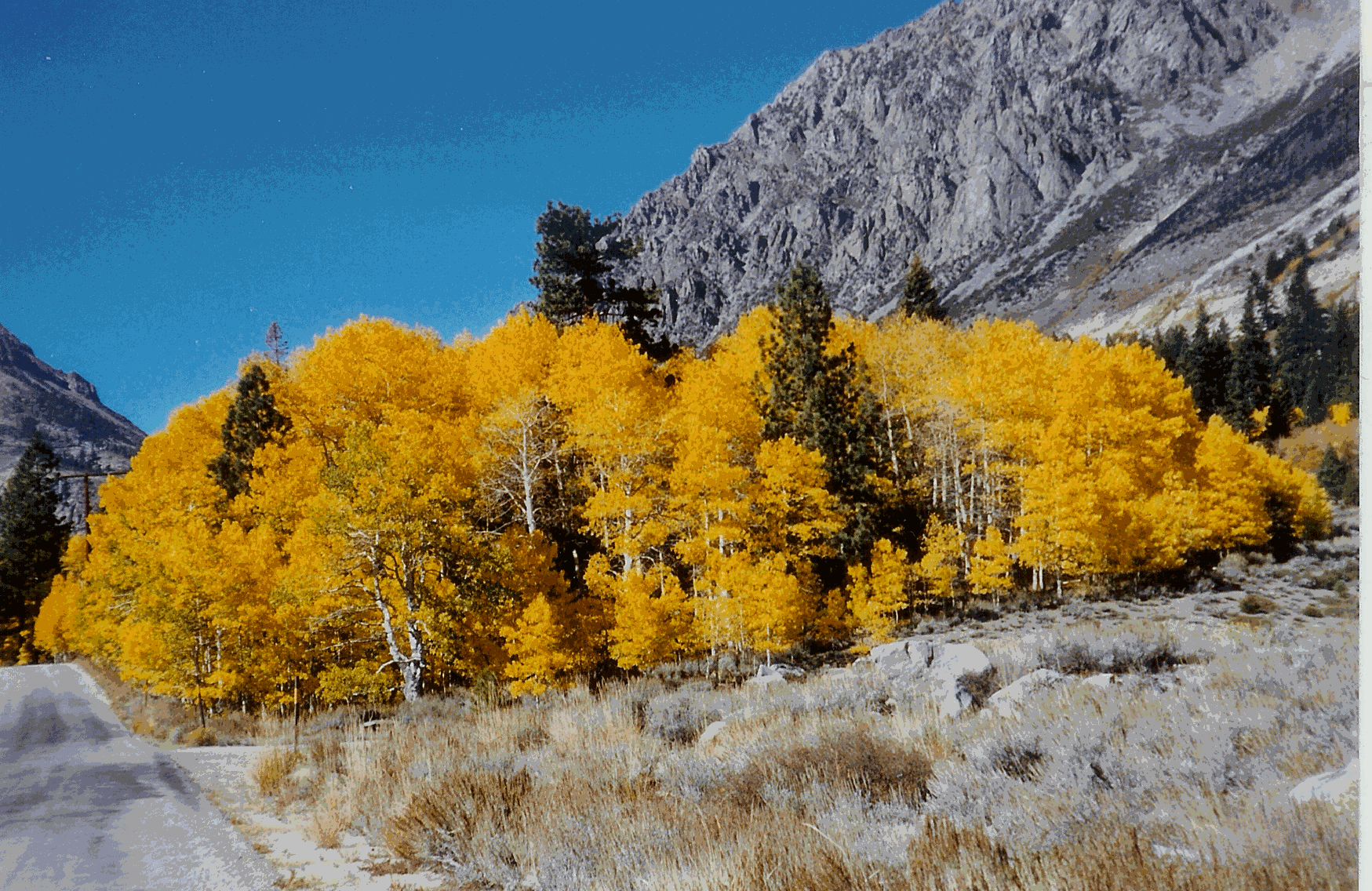
Spring Flowers, our lot Autumn colors, Lee Vining Canyon
One spring Terry, Sean, and I rafted the Merced River. We happened to go on the first day the river was opened for rafting, after being closed because of high water. It was a memorable ride, but not one I need to repeat! We chose to go in an "oar" boat, rather than a "paddle" boat. For one thing, I didnít want to spend the trip paddling, and I also knew that an experienced boatman with oars would control the raft much better than a bunch of paddlers. Toward the end of the ride we went through two Class 4 rapids. Iíll have to say that it was frightening to me. All of my boating experience was in the ocean, or lakes, where we always had control of the boat, and even ending up in the water was not a serious matter. A raging river is a different proposition! Ending up in very swift water that is only a few degrees above freezing is not a good option! I just felt like this was a situation where I did not control my fate, and it bothered me.Terry and Sean had planned a hike to Vernal and Nevada Falls the next day. At bed-time I announced that I was too tired to go with them. In the morning, after a good sleep, I decided that I was up for it, so off we went. The high water made for great displays by all the falls. That evening, after consuming large portions of tamale pie, I asked the others a question. "If you had only one day in your life for an adventure, would you raft the Merced River, or hike to the top of Nevada Falls?" We were unanimous in choosing the hike!I should mention that our grandson, Sean, was the instigator and motivator for many of those hikes. He loved the mountains and he loved to hike, so there was never any question about it, if Sean was here, we were going to hike somewhere. We lost our Seanie in year 2004. Without his motivation, itís easy to find reasons to put off the hikes. We miss you, Sean!
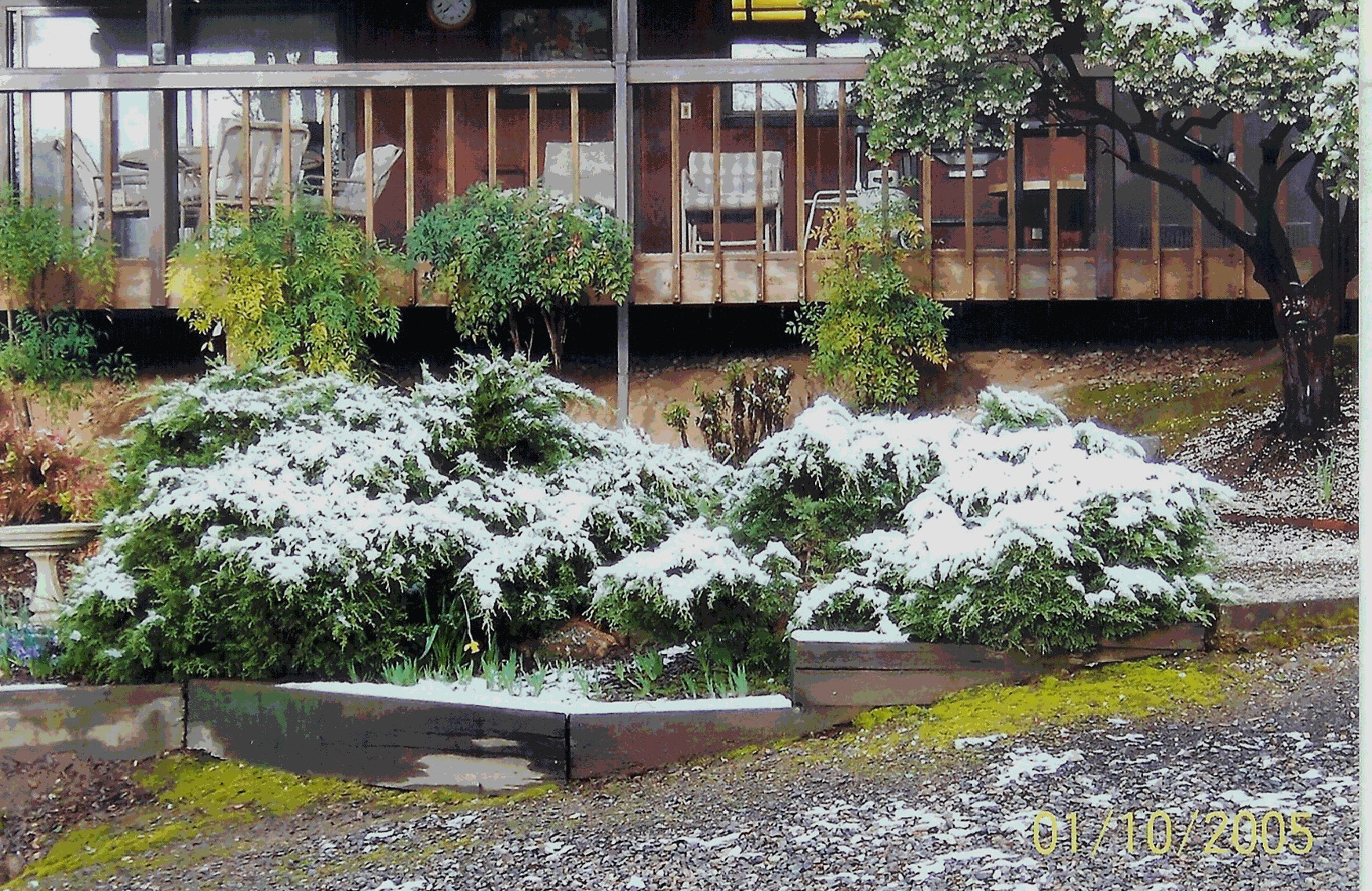
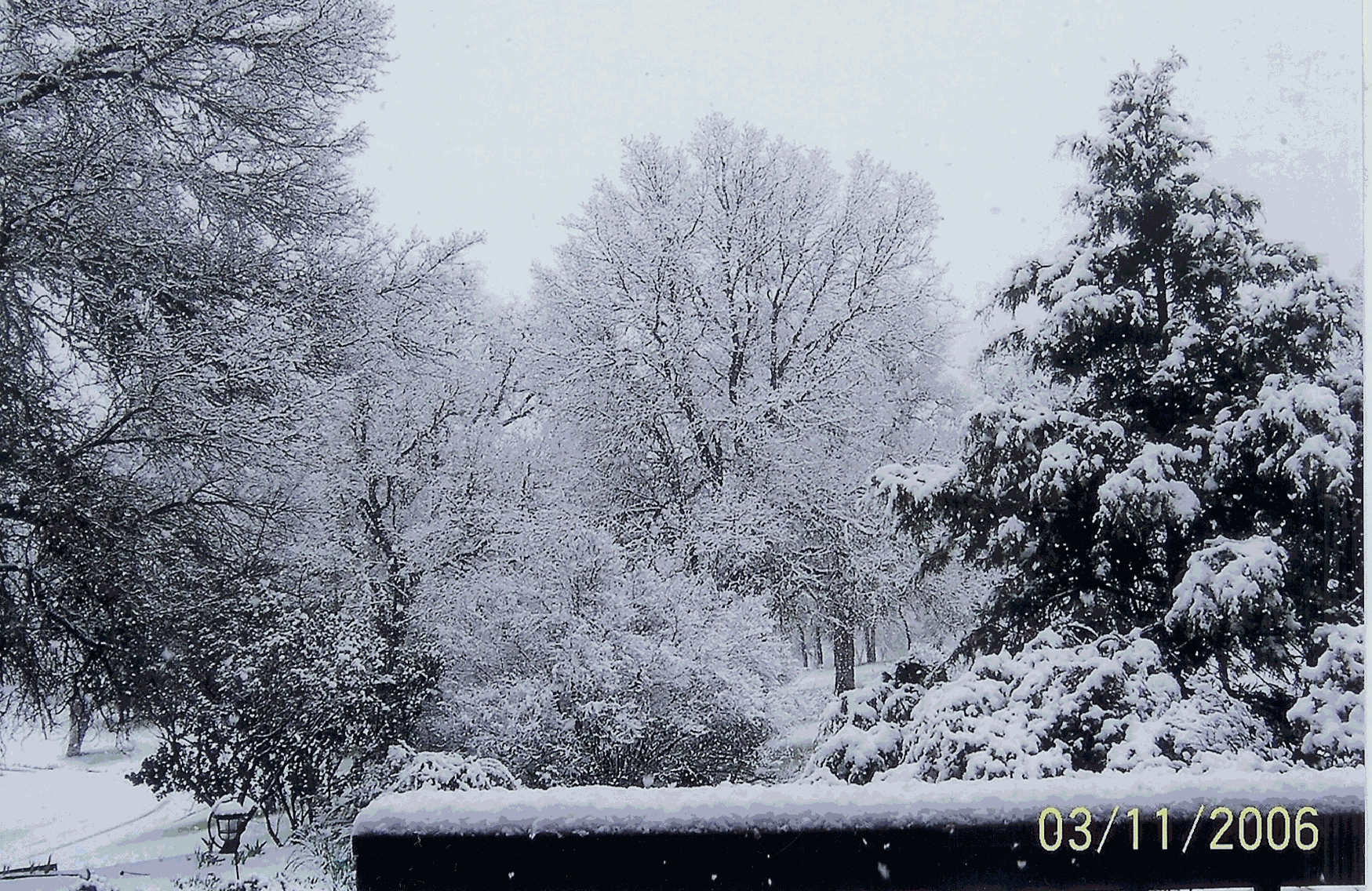
Perfect Snow!Beautiful to look at, but not enough to have to shovel!
Going back a bit, in early 1985 we got the idea of building a small house on the lot that my father had given us many years earlier at San Miguel. Due to the movement of Magic Mountain, our original lot seemed in danger of falling into the sea, so we were given a different lot, which is the present location, directly across the Toll Road from San Miguel Village. After much delay, we had our plans approved and permits in hand. We contracted with Ramon Carranza to furnish the labor, and we furnished the materials. I did all the plumbing, electrical and cabinet work.
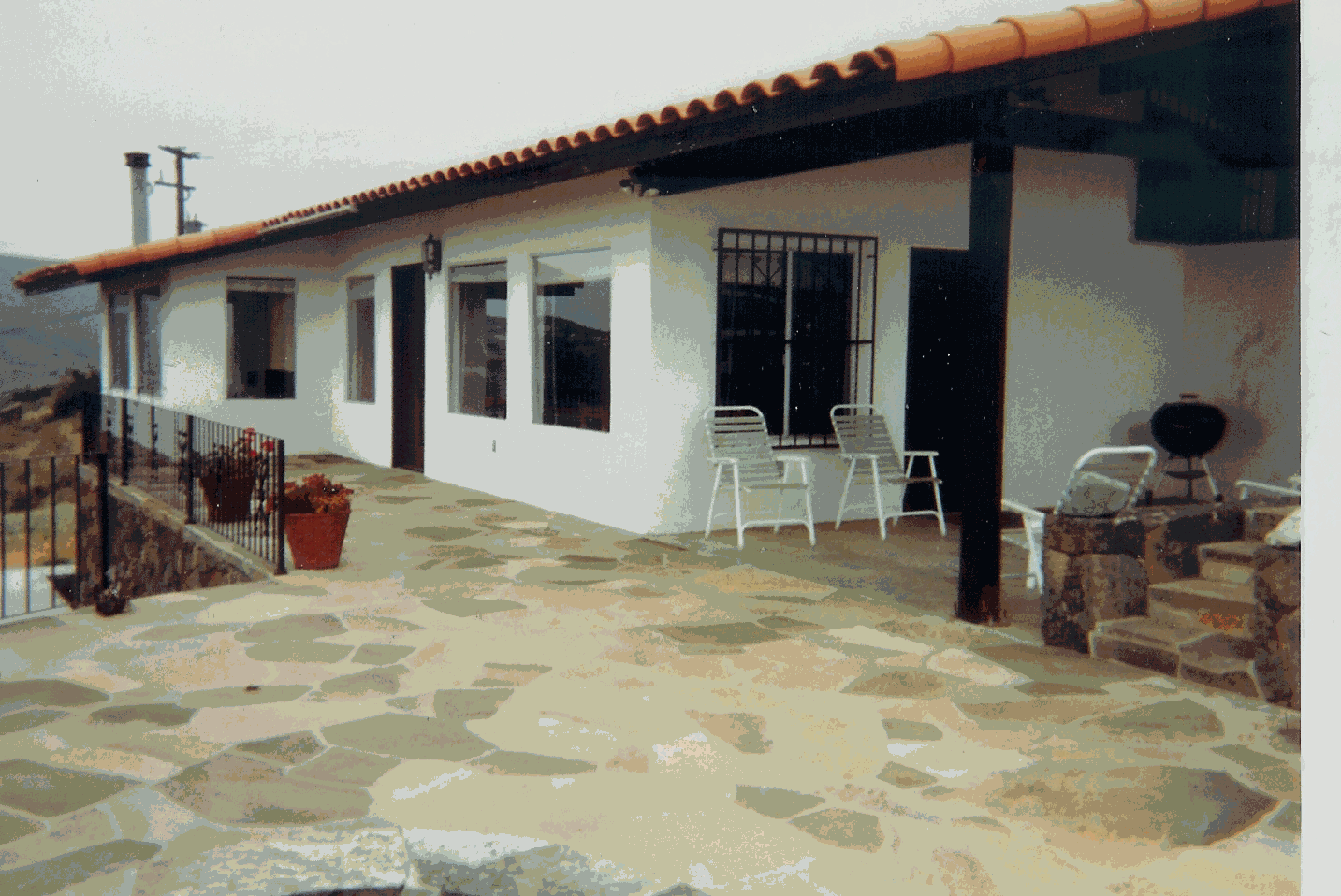
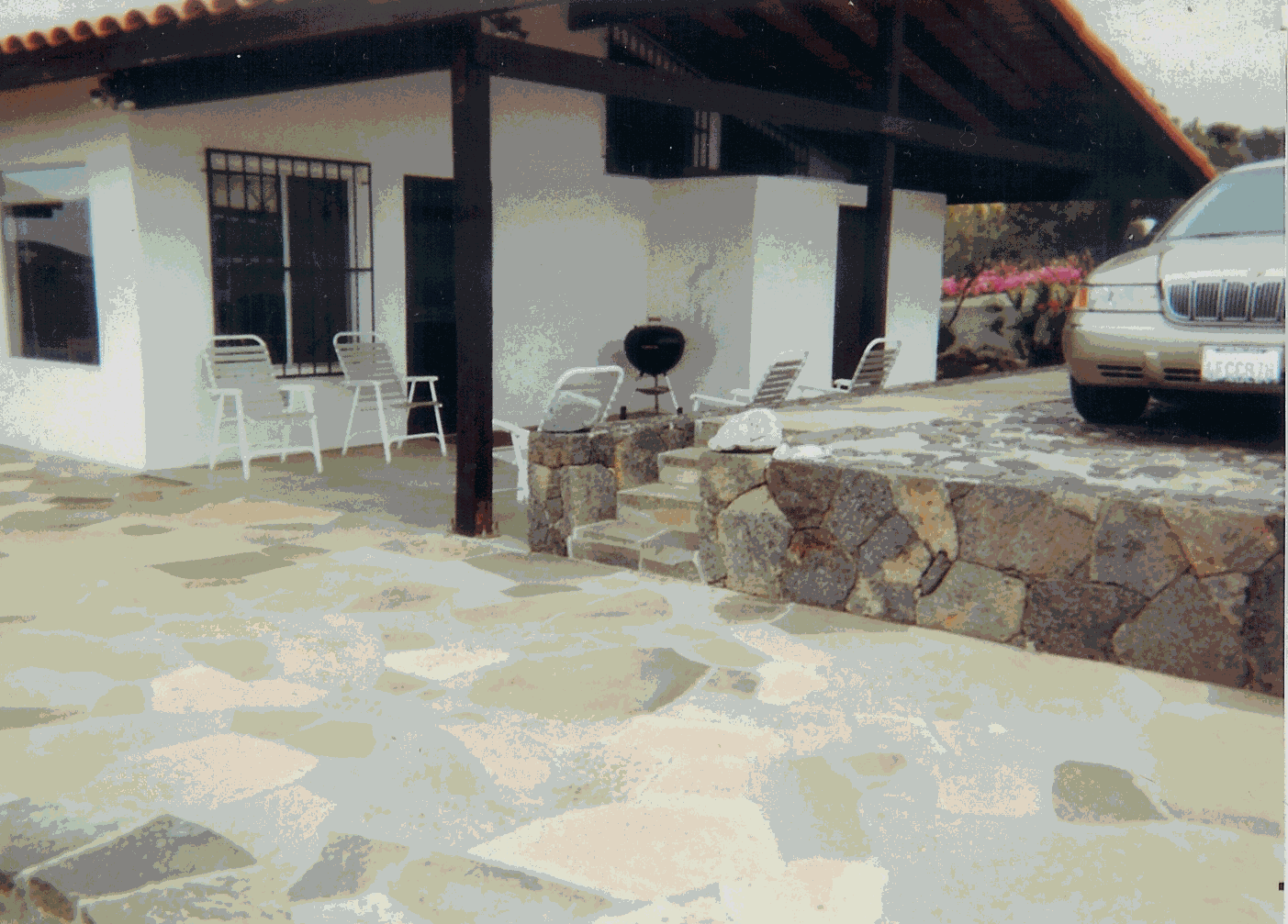
South Side East End
While the house was under construction we spent about half the time in our Motor Home, in Glennís yard. The rest of the time we were in Mariposa. We went to all the yard sales, to shop for things to furnish the house.
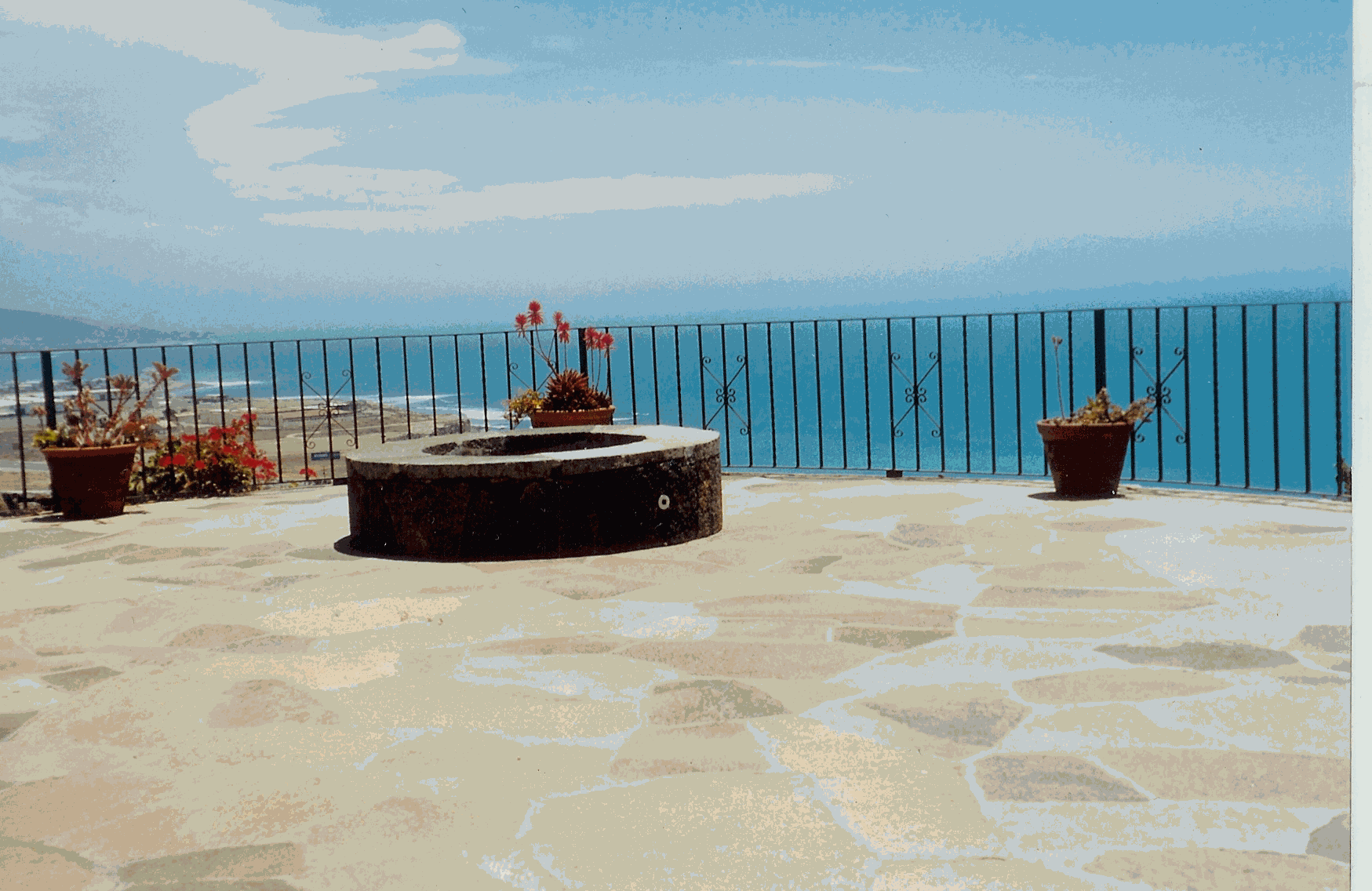
Front Deck, overlooking the ocean.
By Christmas the house was near enough to completion that we were able to give each of our children a key, and ownership. We had the first family gathering in June of 1986, but it took another year after that to get the niceties, such as water, electricity, and a decent road.
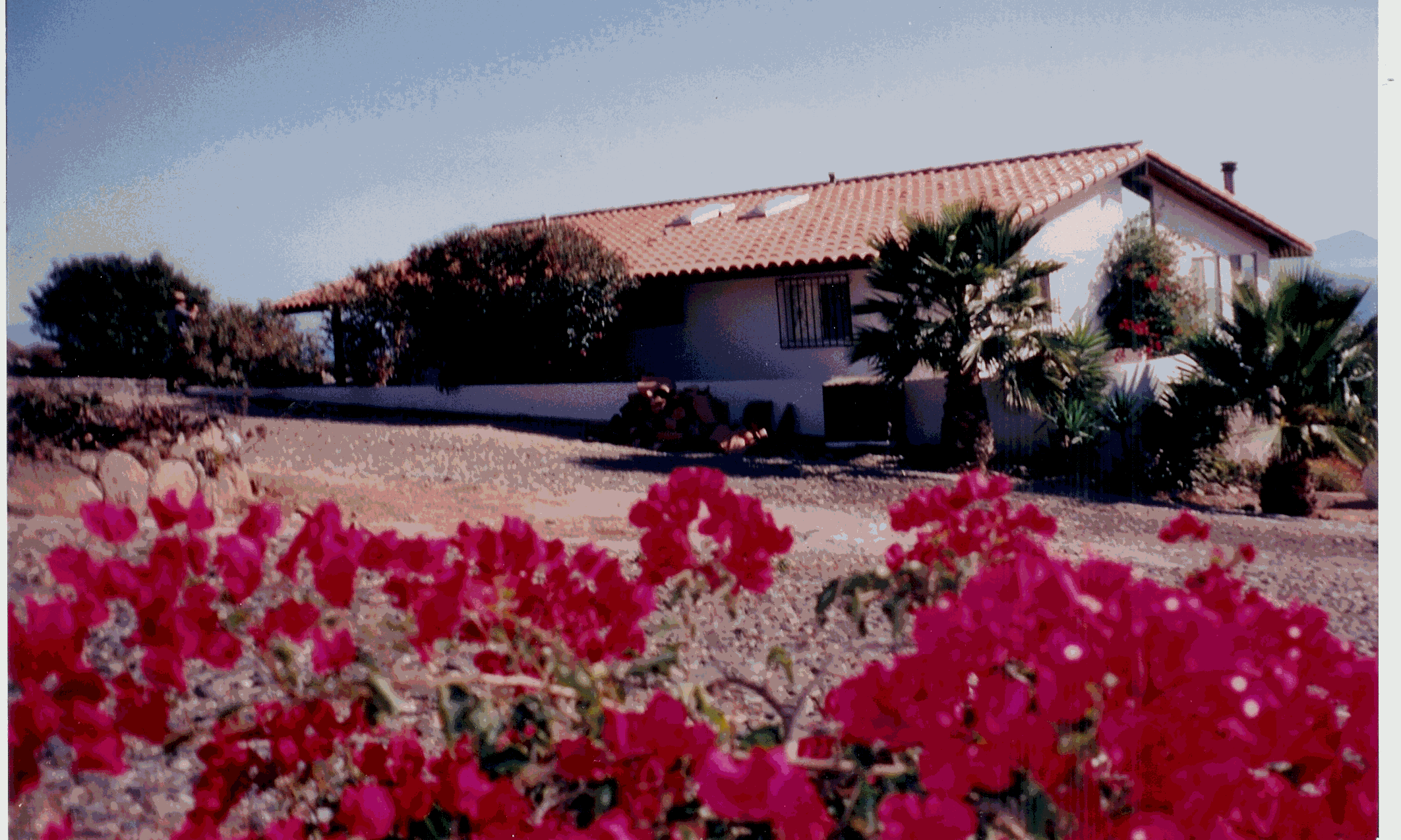
Back yard, from across the street
From start to finish, it was truly a labor of love. Since the house was literally for everyone, it seemed proper to call it Su Casa. Su Casa has served a wonderful purpose, that being to bring all the families closer together. We have all gathered there many times, and we have all been able to spend more time with Glenn and his family. My only regret today is that all of our lives have become so complicated that we cannot make proper use of the house.
Much to my delight, for the last two years the Casa has been renovated, and is being well used by our family. In fact, others are taking advantage of the view, the comfort and the isolation of Su Casa by renting it. LR
Of course losing Glenn in 2000 makes it emotionally difficult also. For my part, I feel his absence more when we are in San Miguel. The twenty-five years spent in Mariposa were wonderful, happy years. They were also years of hard work. We made several improvements to the house, only one of which we contracted out. I spent many hours every year weed spraying, weed whacking, and mowing. I must have cut thirty or more cords of firewood. I helped maintain Bridgeport Dr, as it is a private road. I cleaned the rain gutters at least three times each fall. I swept the chimney to remove creosote. Up until a few years ago, Barbara did much of the gardening, and most of the cooking and cleaning, as well as doing some sewing.I actually enjoyed all the work, if for no other reason than to prove to myself that I could still do it!There were also difficult times. I made several trips to St. Agnes Hospital in Fresno because of heart problems. On the last of these, I virtually died on the table during a angioplasty procedure. I think it took an hour to get my heart back to some kind of normal rhythm. At least so I am told. I was unconscious for most of two days!In 1991 I got into trouble again while on a trip south. More heart surgery. This time I got four or five Arterial grafts. That surgery worked fine. It was after that that I began to be able to hike in the mountains. To paraphrase Will Rogers (I never met a man I didnít like), I never met a waterfall I didnít like! The following pictures are just a small sample of the glorious hikes we have taken in and near Yosemite.
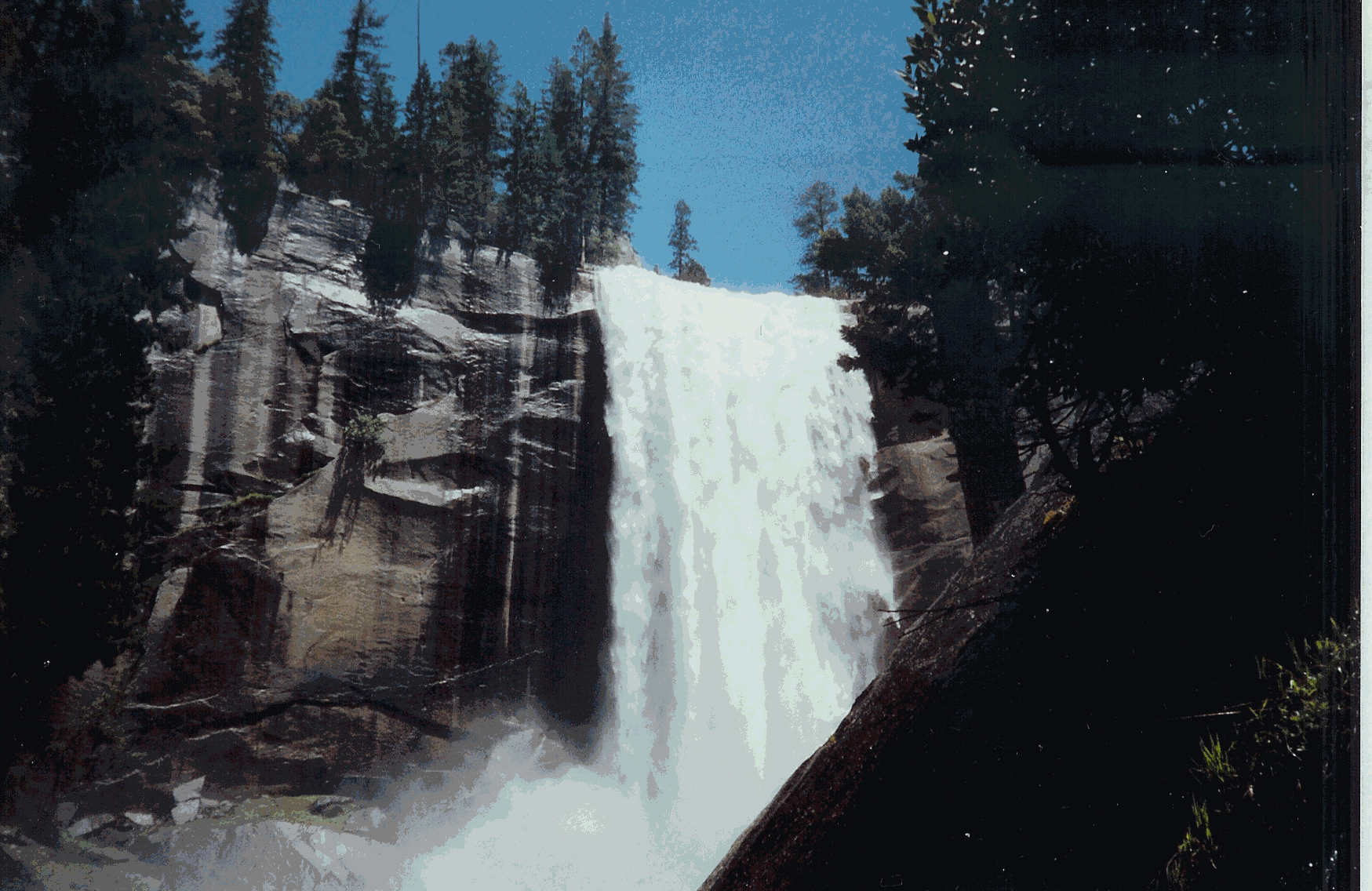
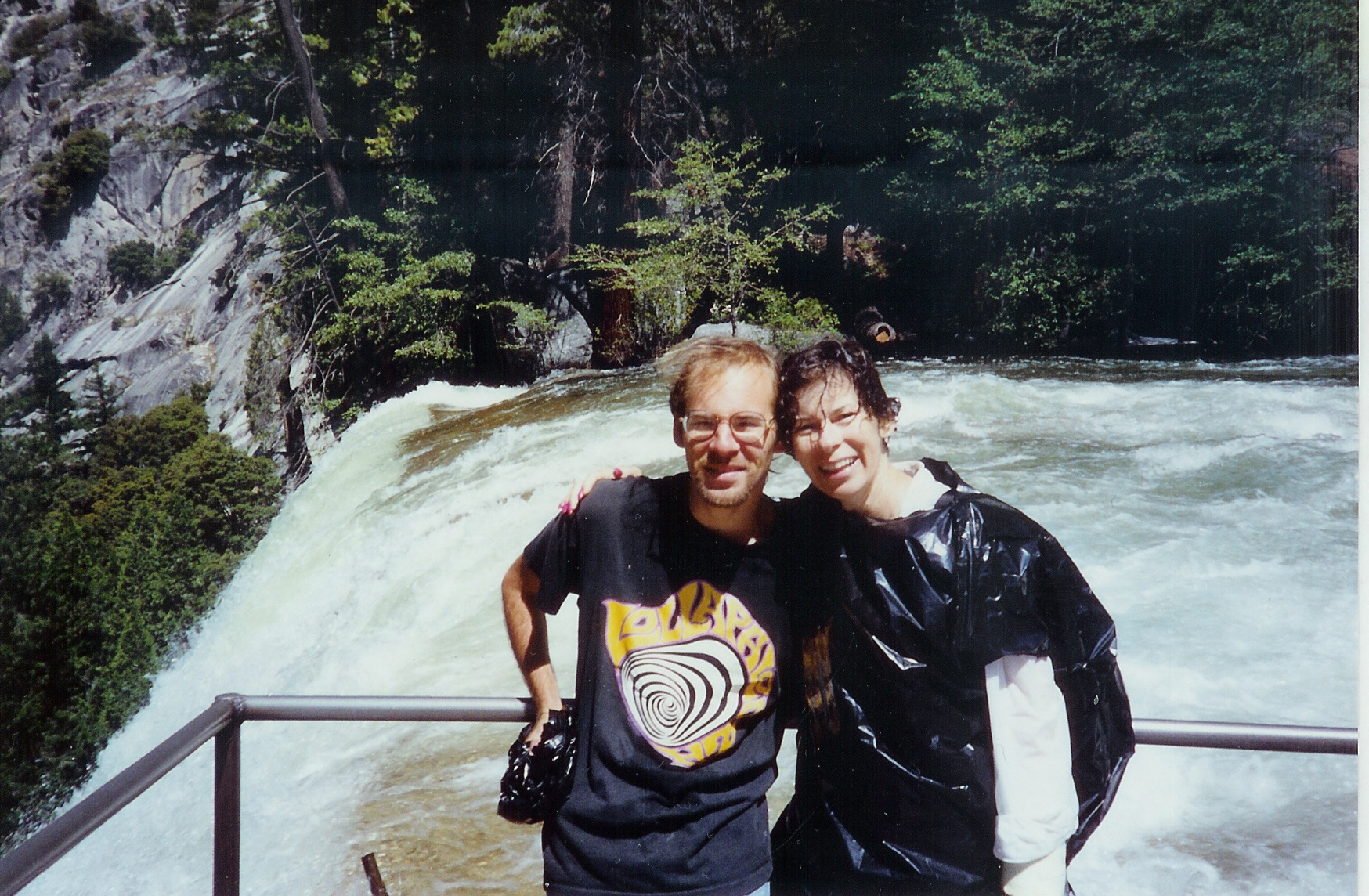
Vernal Falls, from below
Sean and Terry, at the top of Vernal
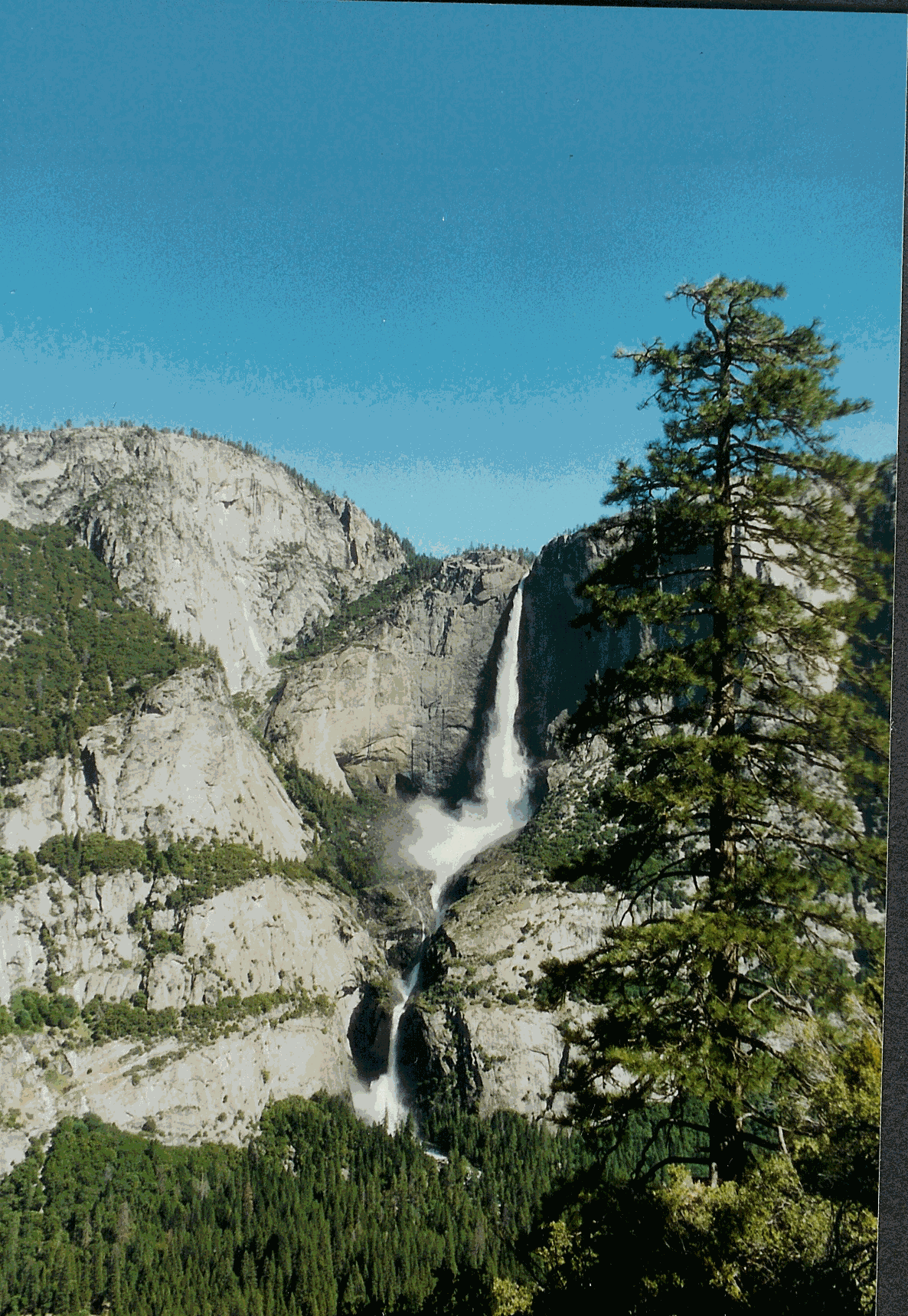
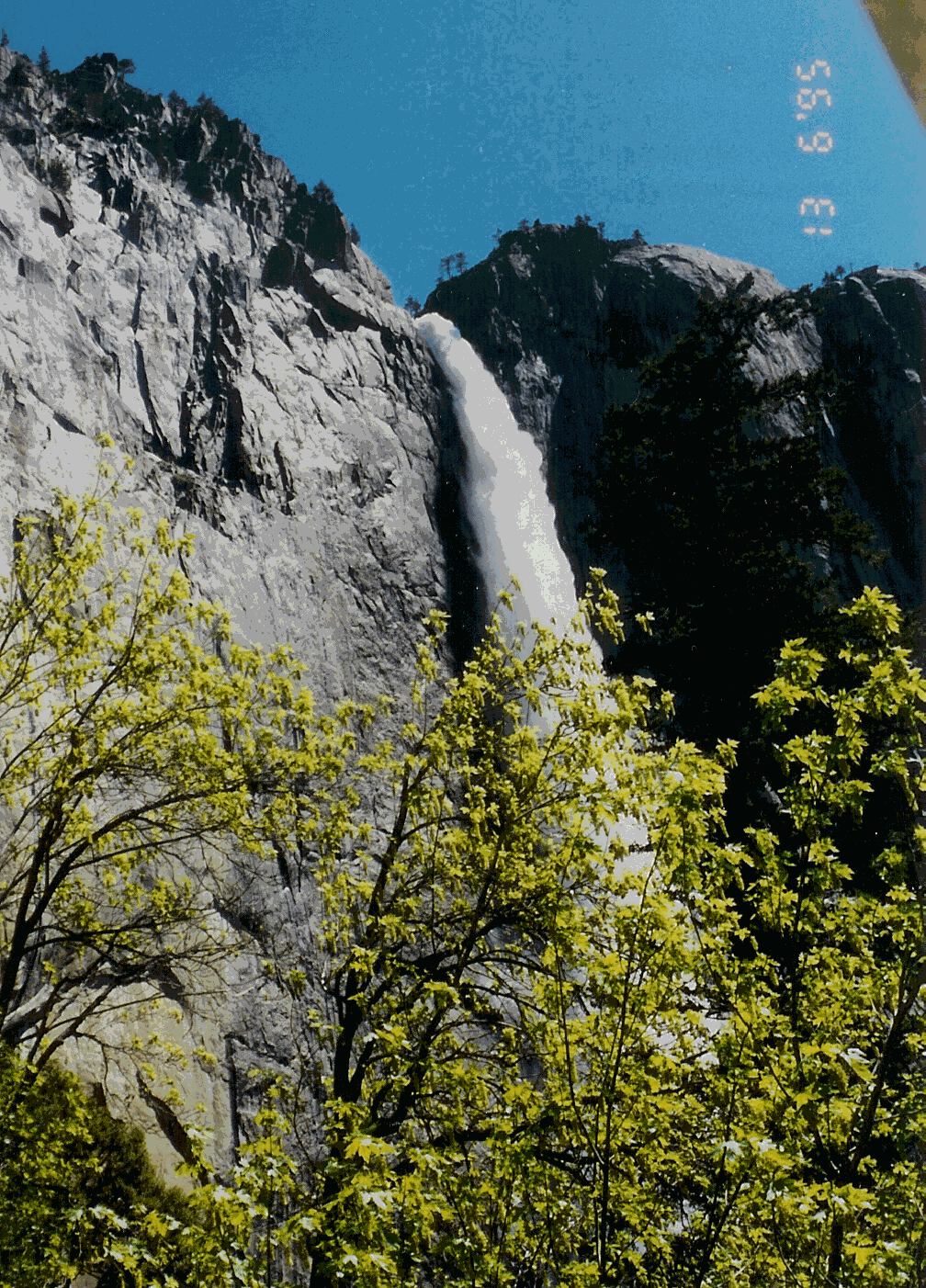
Yosemite Falls, top to bottom
Upper Yosemite Falls
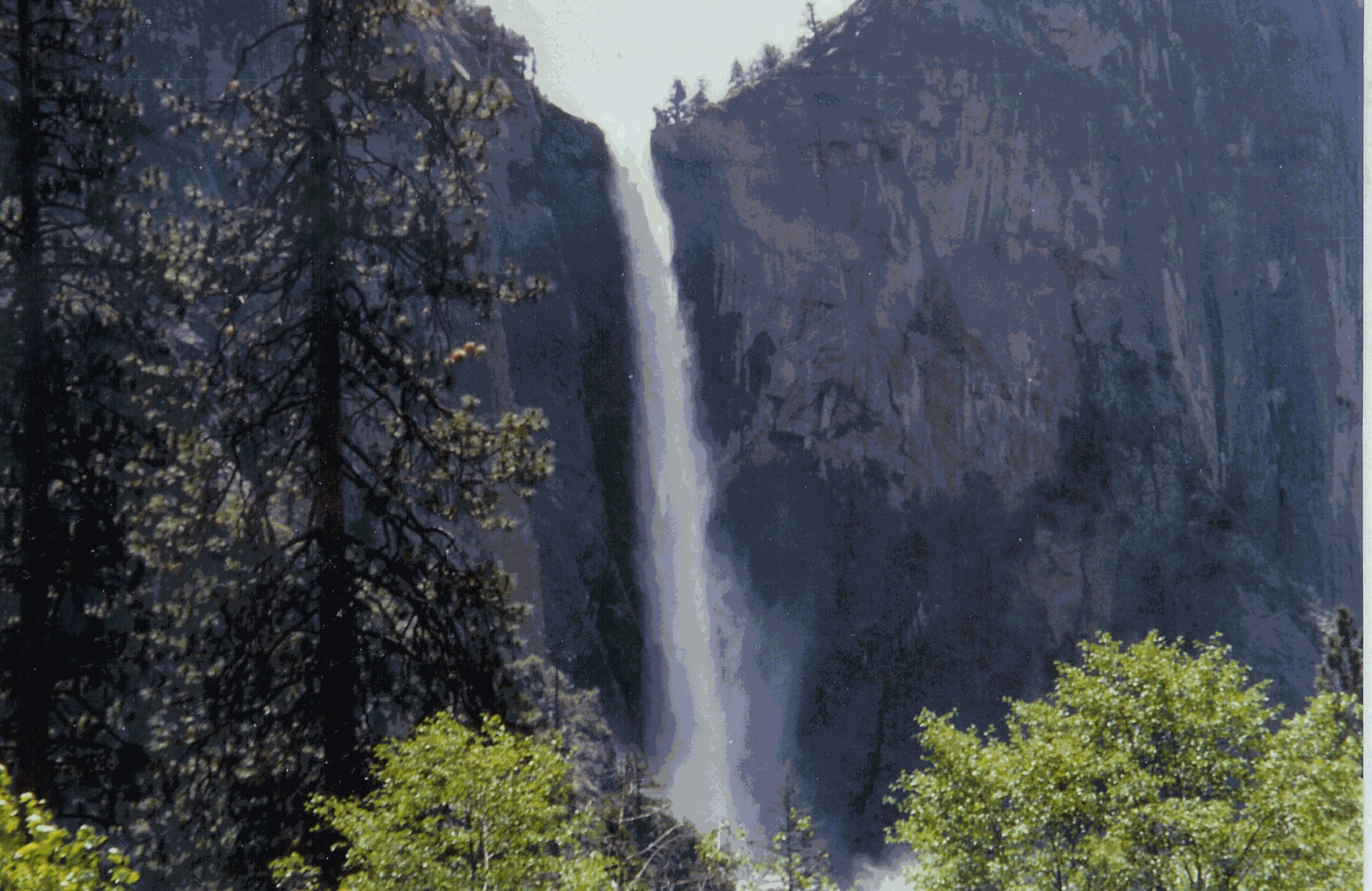
Bridalvale Falls
In 1992, again on a trip south, I had back surgery.In 1993 I had an Aortal Aneurism repaired. .In 2002 I had a benign tumor removed, along with part of my stomach.Along the way, Barbara had a hip replacement, several broken bones, and some extreme heart rhythm problems. More recently, her back has been getting steadily worse, for which she has recently had extensive surgery.In 2004 we started to think a little about moving back south to be closer to our children, and other family members. Nothing came of that at the time. It took one more stint in the hospital for me, for yet another heart procedure, to make me know that I no longer looked forward to all the tasks that I had to do to keep the "homestead" in working order. Time to move! As I write these final paragraphs of this very long story, I am sitting at my computer in the office of our rented home in Westlake Village. Barbara is very slowly recovering from her back surgery. We are very comfortable. Even though we are in the middle of a large city, we hardly know it. Weíre surrounded by large trees, and there is very little "city noise." Lots of family members nearby. How good does it get?"BLOOM WHERE YOU ARE PLANTED" I canít tell you the author of that bit of advice, but I firmly believe in it. We are blooming!
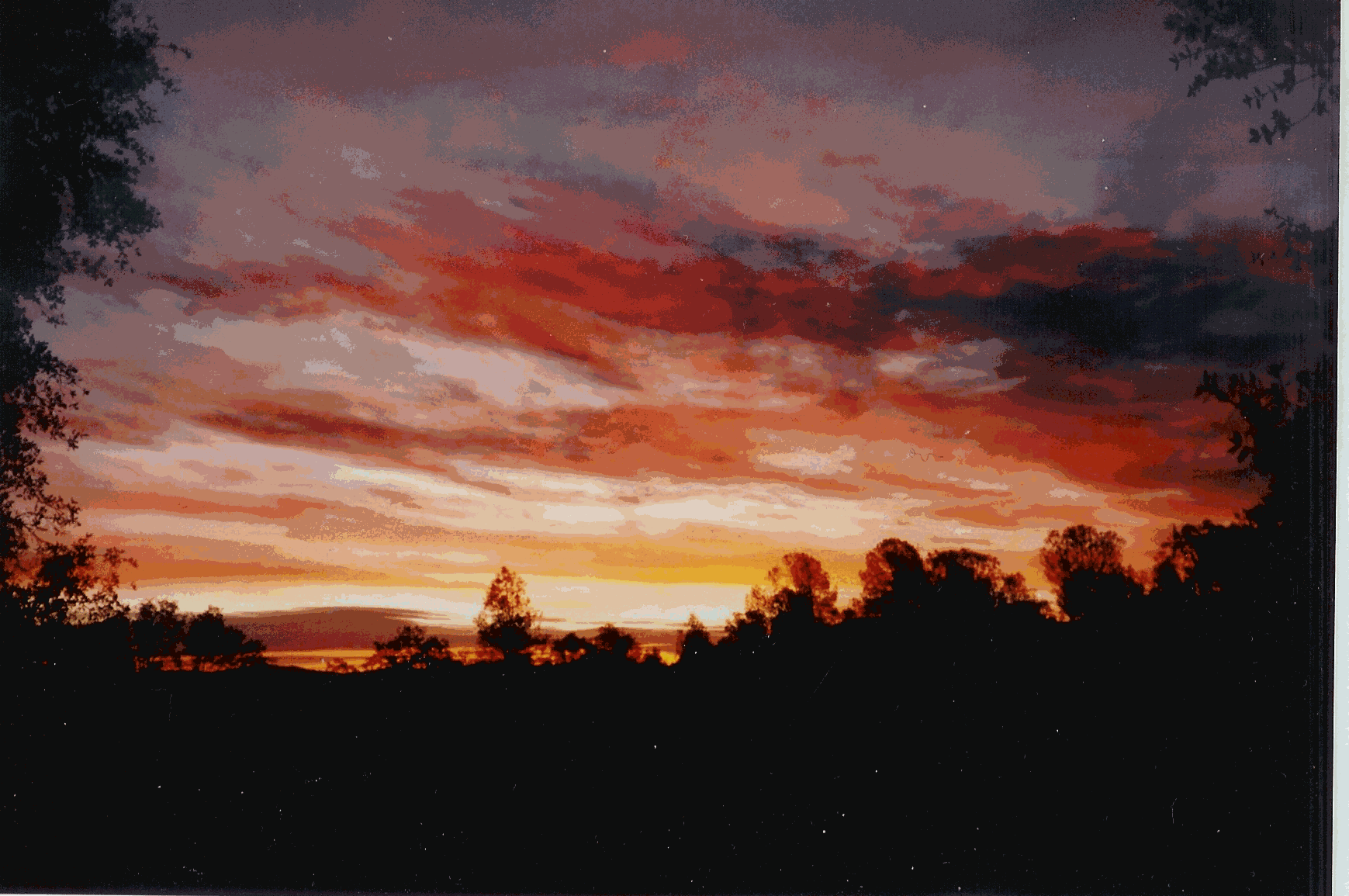
The beginning of a new day